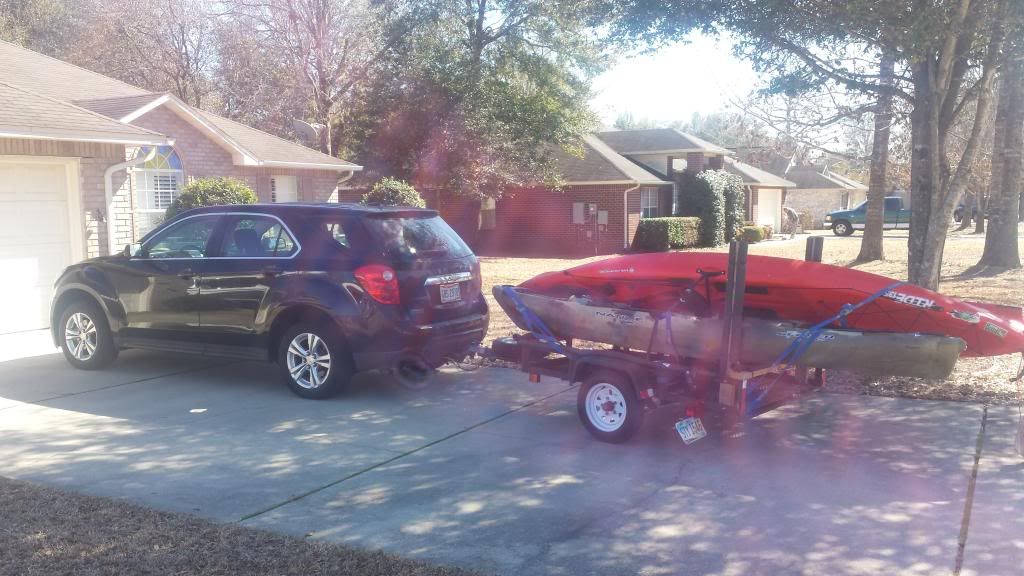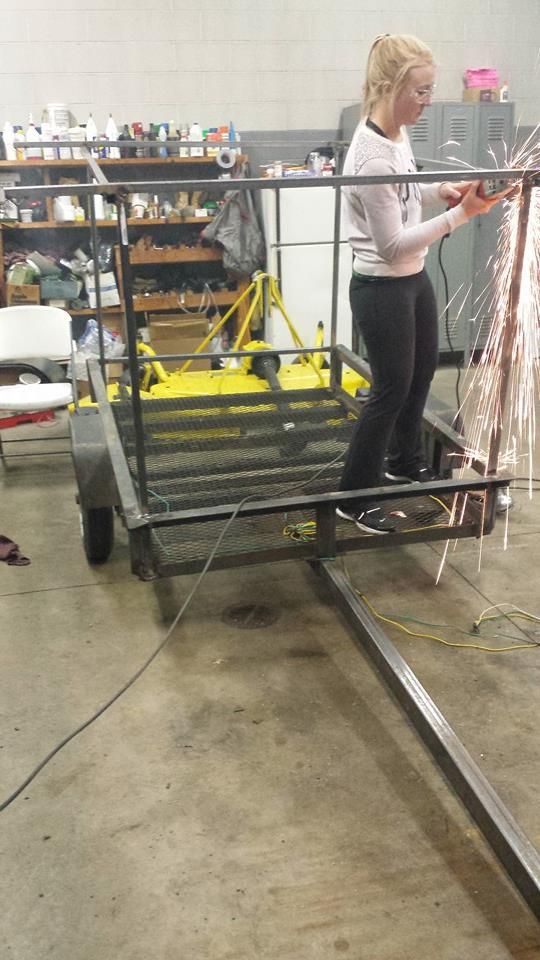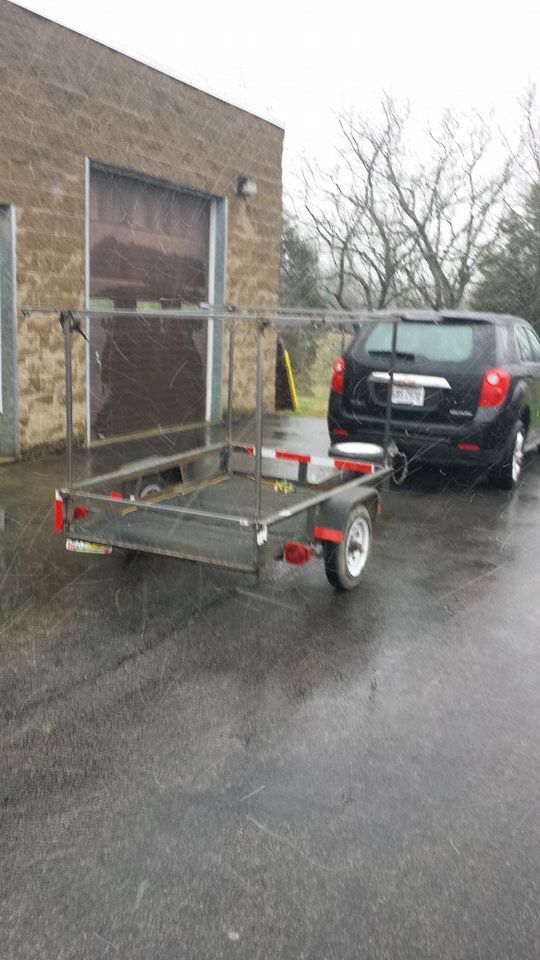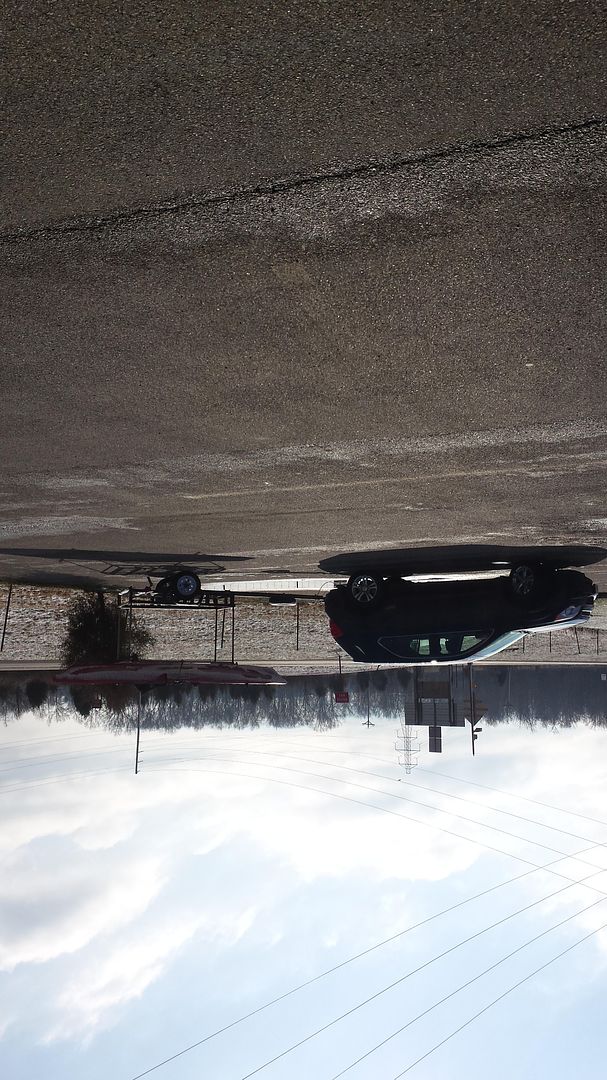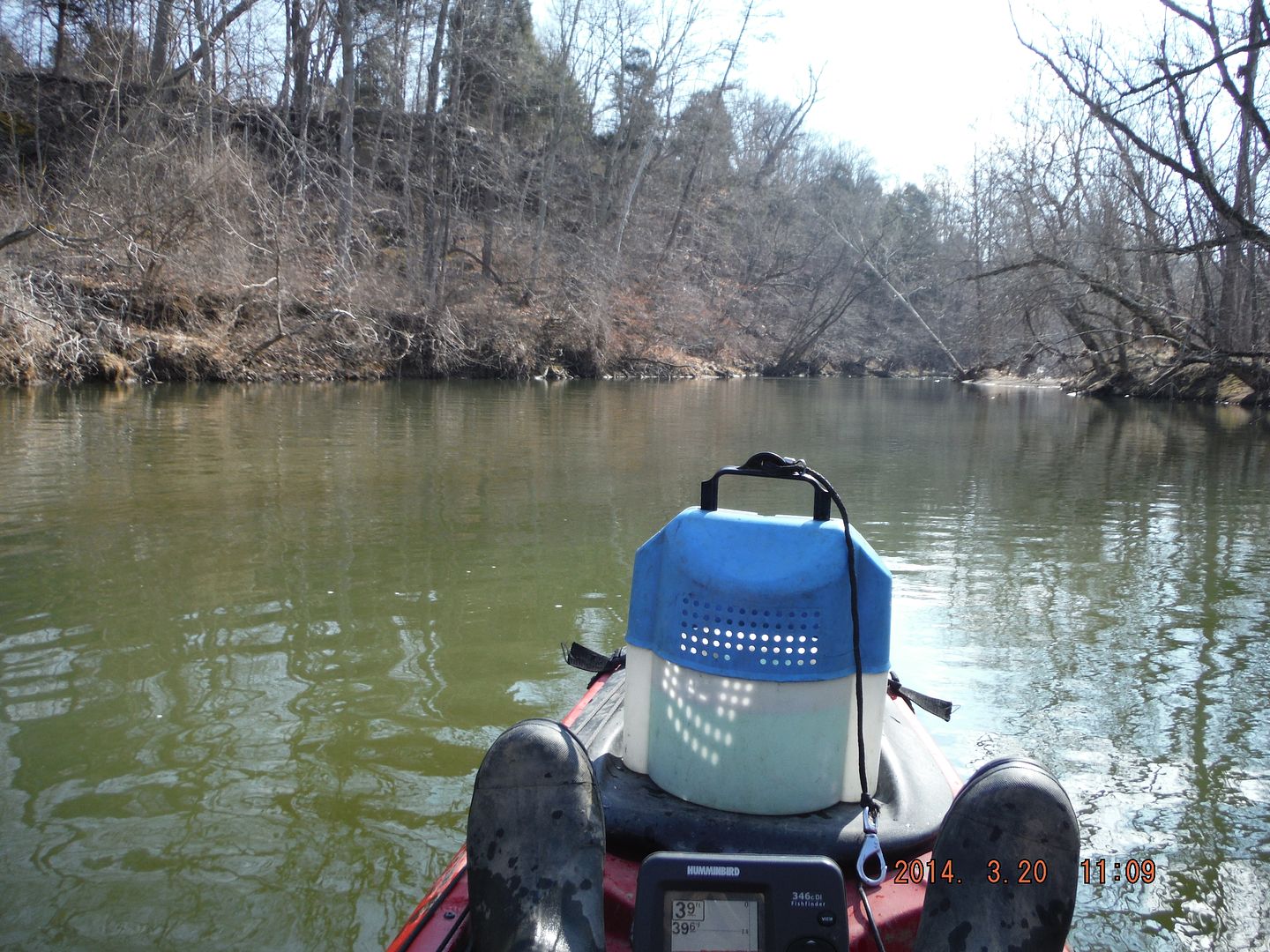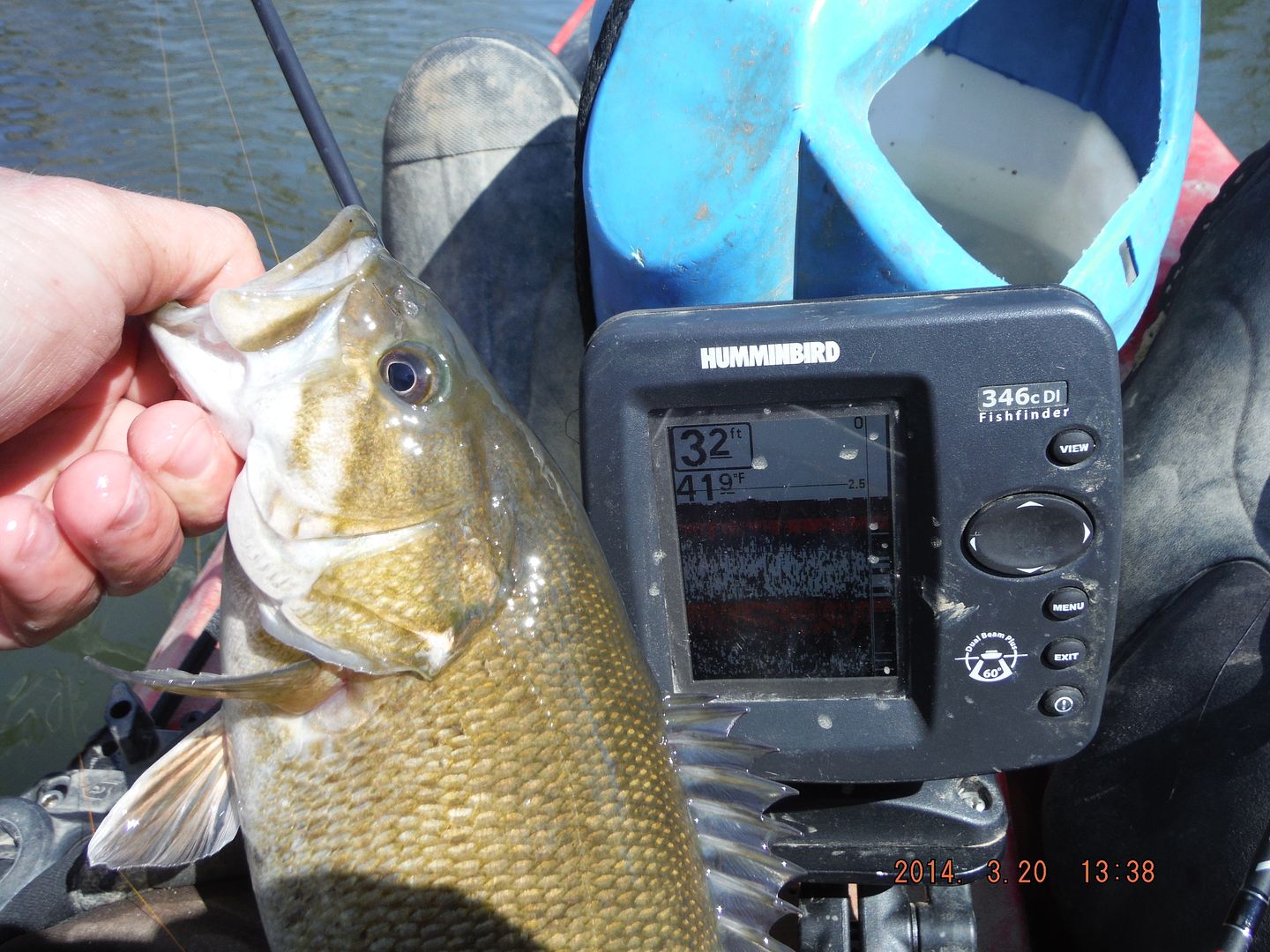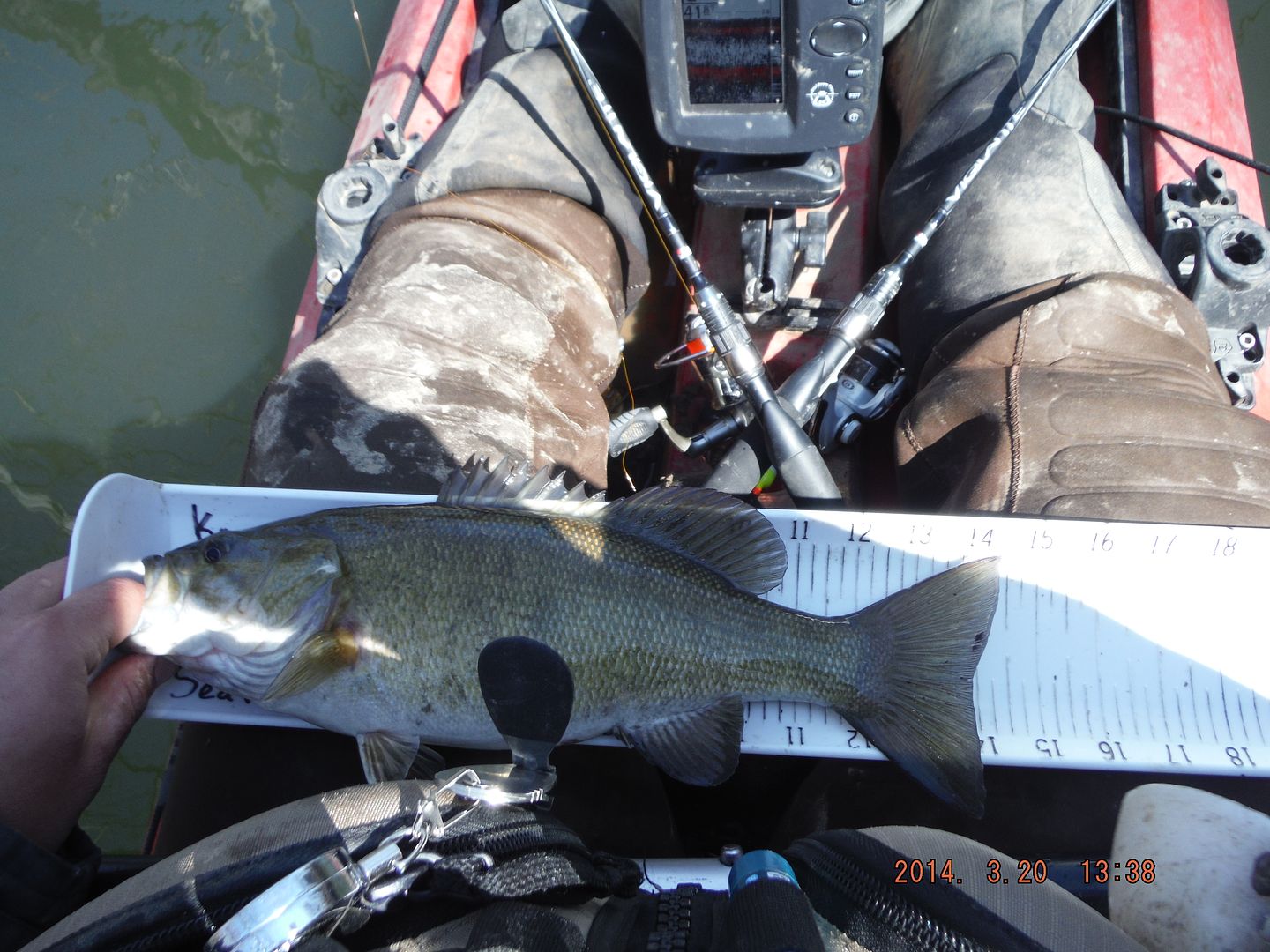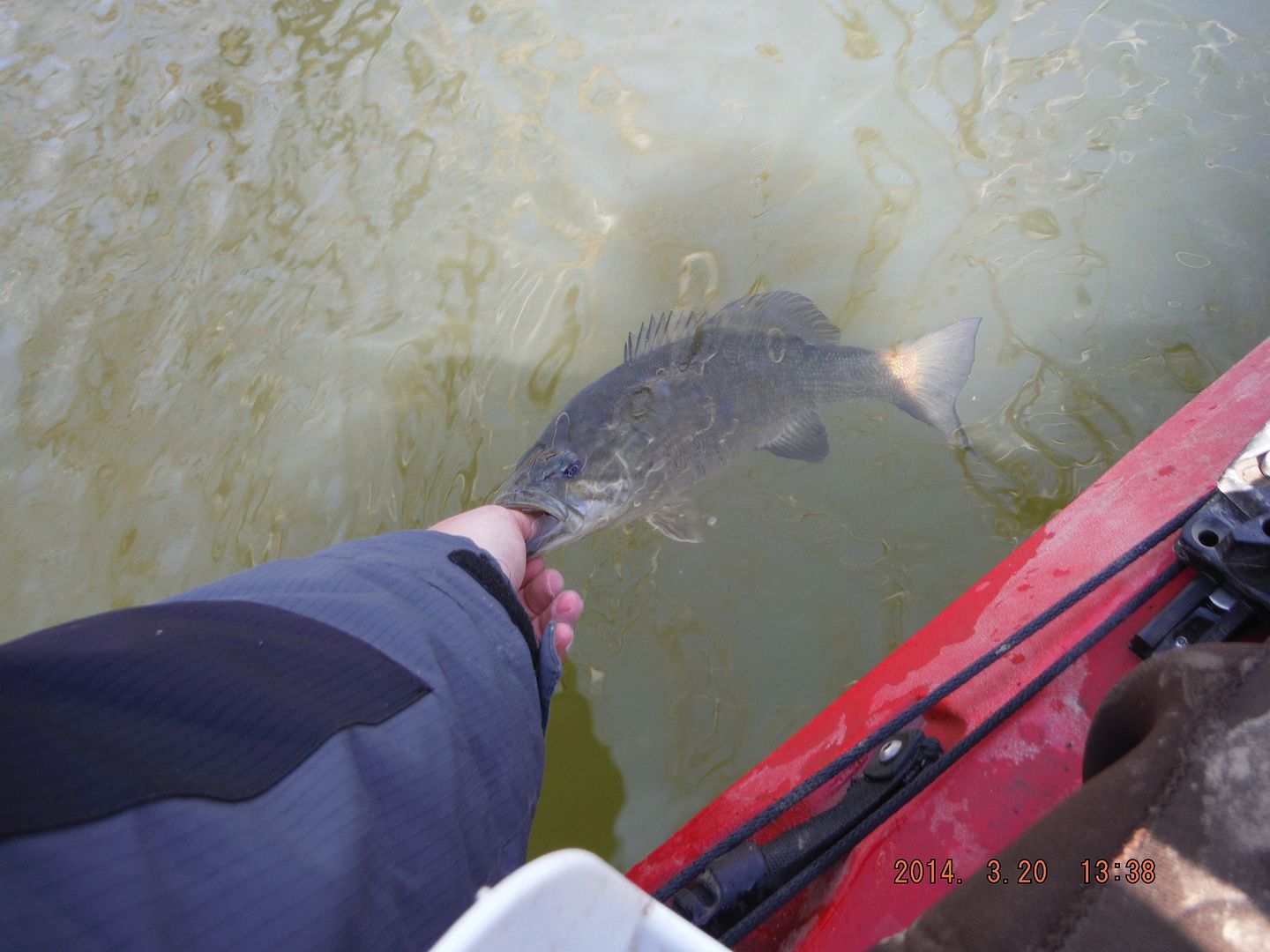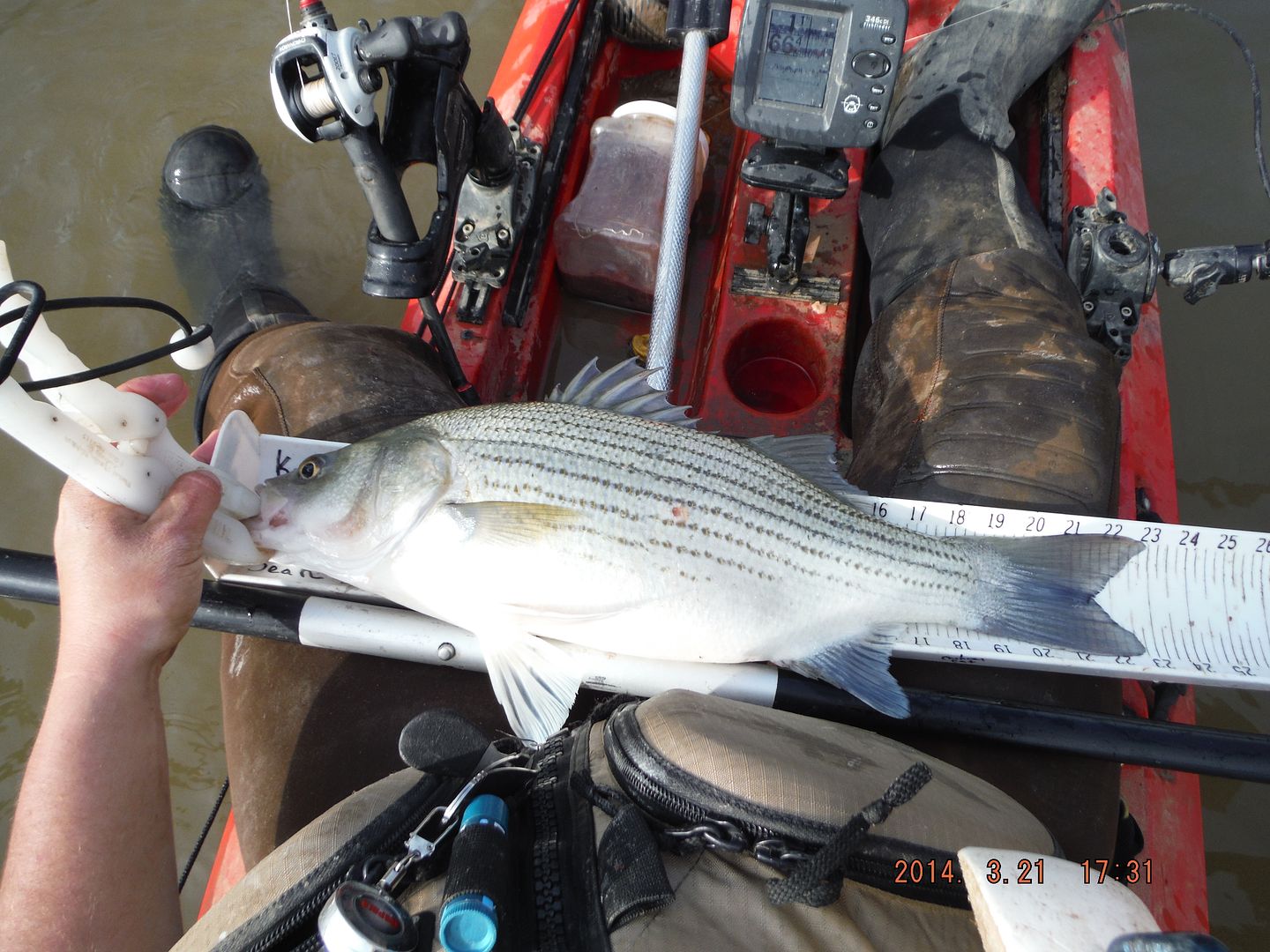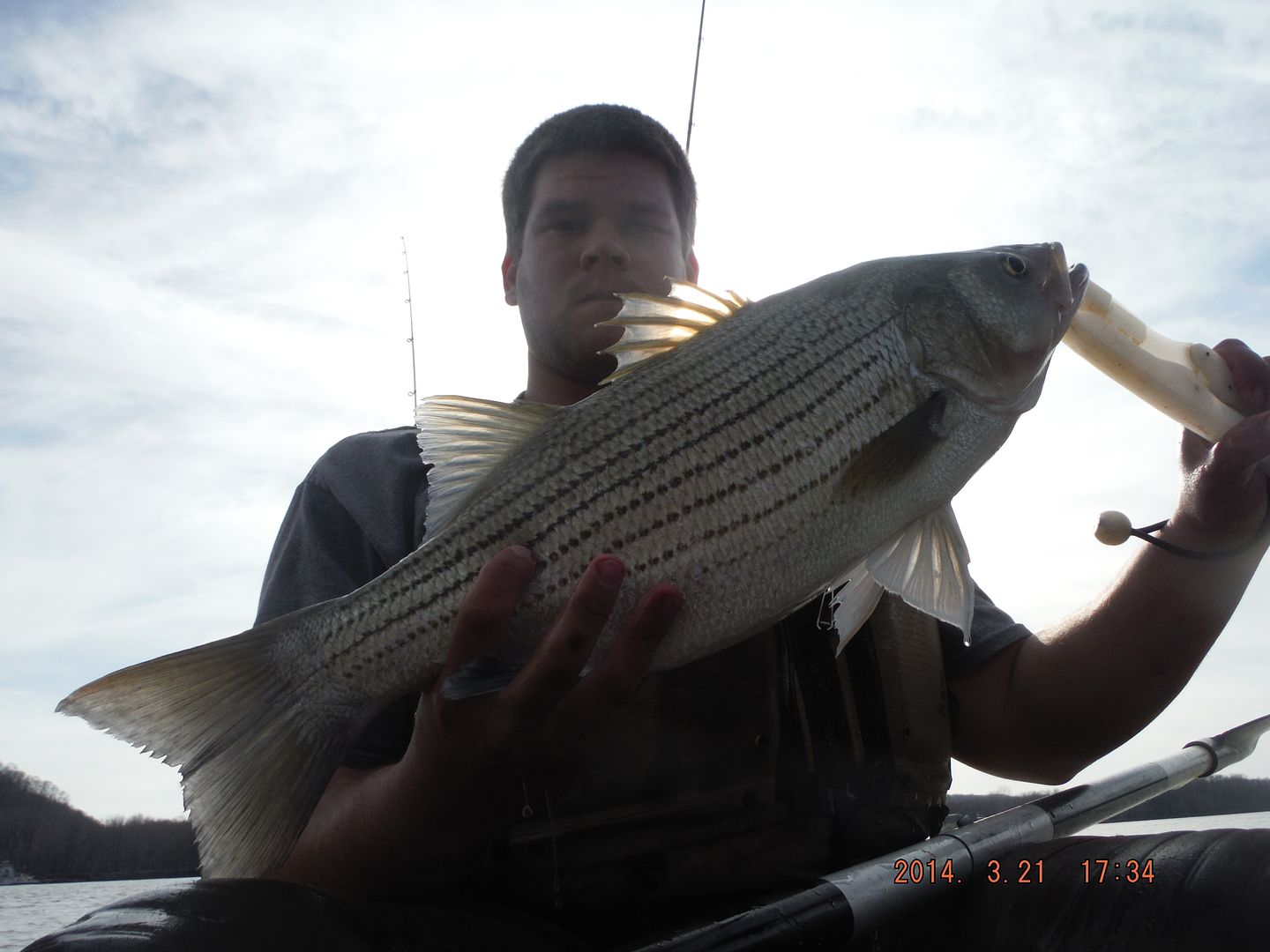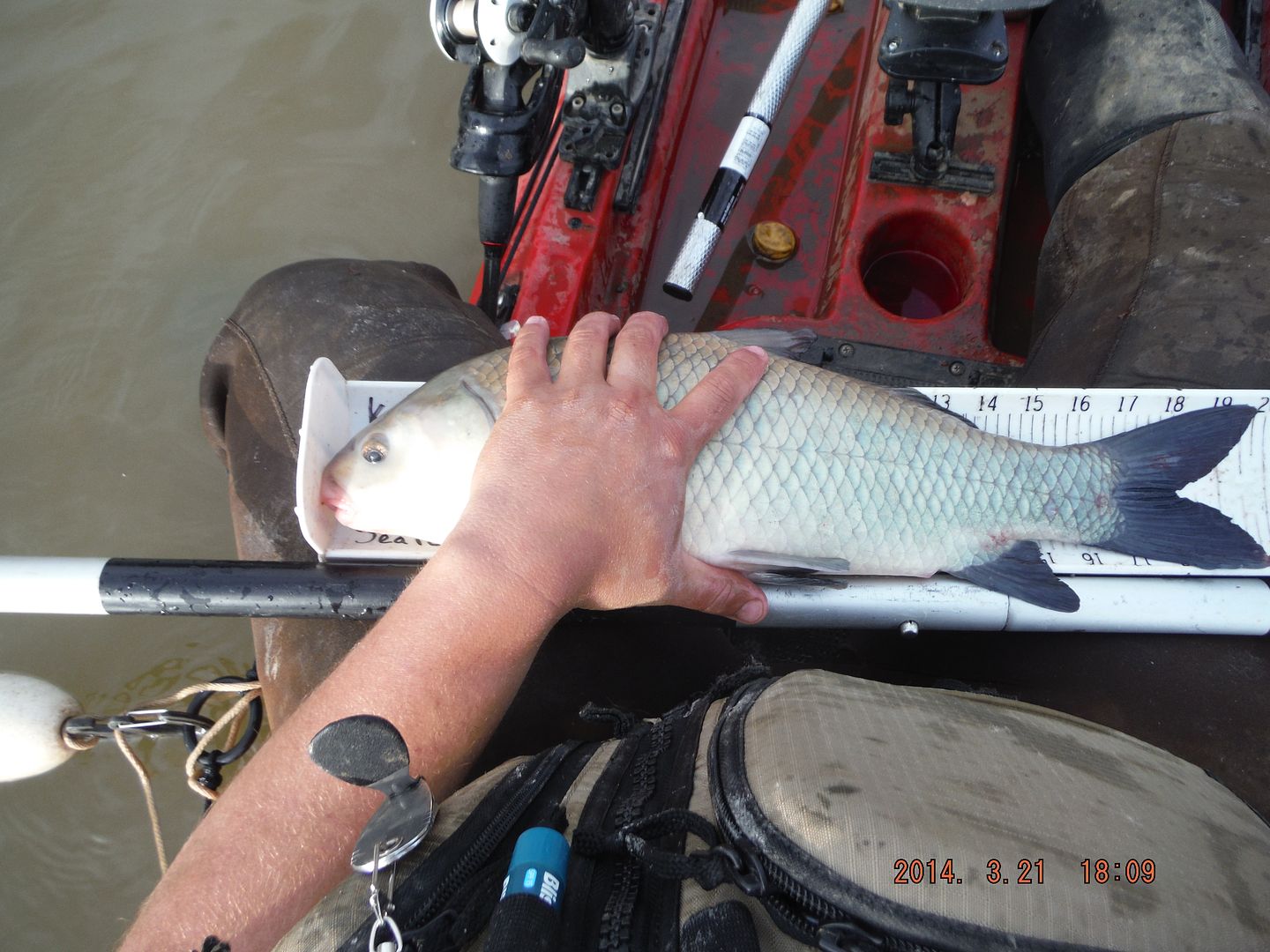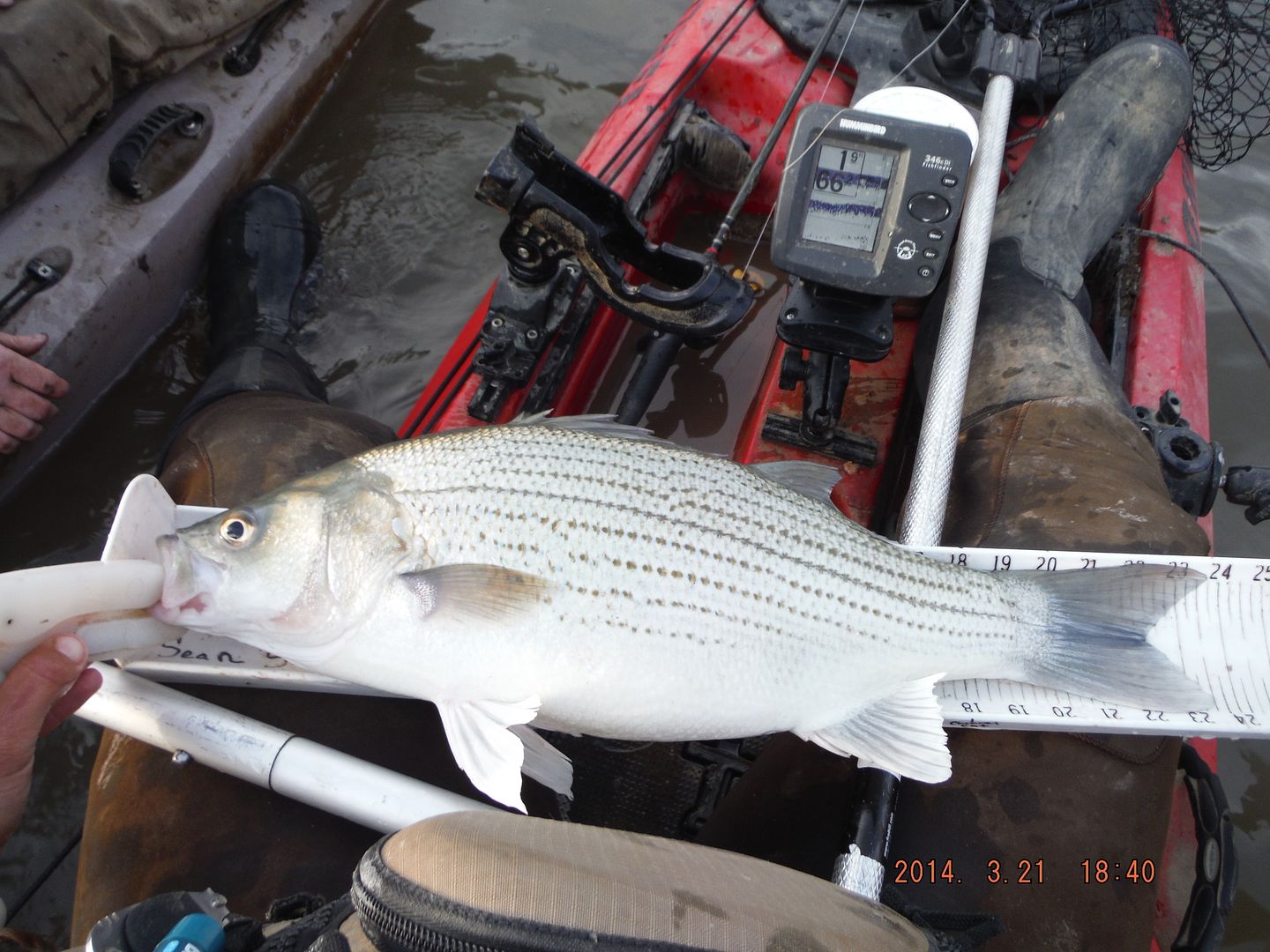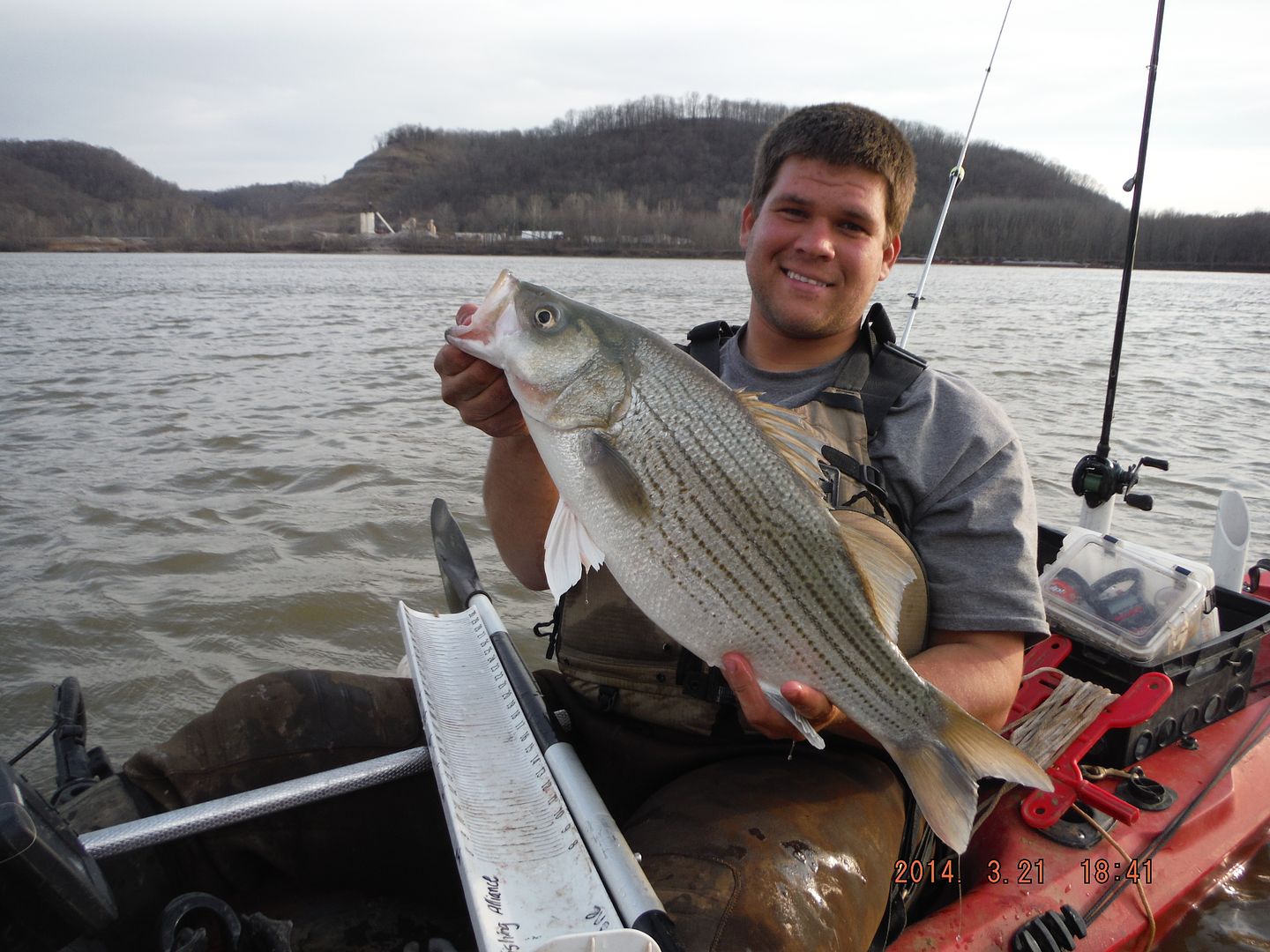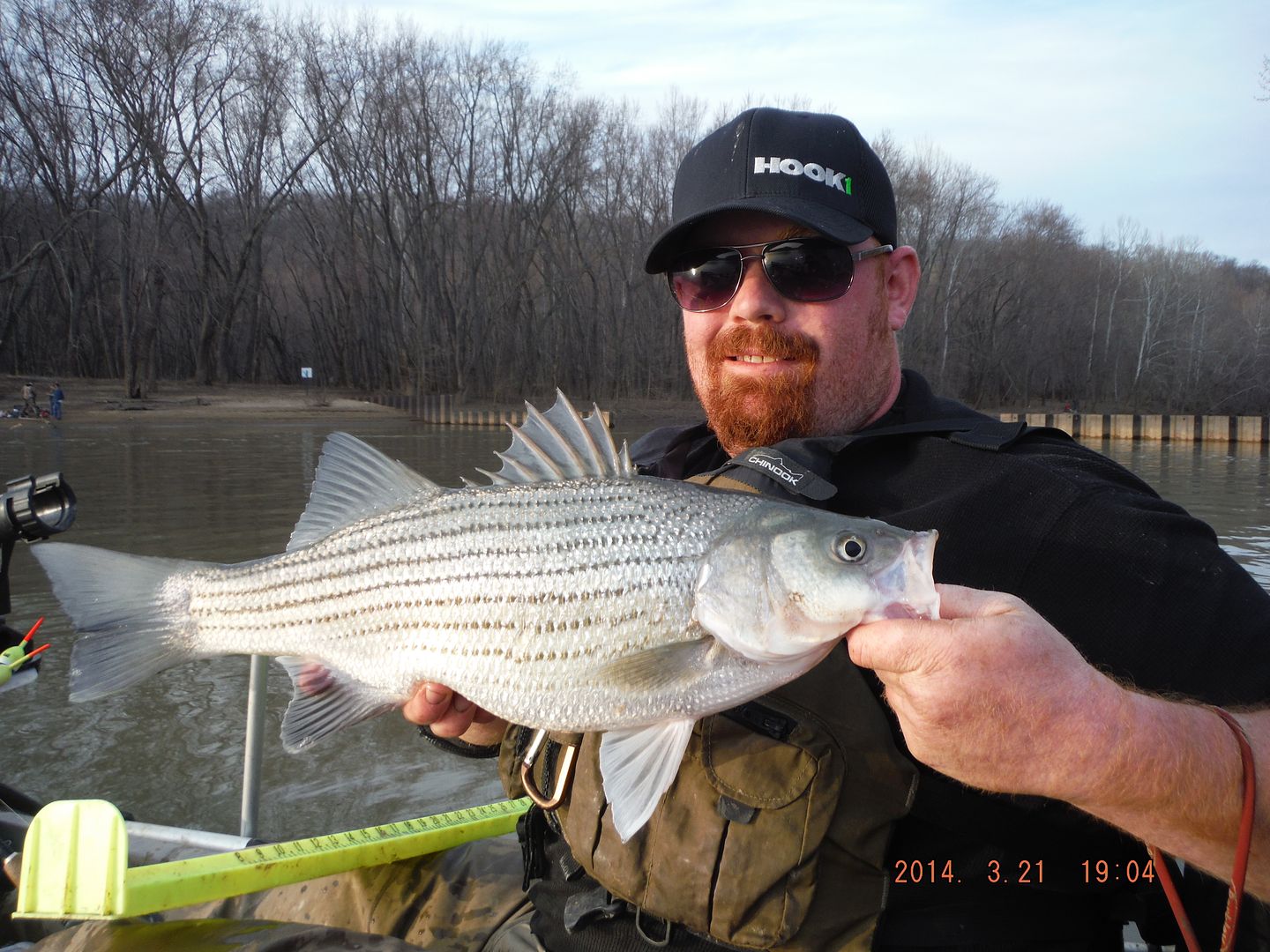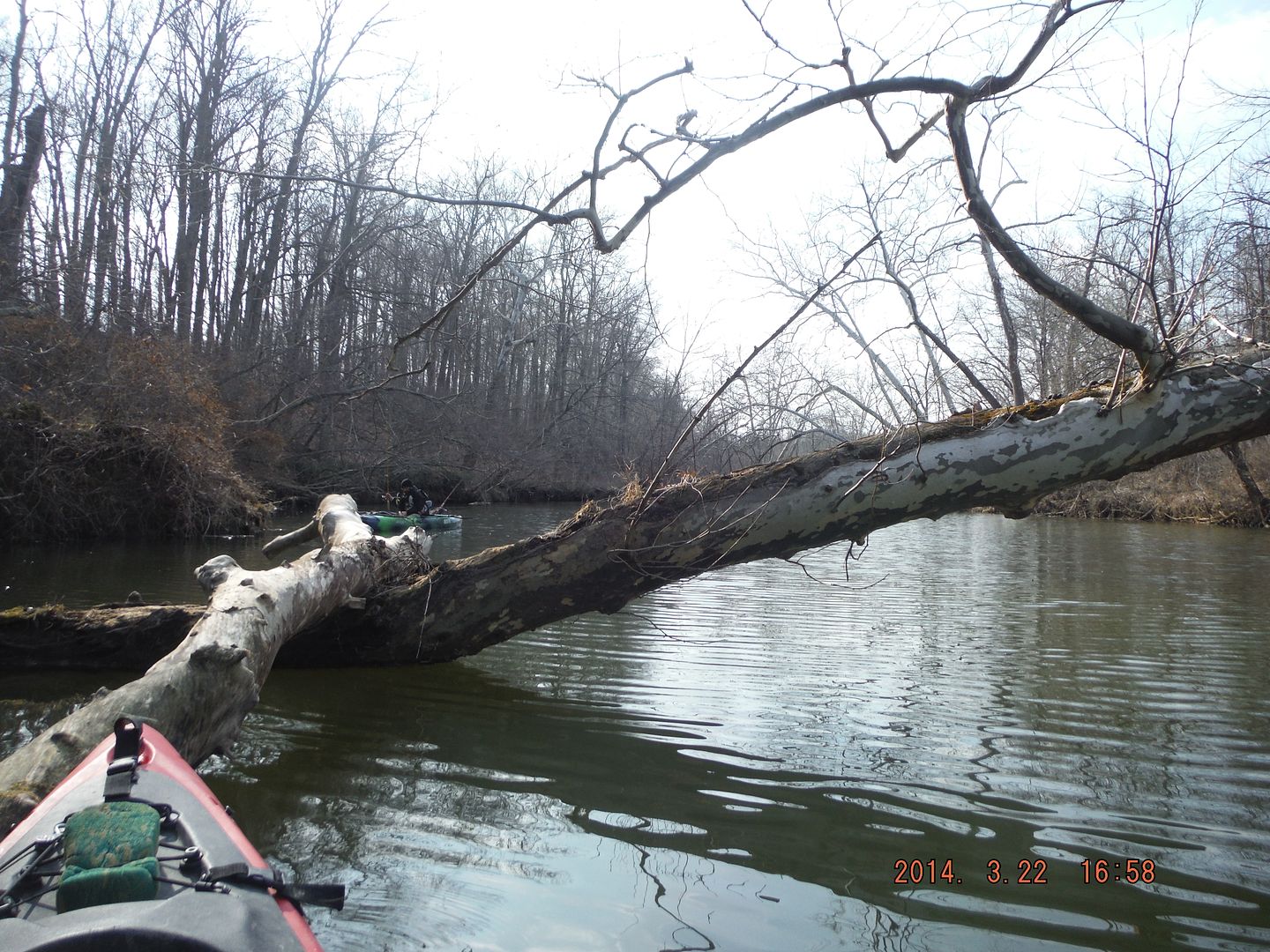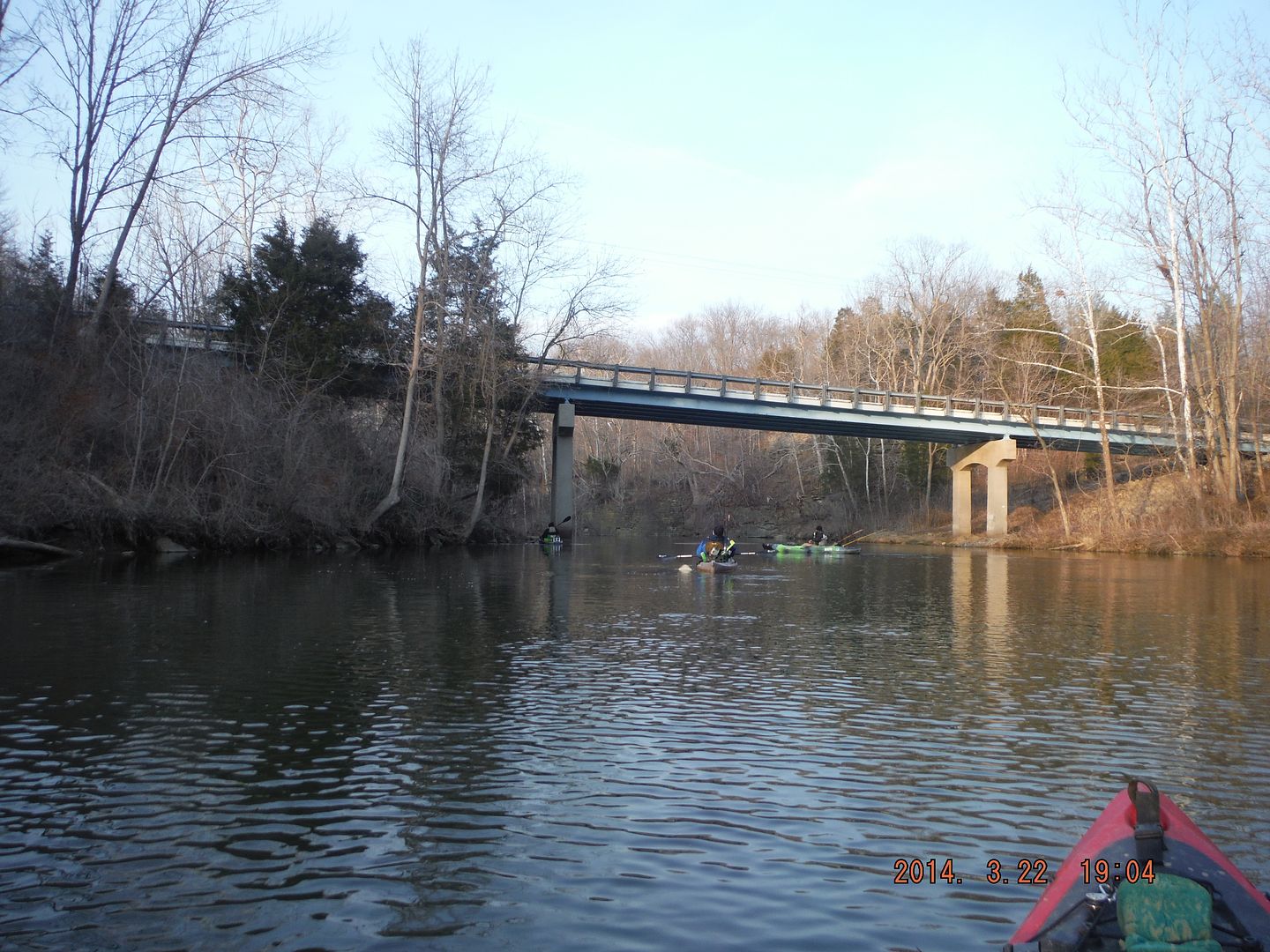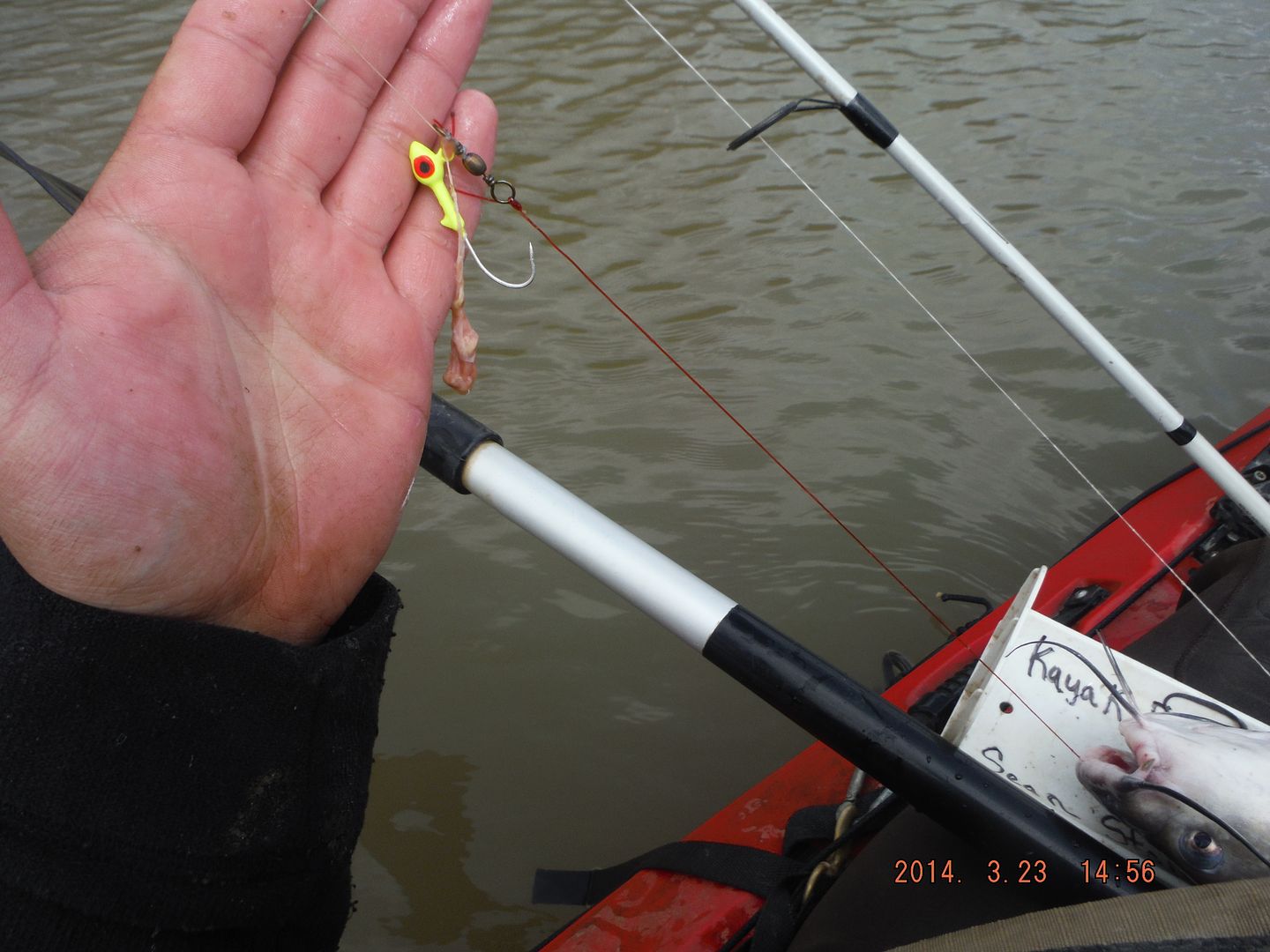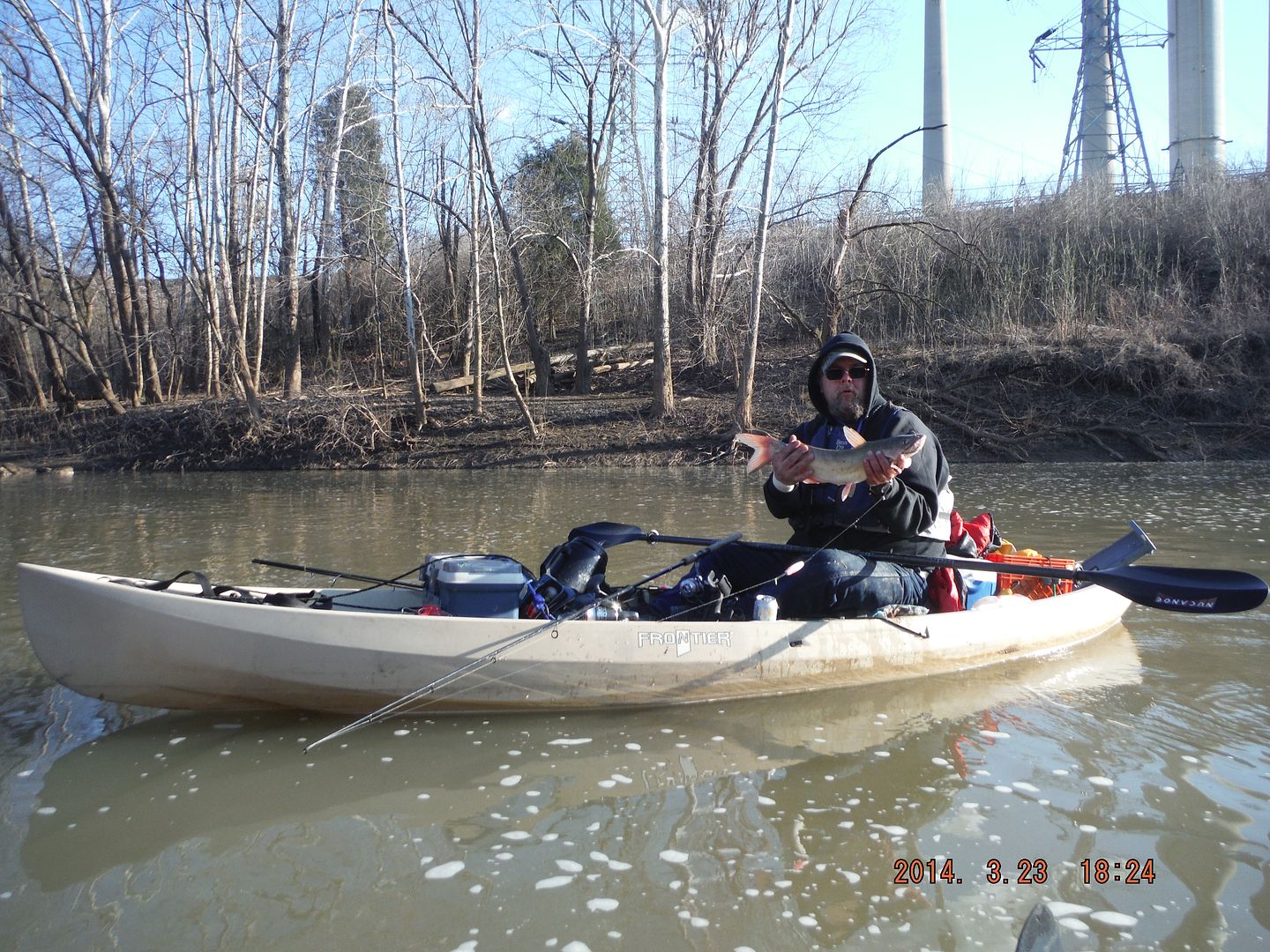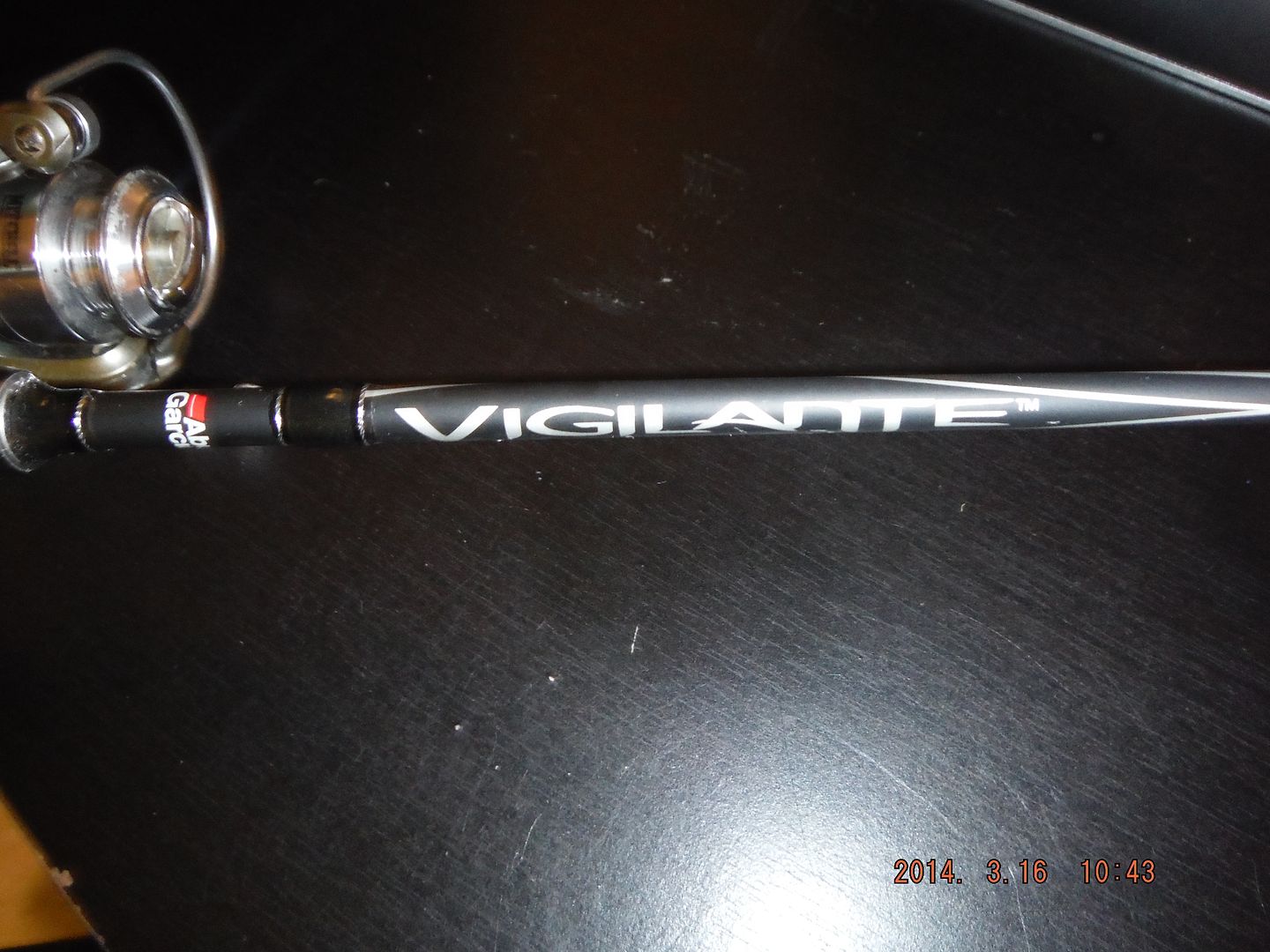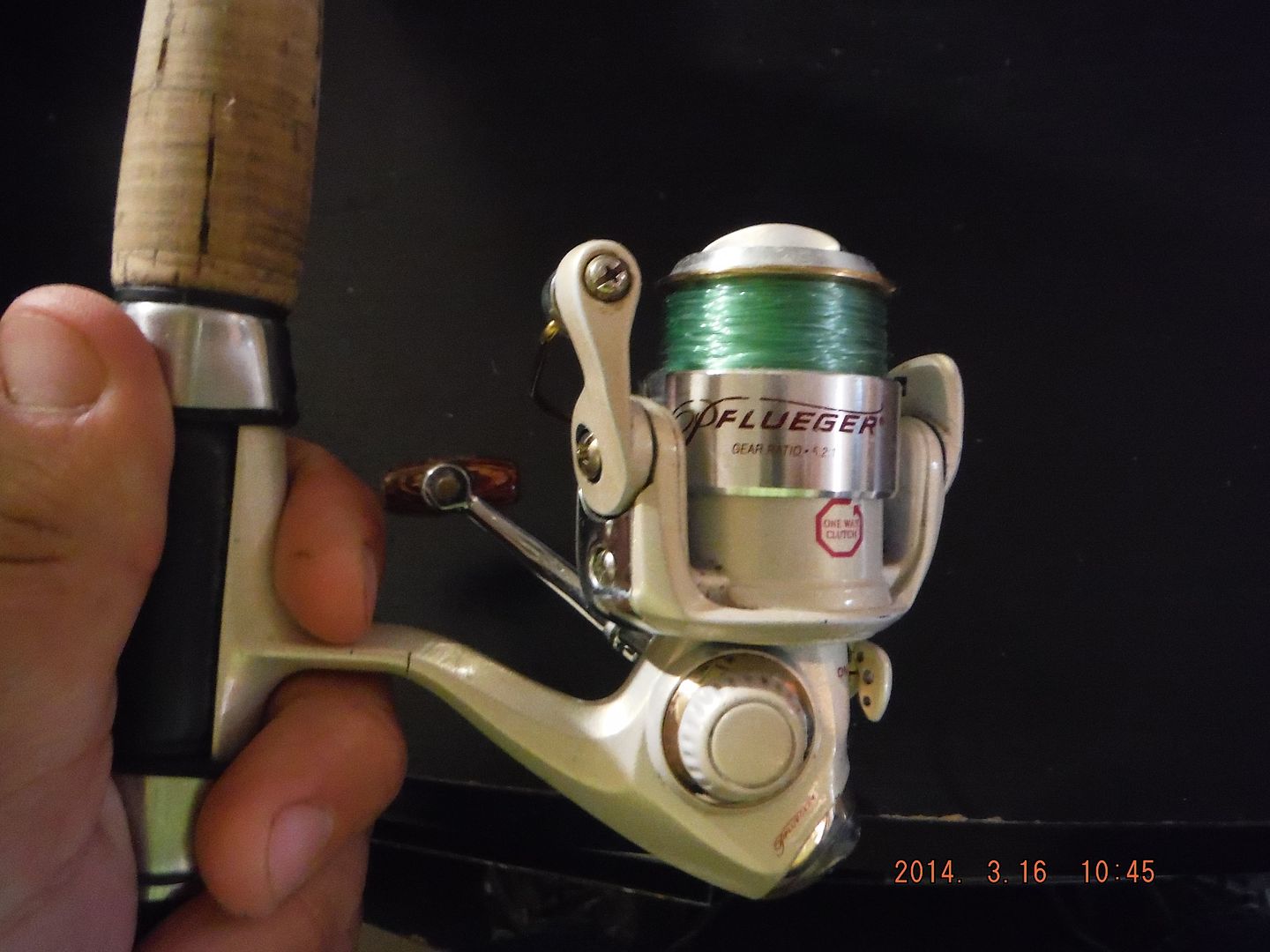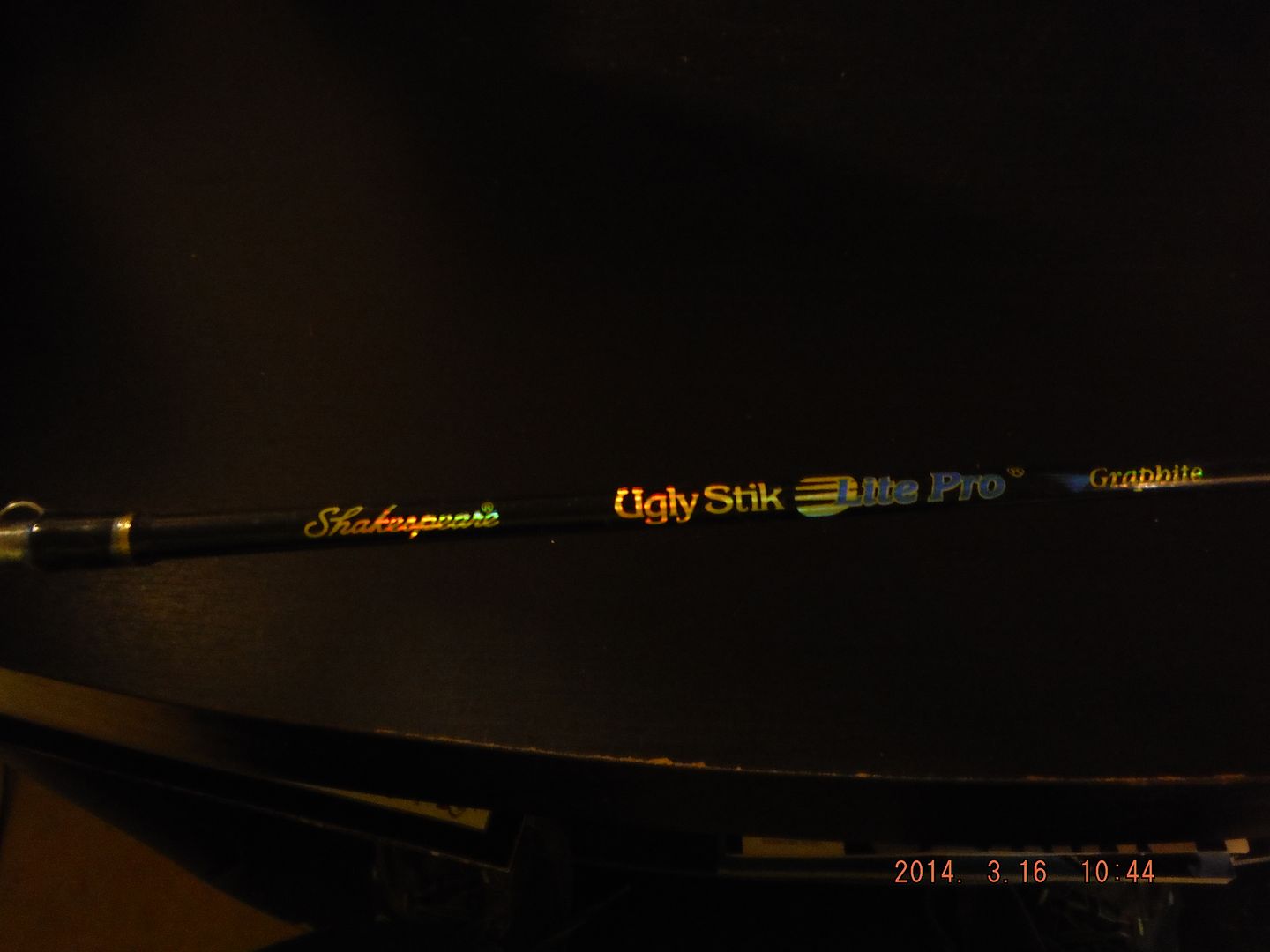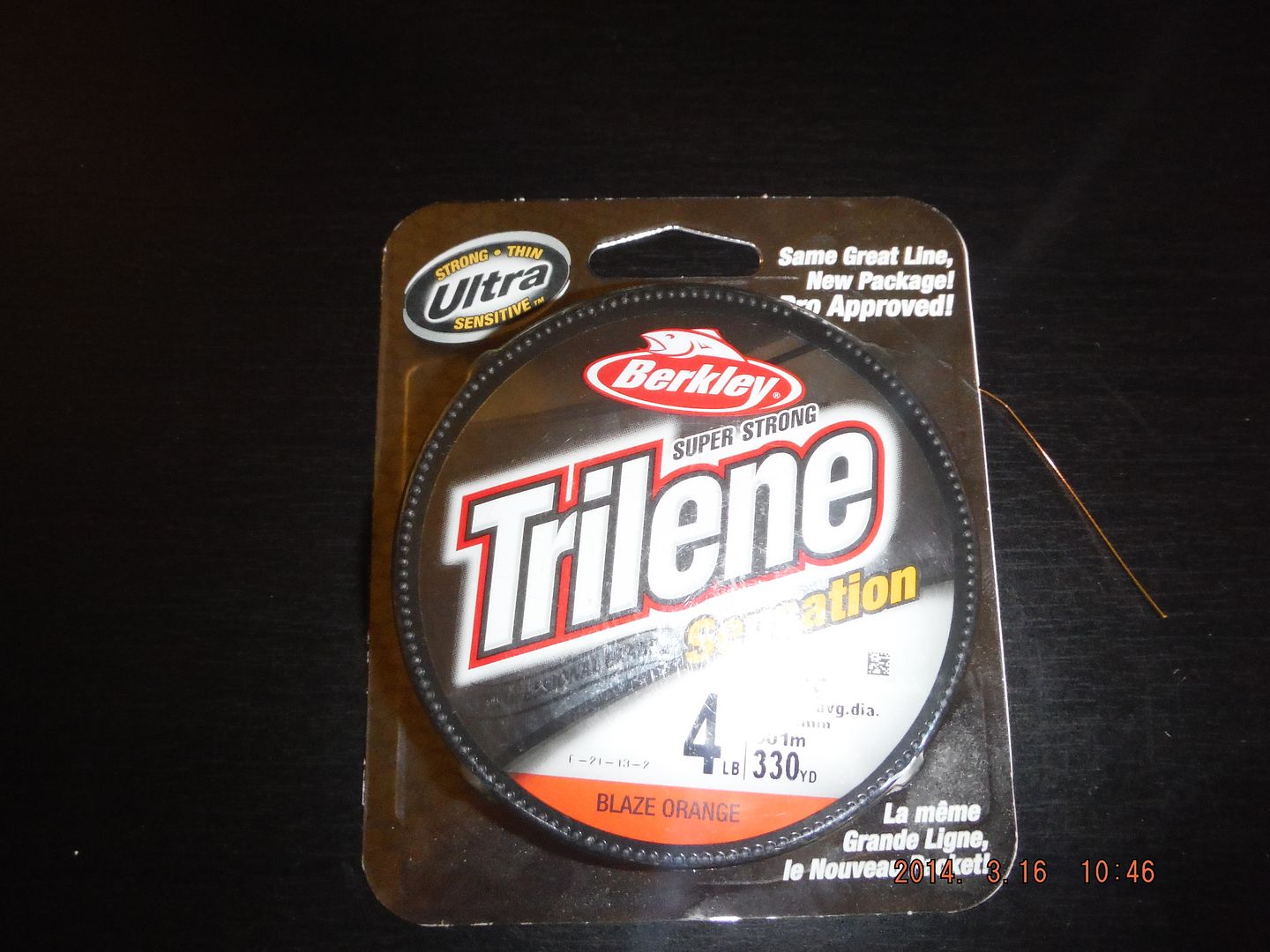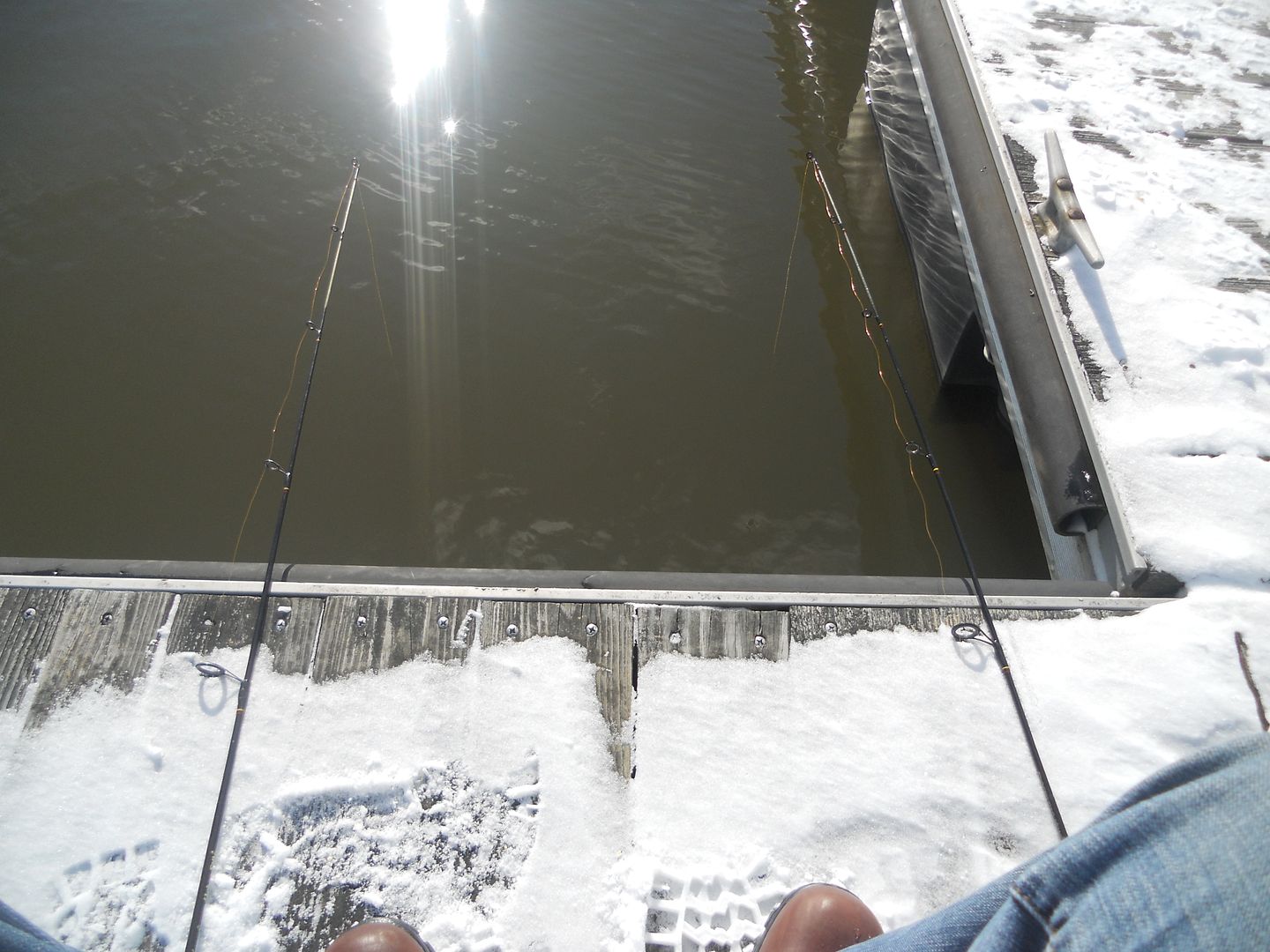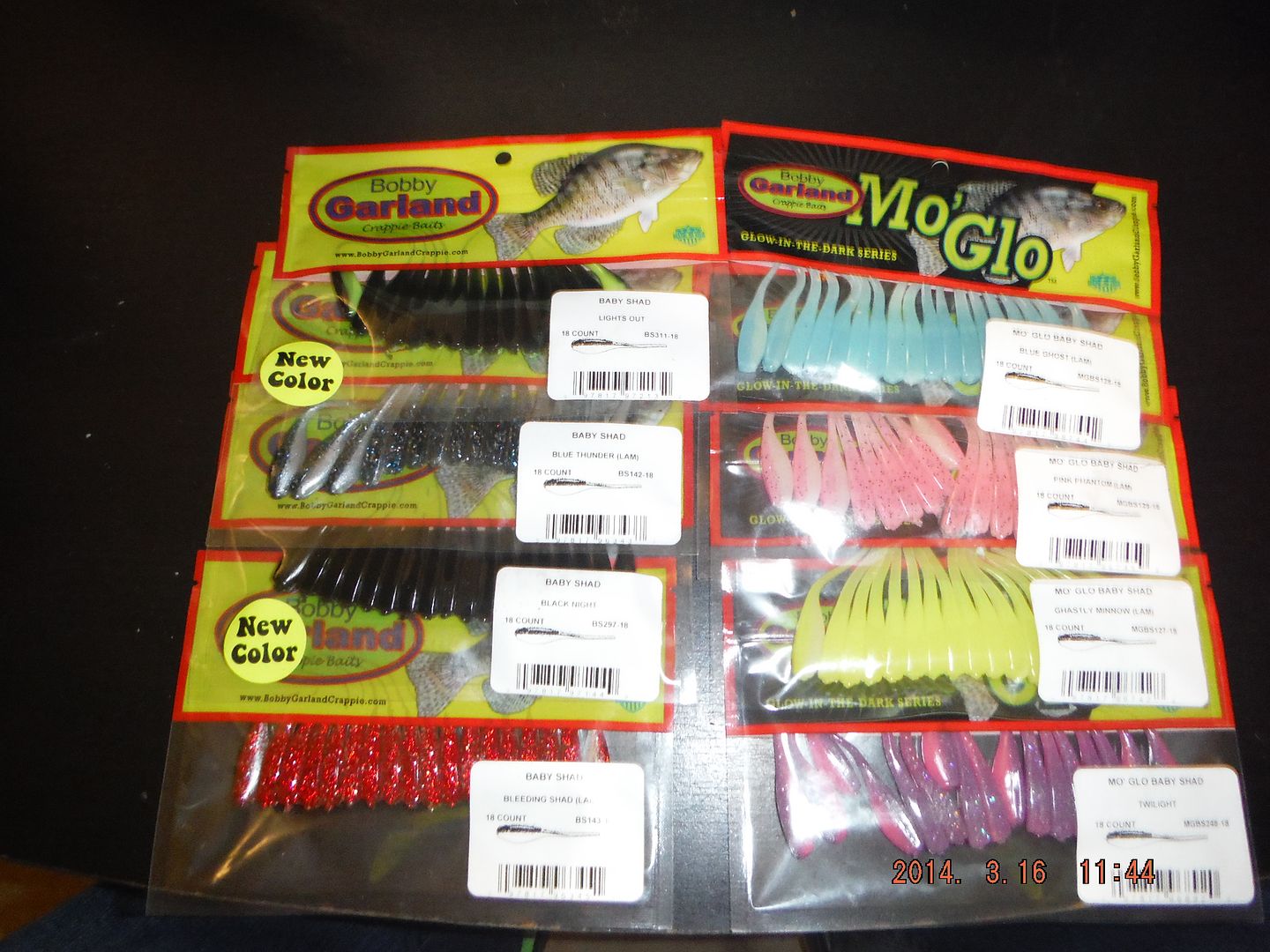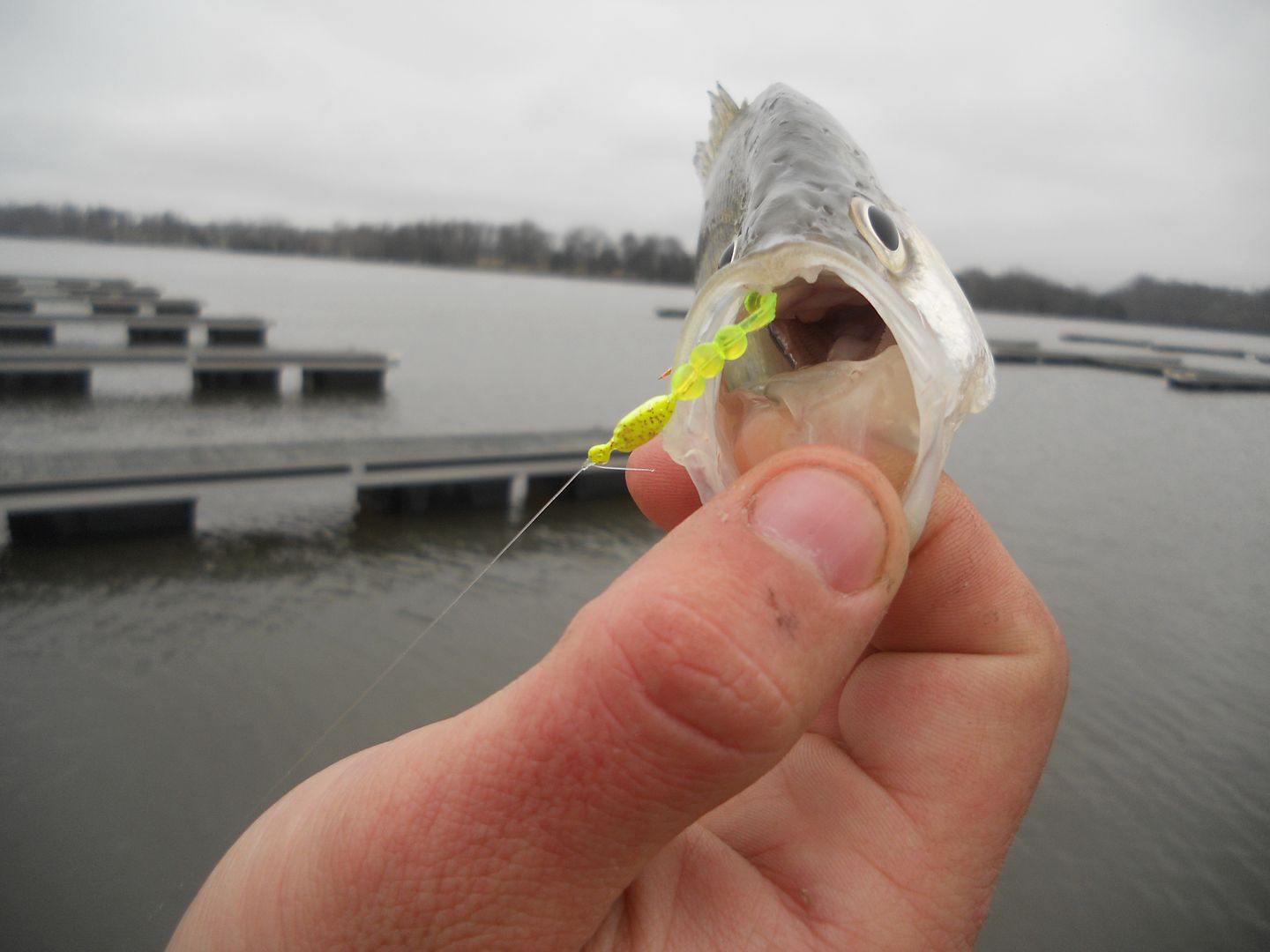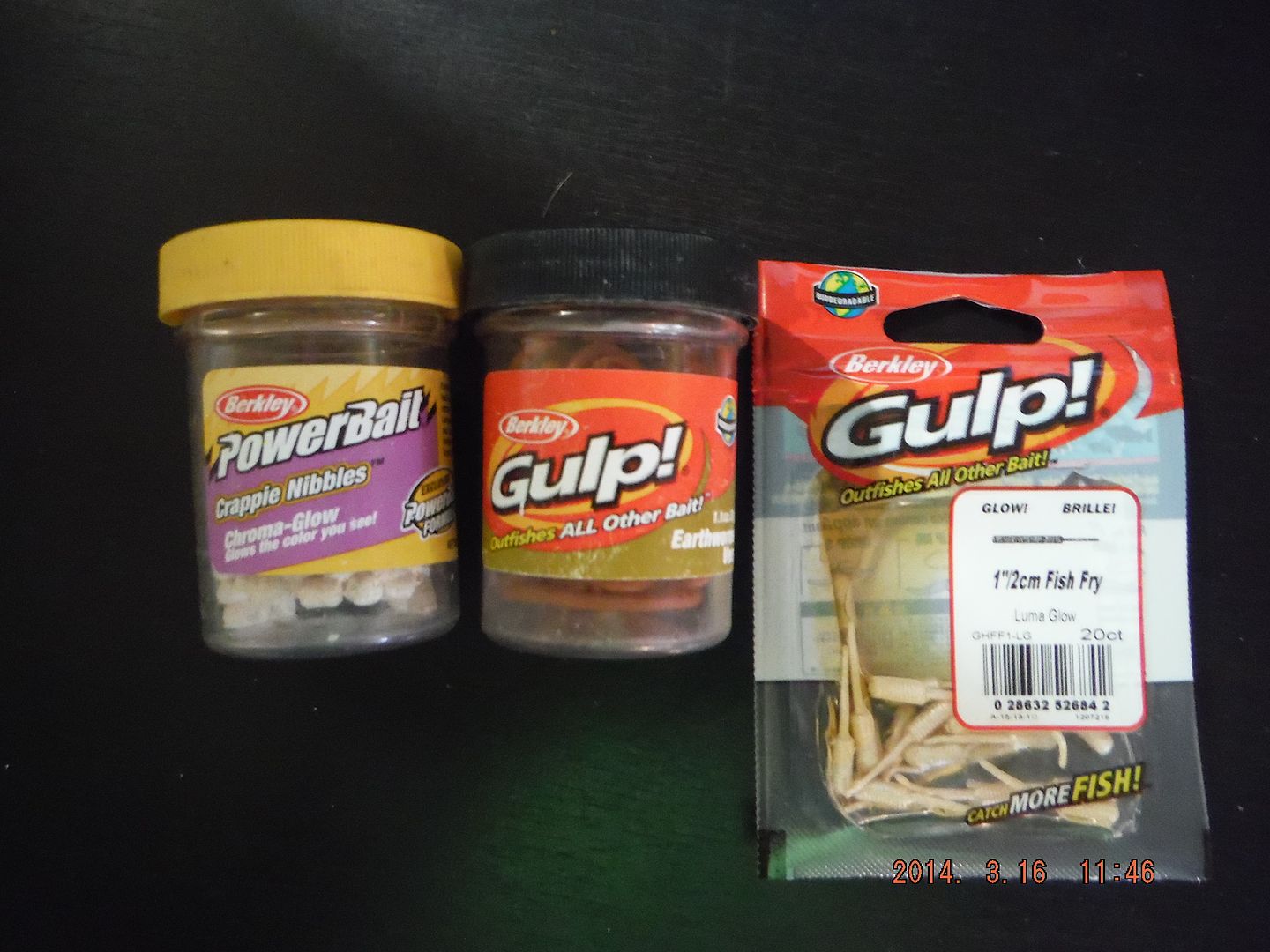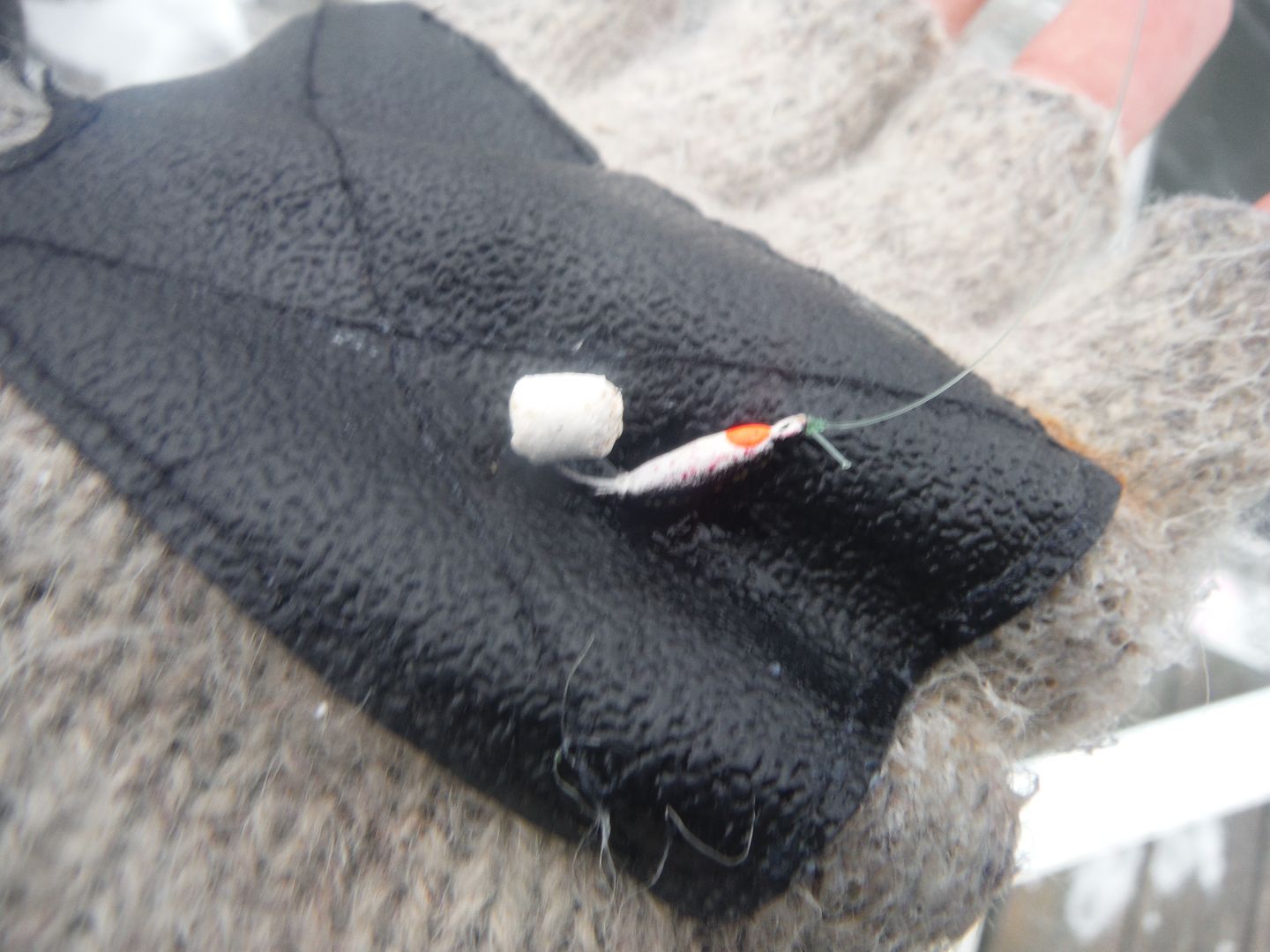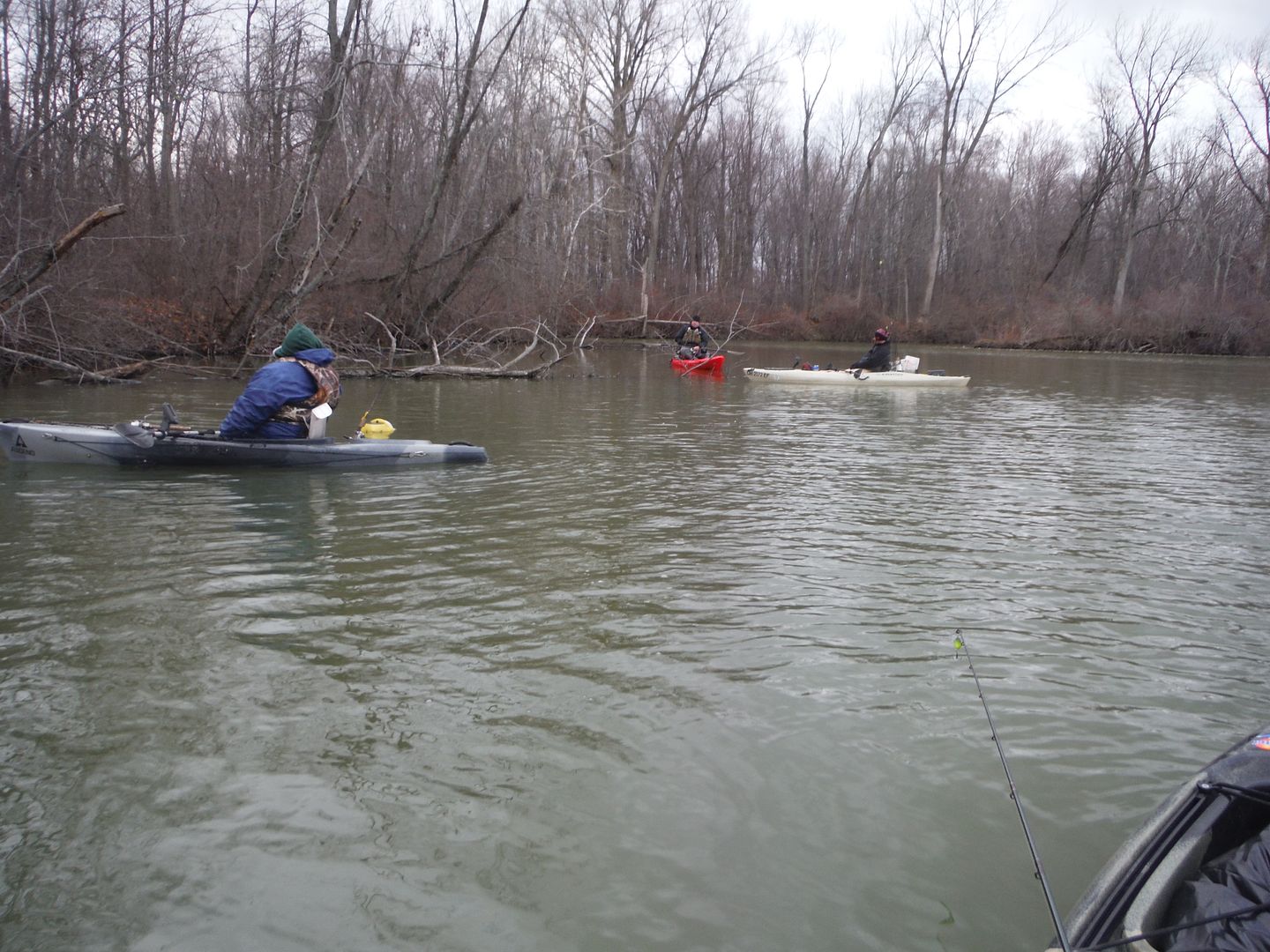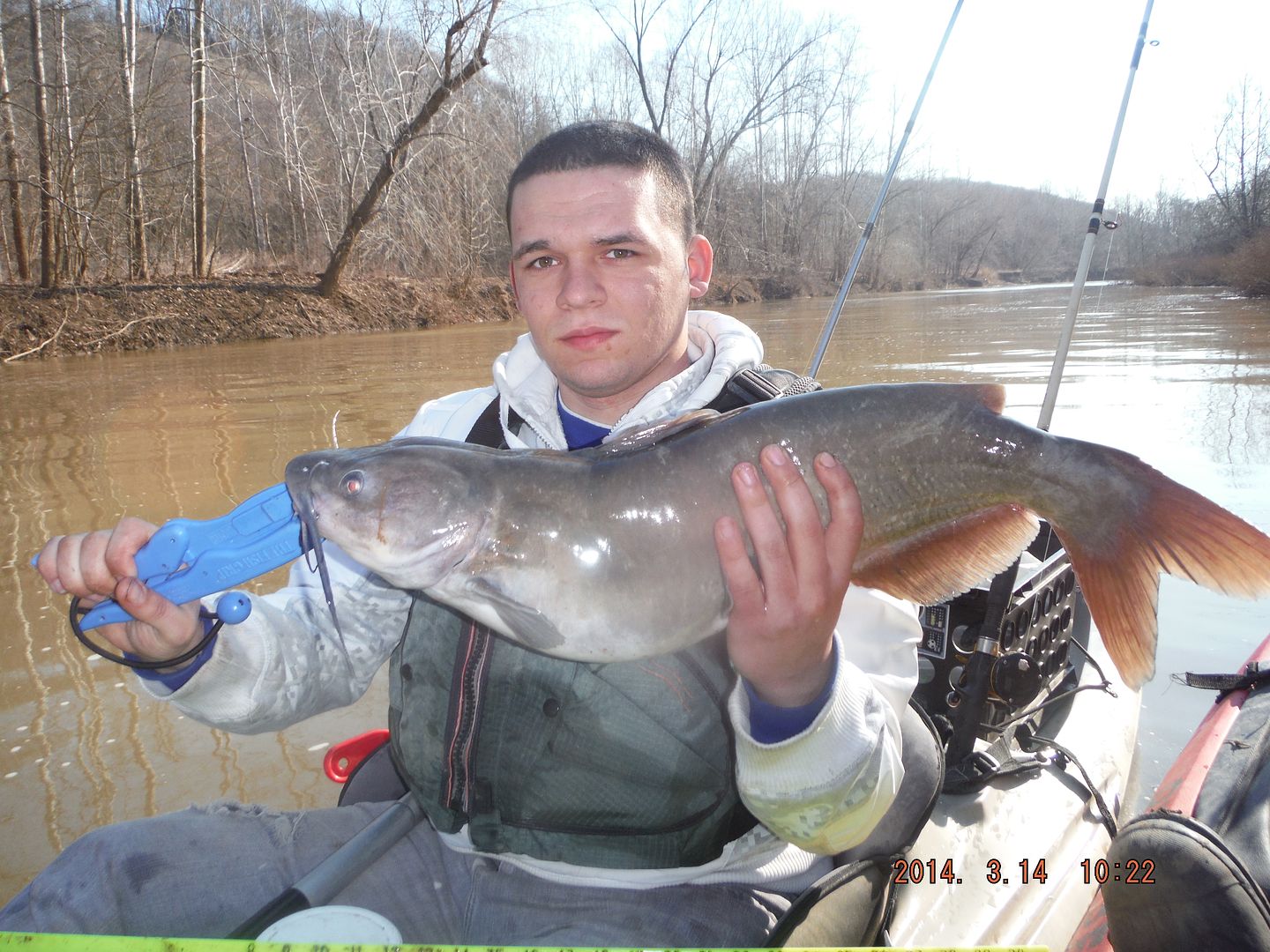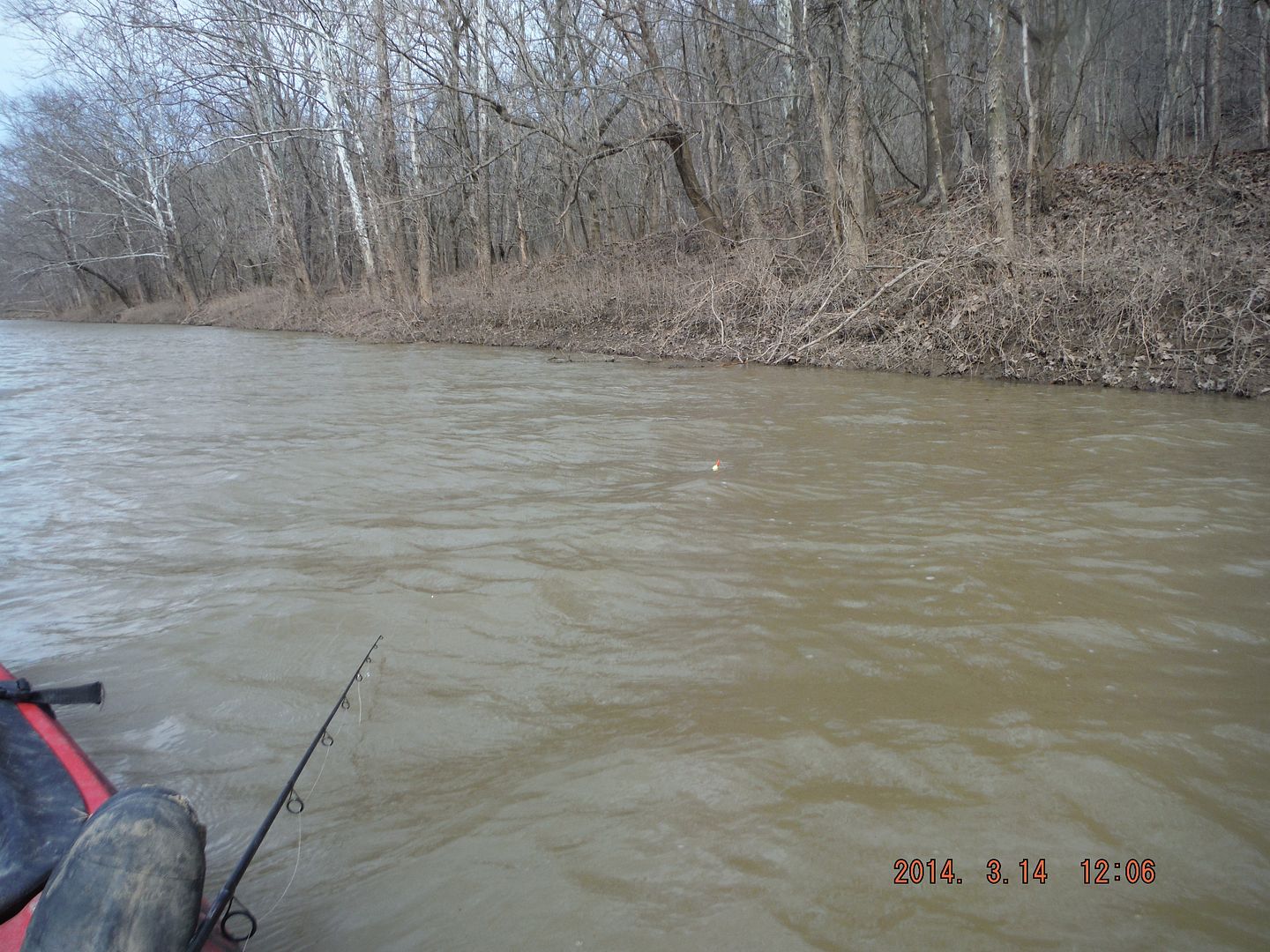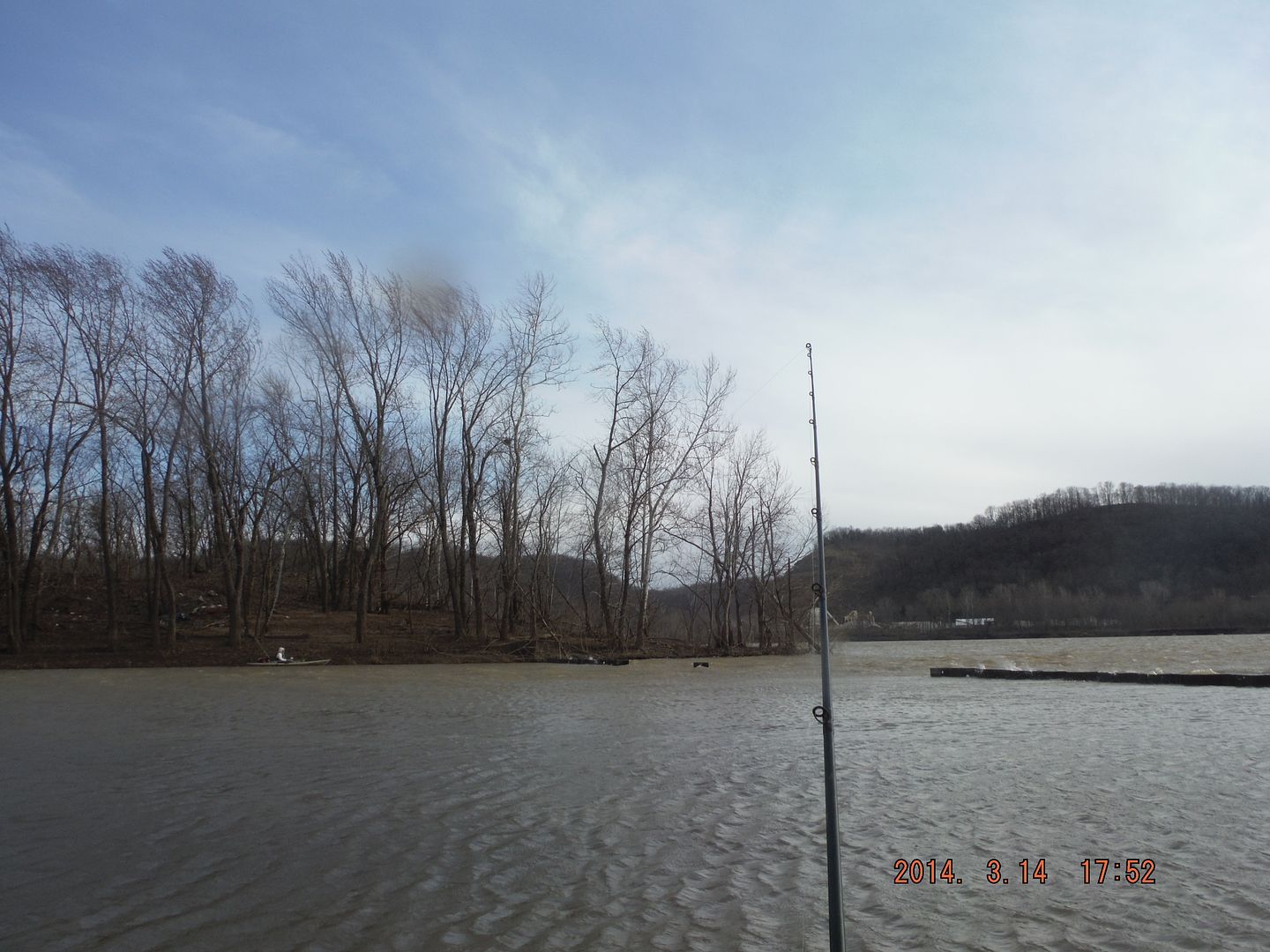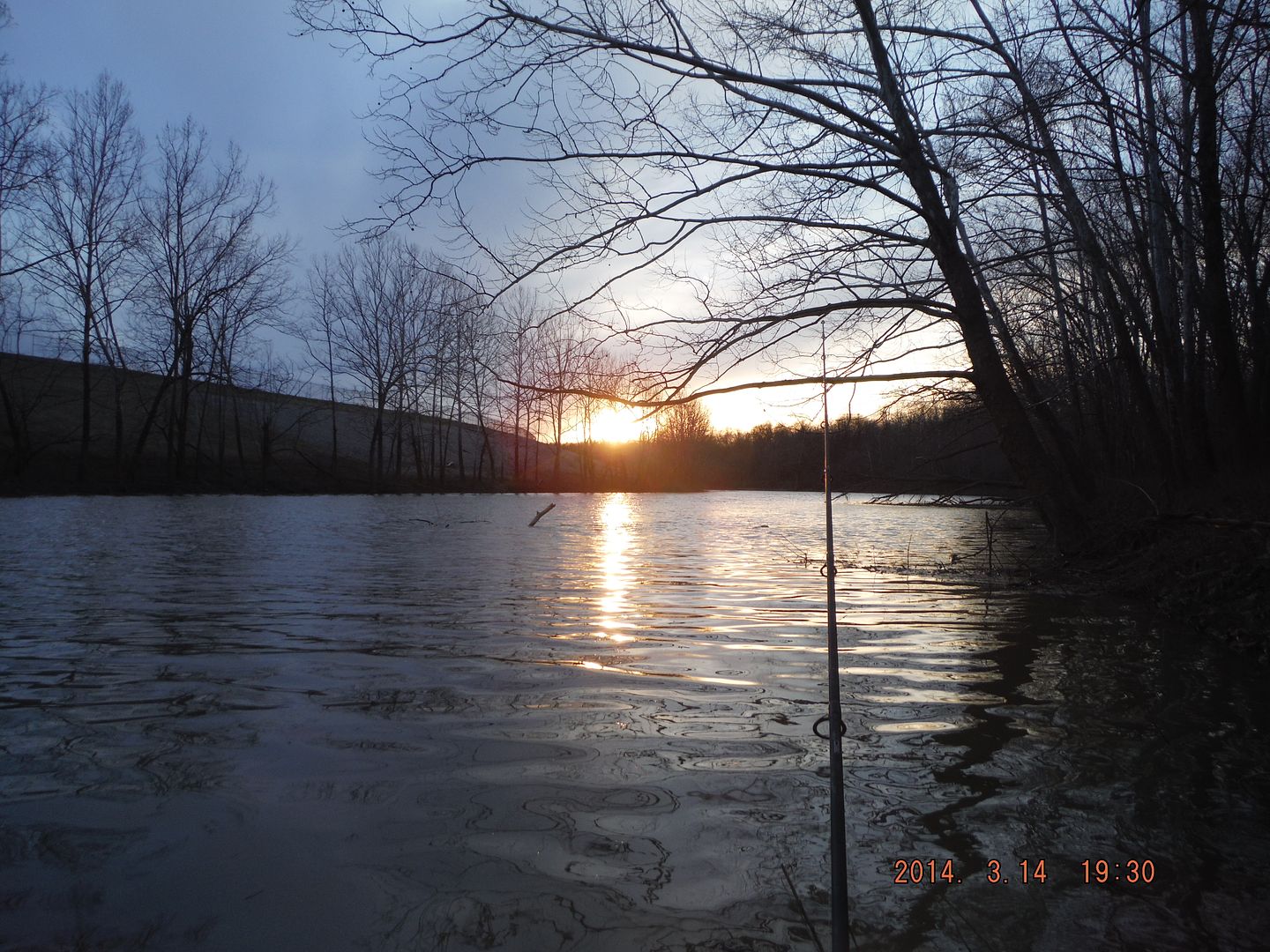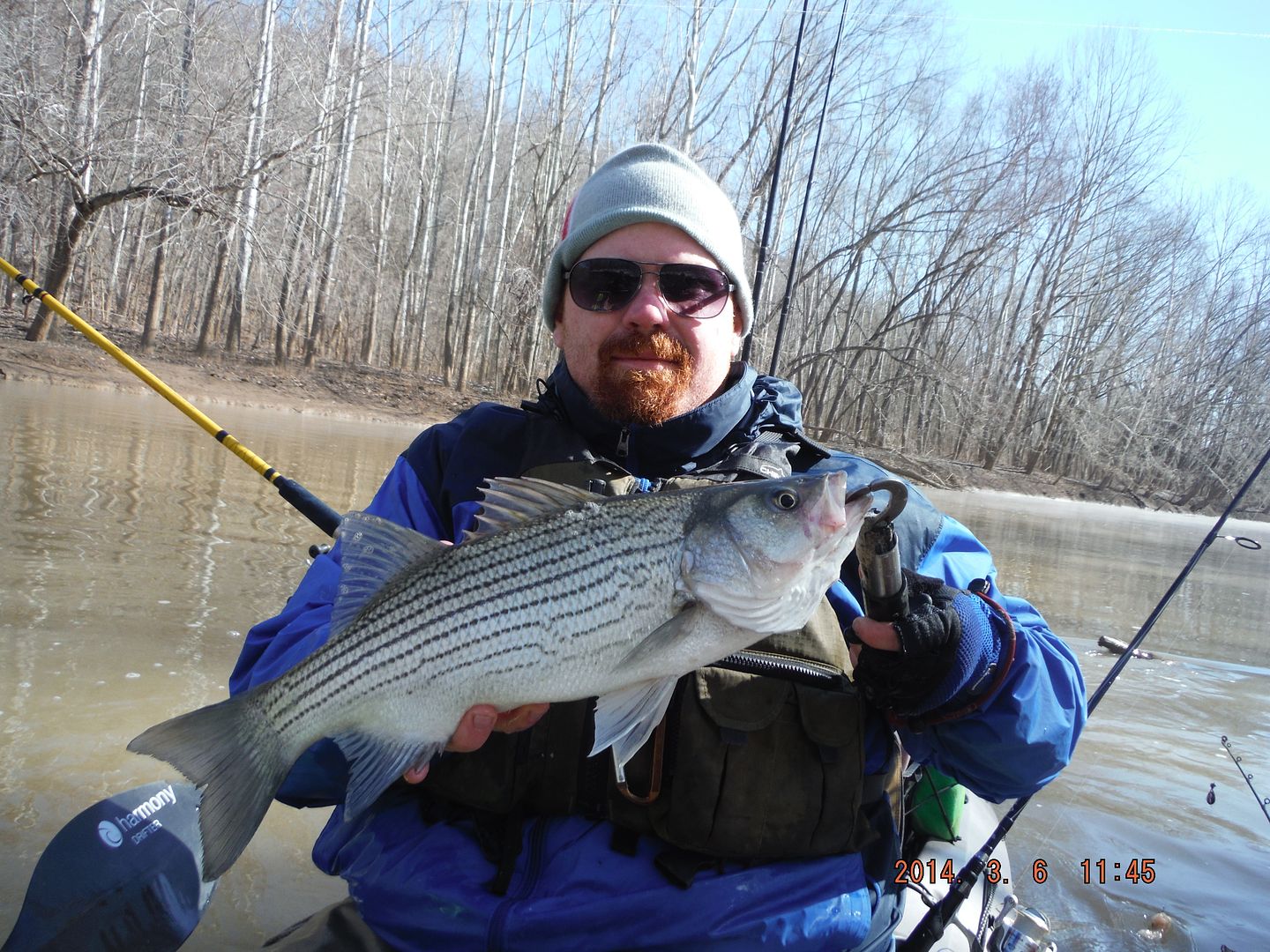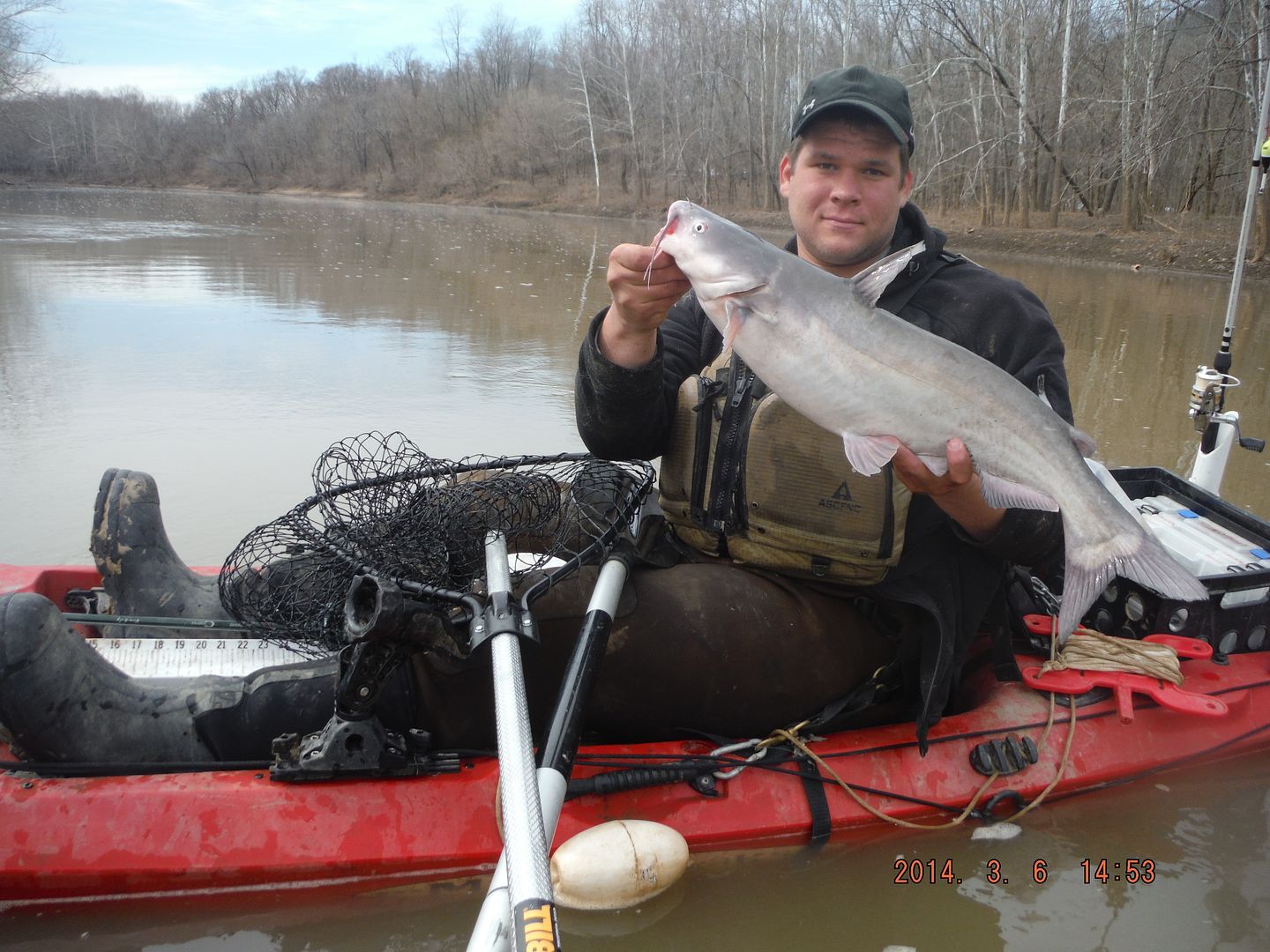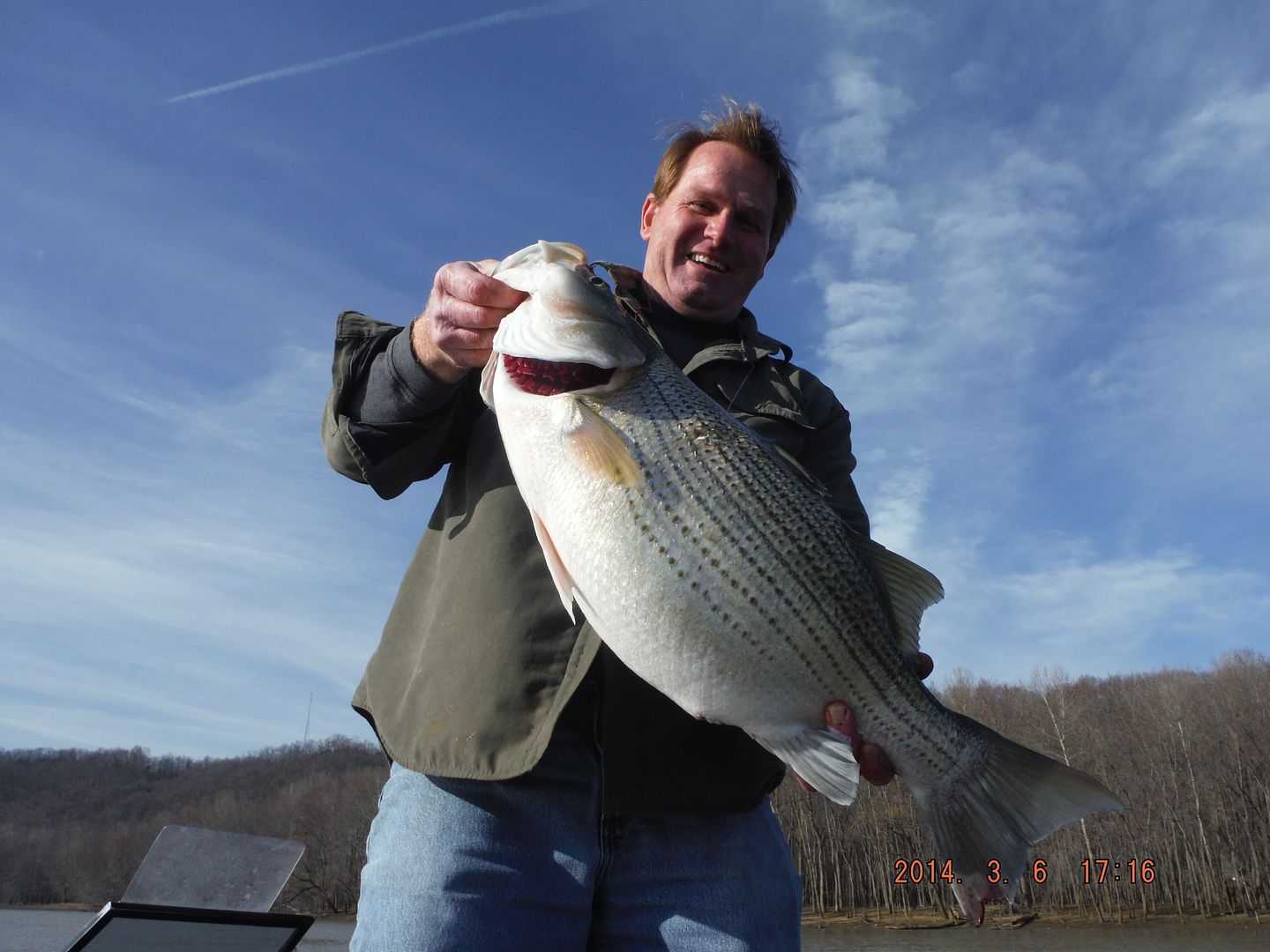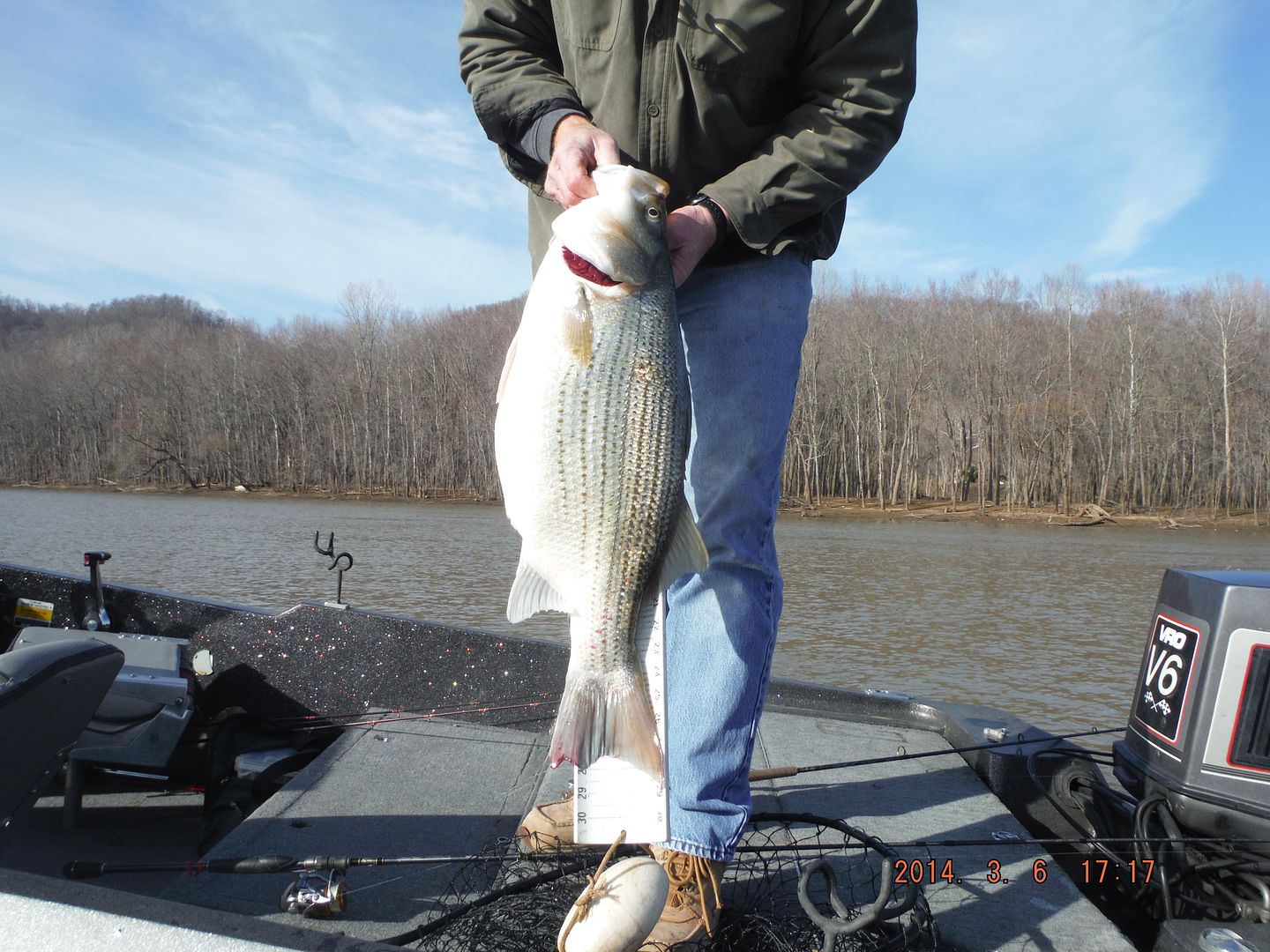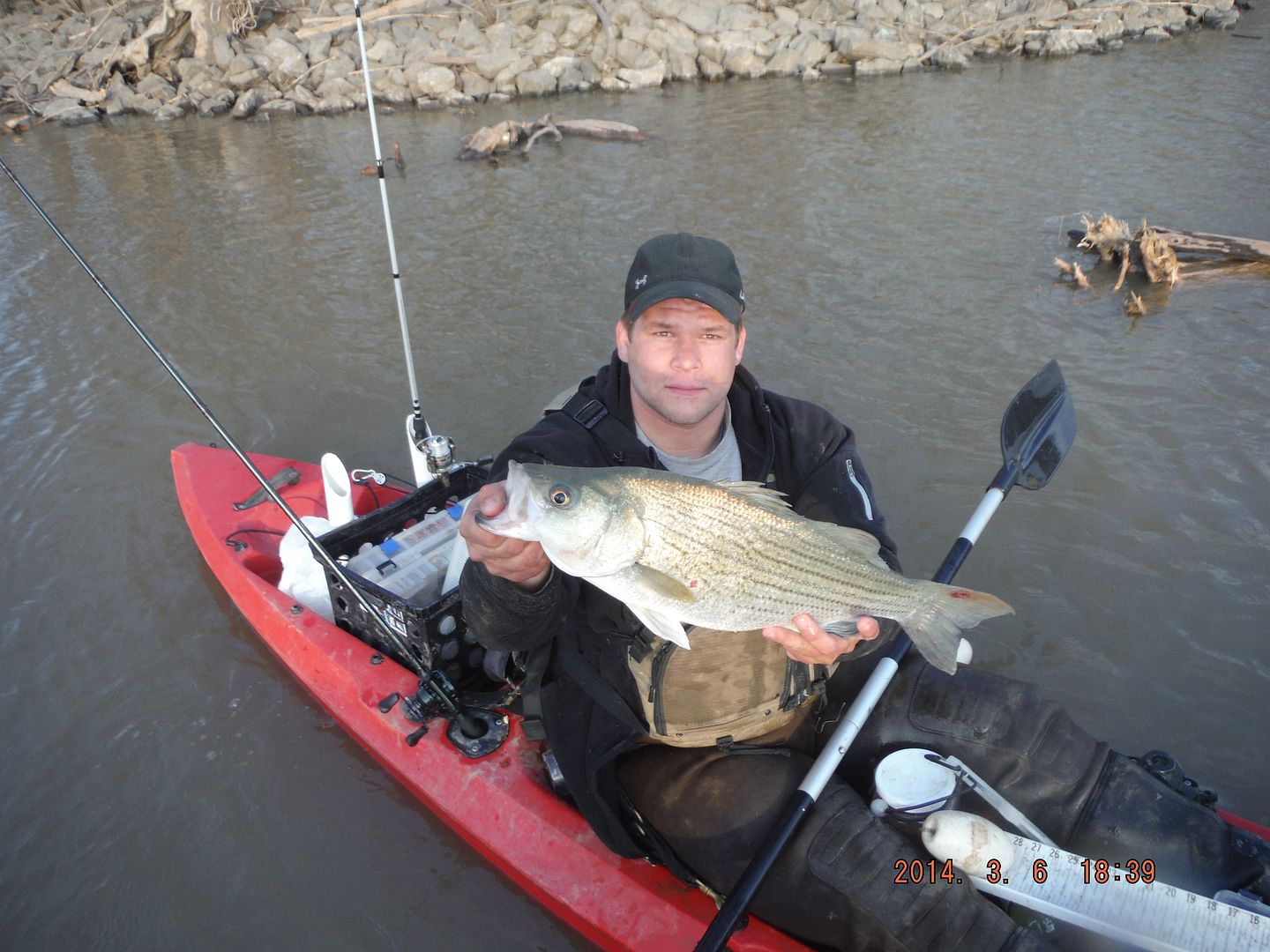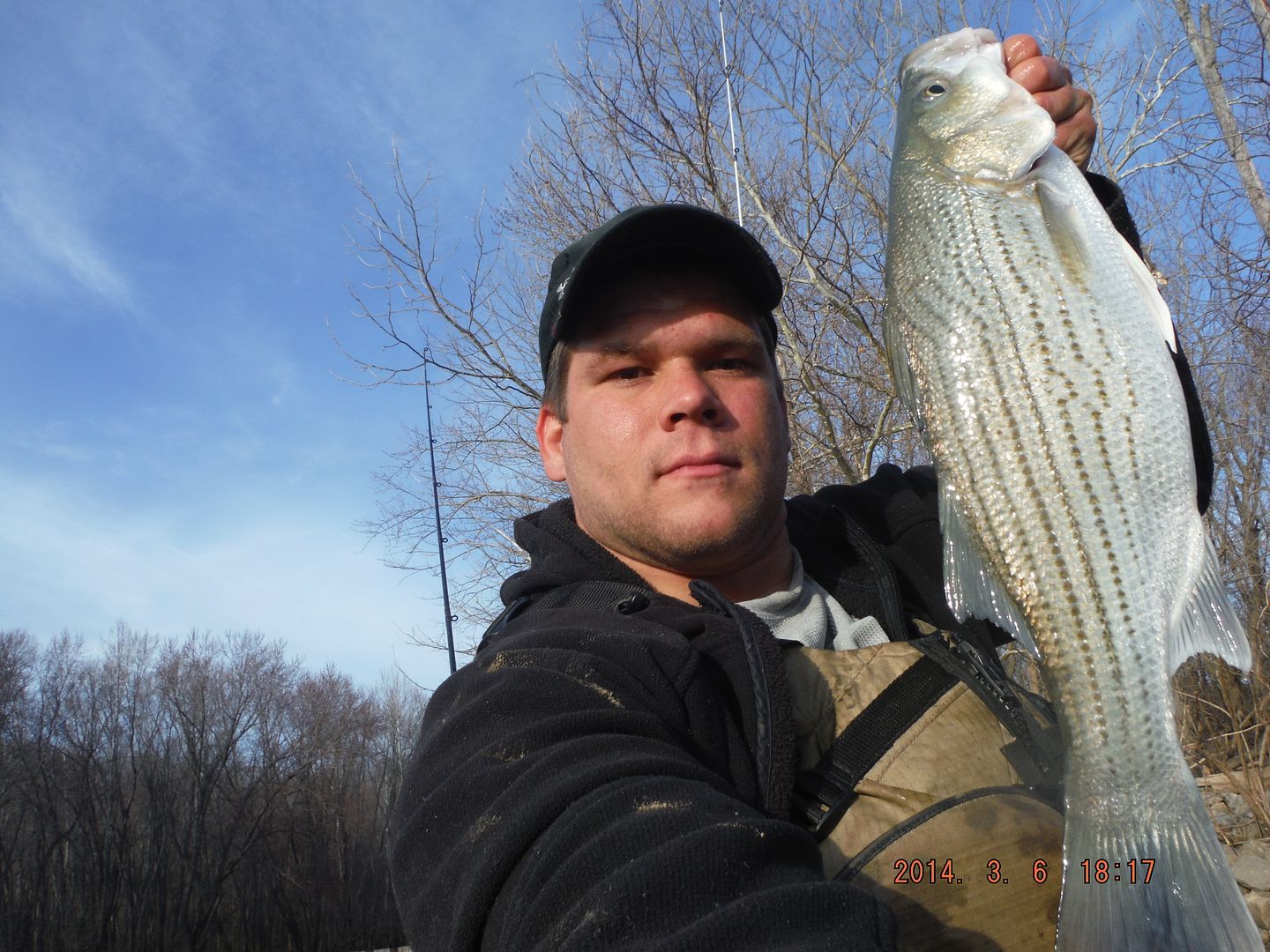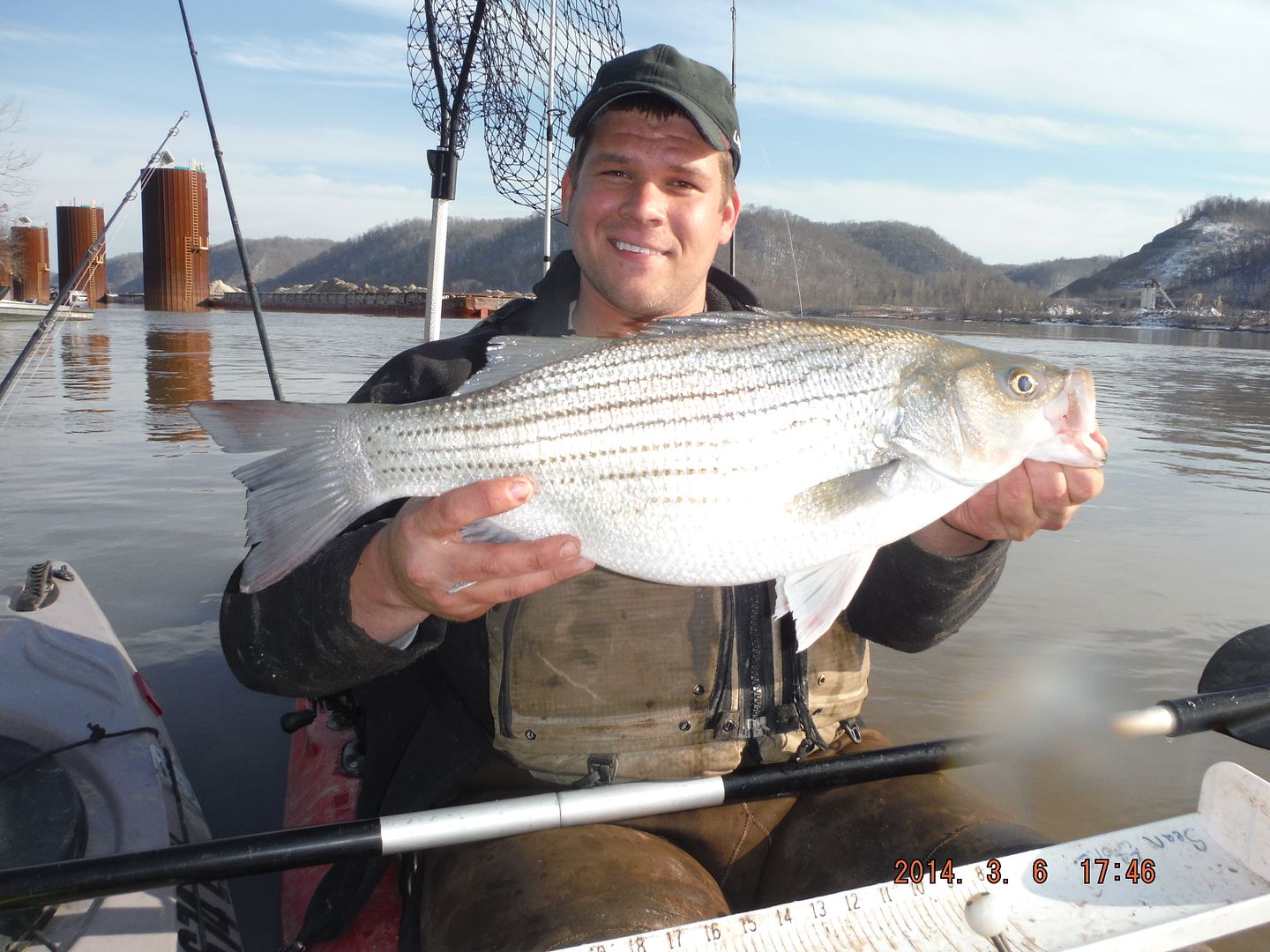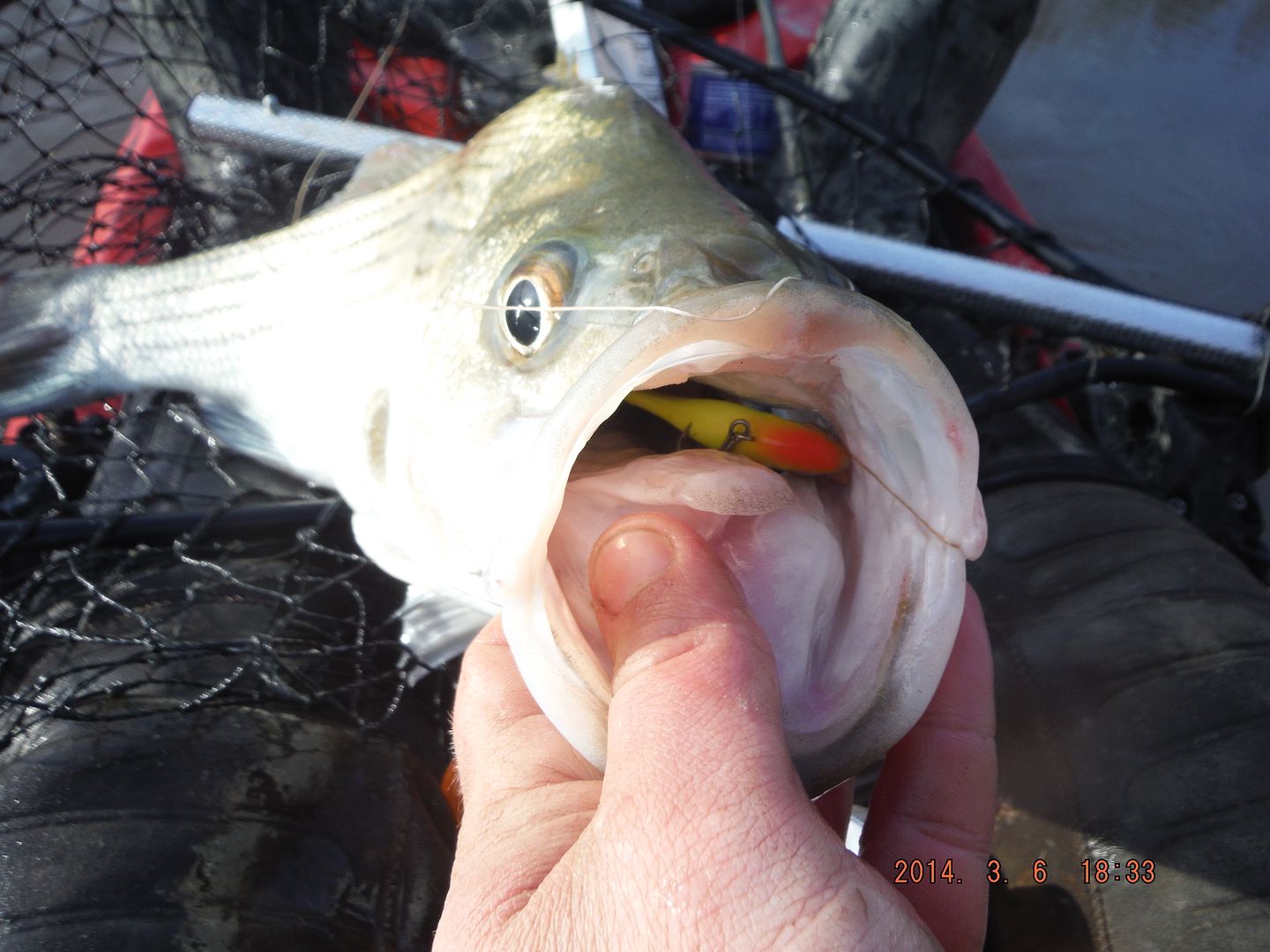Saturday I had the day off and the weather was just too bad for even me to hit the water. For some time now I have had issues with carrying more than three kayaks or more than three people at once, and on multiple occasions I have had to tell a fourth person that I didn't have room for them. Last fall I purchased a Chevy Equinox, which gave me the extra room needed for that fourth person and their gear. However, with my current trailer I still had an issue getting the fourth kayak on board. Here's a shot of what my trailer looked like a month and a half ago.
Now I debated getting an expensive roof rack system from Yakima to give me the room needed to haul an extra yak or two, but I really didn't like the idea banging kayaks around on the roof of my new car. In addition I wasn't sure I could lift a kayak over my head and put it on the rack by myself even if I wanted to.
I spent a couple weeks thinking about how I would layout a kayak trailer in order to maximize space. If I were to modify the trailer I wanted it to do 2 things, (1) have the ability to haul a minimum of 4 kayaks and (2) store gear. The second "desire" only became a real concern this winter, when we started using chest waders. My car began to develop a smell and I'm not talking about that new car smell....the catfish slime, chicken liver, mildew, and river water smell. I needed to find some way to get the waders out of my car and fast. Not to mention that our shoes/boots were bringing a lot of mud into the car. One idea that came to mind was to use the trailer as a way to store gear via truck tool boxes, plastic totes, welded storage areas, etc.
I debated for nearly a month.......Saturday I woke up to find it pouring rain, fishing was out of the question. I had nothing to do, so I made something for me to do! I went to Lowes, Tractor Supply Co, and a local welding shop to get the supplies I needed for the trailer. I picked up four 4' sections of 1" tubing, six sections of 6' long 1" tubing, an 8 foot section of 2"x 3" tube (extending the tongue), some welding rods, a 4' section of 1" angle iron (tie downs), and various other items. I hooked up the trailer and drove it over to the shop at work. Amanda and her dad met me there and we began to disassemble the trailer. We removed all of the old padding, zip ties, 2x4s, etc. Once we had removed everything we began grinding the metal surfaces in order to prepare it for the welds. We started with the corner posts, welding each four foot section of one inch tubing into place.
Once we got the four corner posts into place we took some measurements to ensure that the posts where equal heights and level. We then took the six foot sections of tubing and ran them across the corners of the trailer, creating the rack system that would be used to carry the kayaks. After the rack system was in place we ran tubing from corner to corner (front to back) in order to brace the rack system.....giving us a little more added strength.
Above is what it looked like after we welded everything into place. Before this picture was taken I began cutting the angle iron into 1" pieces....which I then welded to the tubing in order to create places that we could use to strap our kayaks down to. I welded one at the end of each of the cross bars and one on each of the tubes that run the length of the trailer. You can barley see these in the picture above, but they are there. We then unbolted the old 5' trailer tongue and replaced it with the new 8' trailer tongue. If you look at the first picture of this blog you will notice that the kayaks hang over the end of the trailer 3 feet or more. By lengthening the tongue I have added tongue weight to my trailer, which will increase its handling ability. Before if you unhitched the trailer with kayaks loaded up it would have tilted all the way back until it framed out on the back end of the trailer. By lengthening the tongue I have also made the trailer safer for people following me at night, before people had a hard time seeing that the kayaks extended 3-4 feet past the lights.
About an hour before dark we rolled the new and improved kayak trailer outside and hooked it up to the Equinox.
At this point all of the major work was completed, all that is left to do is to paint everything and add some sort of storage to the bed of the trailer. It did turn out much taller than I had expected, placing a kayak on top of the trailer is very similar to same hieght as the roof of the car.
However, if I fish alone and I don't have an extra pair of hands to help me get a kayak on top of the trailer I can simply slide my kayak onto the bed of the trailer and strap it down like I had in the past.
Monday, March 31, 2014
Tuesday, March 25, 2014
3/20-3/23: 4 Days on the Water
I had the opportunity to fish Thursday through Sunday last week. Each day I tried to target a new body of water or a new species of fish. Here's how my weekend unfolded.
Thursday 3/20: Stream Smallmouth
Thursday Amanda and I decided to take the kayaks out to a local creek in search of smallmouth, crappie, saugeye, and rock bass. We targeted a section of creek that lies between two low head dams. These kind of creek sections typically don't see much fluctuation in water levels or water clarity after rain events, however the flow can get very swift at times. We decided to hit the lower section of the creek to see if we could find the fish moving out of the deeper holes into the shallow flats as the sun warmed the shallow waters. We got the kayaks in the water around 11am and started paddling upstream.
Water temperatures were much lower than I had expected, at 39 degrees. Water clarity was close to 3 feet if not slightly more. We decided to paddle upstream a little over a mile and paddle through the first two sets of riffles. I did notice that the water in the lower section was 2 degrees warmer than the northern sections. Now my initial thoughts were that the warmer surface water would run over the dam upstream, thus making the northern section below the dam warmer than the deeper sections. This wasn't the case, at least from 11pm to 3pm it wasn't the case. As we paddled above the second riffle I noticed the water temperature dropped to 38 degrees I told Amanda that we were just wasting our time going any further upstream, the water was only getting colder. I felt that the fish were going to be in the deeper section where the water is a little warmer and where they could easily travel back into deeper water as the sun sets. We decided to start fishing our way down stream at this point. We fished for about two hours without a bite. On one rod I had a float set at 3 feet deep with a live minnow on it and on my other rod I had a bobby garland baby shad on a 1/16oz jig. I let the float drift along side of the kayak while I casted the other rod with the soft plastic along the banks. I only stopped and anchored when I thought fish were present....ie the head of deep holes, large boulders, log jams, etc. Under the second riffle I dropped anchor on a rock shelf and started drifting my float through the deep swift water. I set my float to 4 feet and let it drift through the hole. On my second drift I noticed my float lay flat.....3 seconds later it started moving sideways. I dropped my rod reeled up the slack and set the hook. My drag instantly responded. With my rod held high and drag screaming I looked over to Amanda and told her I had a good one. For the first 10 seconds of the fight the thought of a 20" smallie came to mind, however after the drag stopped and the fish began to work the current I began to question whether or not it was a smallie. This fish had not surfaced, or even gotten near the surface during the 45 second battle. None the less it was a strong fish. I soon got the fish pulled close enough to my kayak to see my float start to emerge. I watched intently as the shadow of the fish came into sight. It was long, very long at somewhere in the mid 20" range..... The fish then began to rise toward the surface as the greyish blue shadow turned to dark brown and black............it was a giant saugeye. I played the fish in the current for another 20 seconds and then began lifting my rod with my left hand in order to bring the fish withing grasping distance of my right hand. It was just out of grasps reach so I reeled in a little more slack and began to lift the rod again when then the hook came flying by my head. I watched as the fish sat on the surface for a few seconds before he realized he had threw my hook and dove back down to the bottom.
I was pretty upset. I thought for sure I had lost the only fish I would get the chance of hooking all day. Less than thirty minutes later Amanda and I drifted down to one of my favorite spots in the creek, a huge bolder and log jam, which had created a deep scour hole. I dropped anchor in 2 feet of water 40 yards upstream of the log jam and began drifting my float and minnow along the run before the head of the hole. Each drift took about 6 minutes to complete. I started with the bank on the first drift, 10 feet off of the bank on my second, the middle of the creek on the third drift, etc. Each time I made a drift closer to the hole I set my float a foot deeper. On my third drift my float began to move sideways halfway through my drift (still on the flat before the hole) and then slowly sank. I reeled up the slack and set the hook. This time I had no doubts about the specie of fish on the end of my line, as the smallmouth made a remarkable leap within seconds of the hook set. I sat up a little bit and began working the fish closer to my kayak. This time around luck was on my side, I had landed my first smallmouth of the year.
Unfortunately this was the last fish we would see on this trip. We worked our way downstream focusing on the head of deeper holes, but failed to fool any other fish into eating.
Friday 3/21: Ohio River
Russ and I hit the Ohio River Friday in search of catfish and hybrid striped bass. Our kayakwars team was short 6 channel cats from its monthly cap so we decided to finish those off so we could focus on other fish the rest of the month. Since we knew that we would easily catch 6 cats over 18" we decided to make a competition out of the remaining spots. The largest 6 channel cats of the day would get submitted for points, the other fish would be worth nothing. The day started out well for me, Russ on the other hand fell into a slump. I pulled in a few cats in the 19-22" by drifting chicken liver under a float set 1 foot off of the bottom. Russ was using the same technique on his side of the creek, but failed to catch anything over 18". Along the way I picked up a couple blue cats in the 22-25" range, which were all worth points since the blue cats monthly cap was nearly 30 fish short. These were a good bonus on top of the channel cats points I could possibly submit. I'm pretty sure at one point I had the top 5 out of 6 channel cats. Russ soon got into his grove and started making up for lost time, quickly boating (or yaking) two 22" channels and a 24" channel cat, which evened the score 3 to 3. (I had three cats in the top six and he had three in the top 6)
At this point I had drifted down to the mouth of the Ohio River. I faced the difficult decision of hitting the river for hybrid striped bass or paddling back upstream and making the float/drift back down while fishing for catfish. After a brief debate with myself I tied on a grey flitterbait and anchored up in the Ohio River. I began working flitterbait near the bottom of a steep ledge, and I had immediate success.
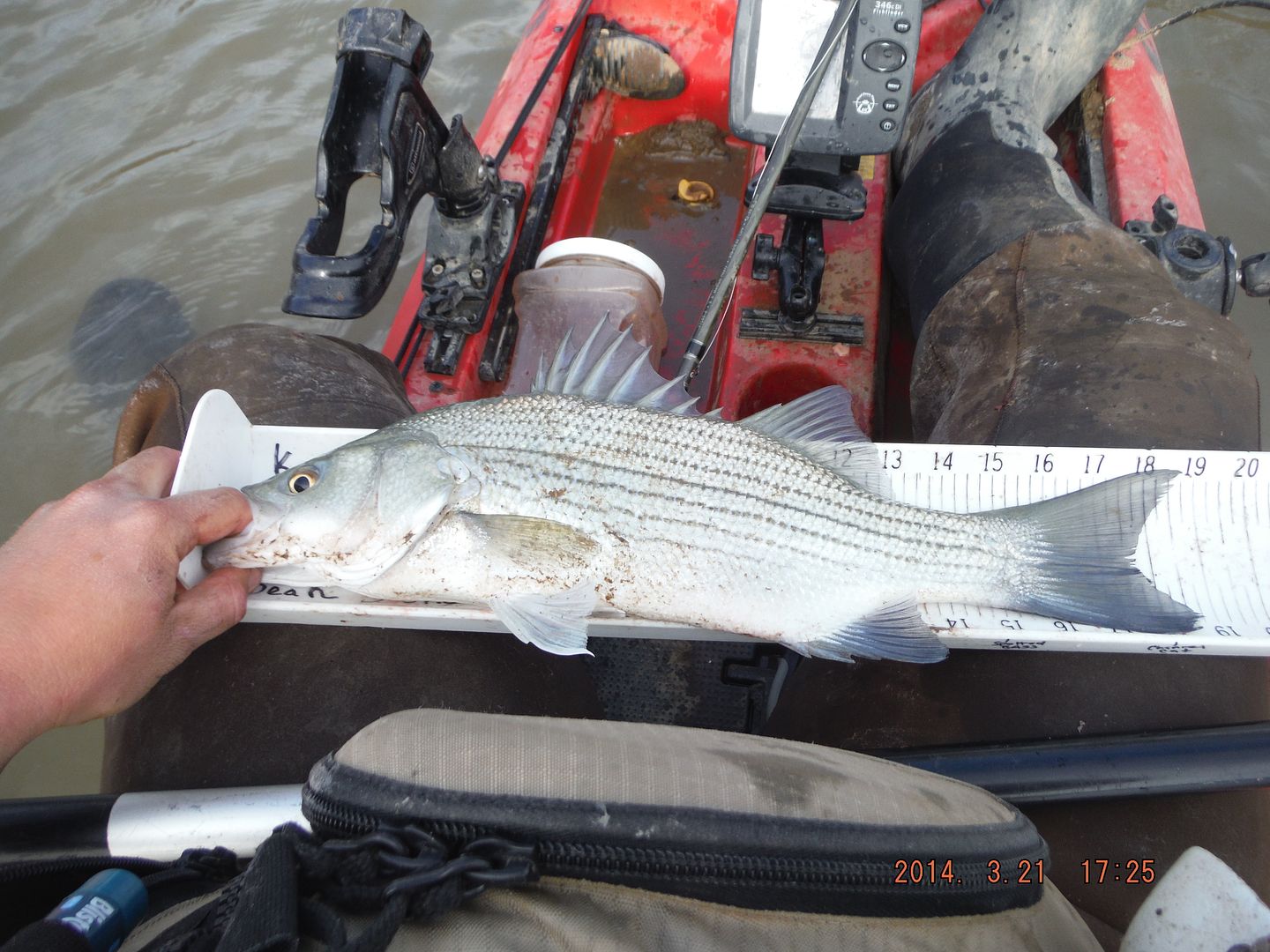
Now it wasn't a giant, but I was darn glad to have it. This would give me another 15 points on the day for our kayakwar team. I went back to work with the flitterbait. I threw the bait out 30 yards and let it hit bottom. I reeled up the slack in my line and lifted the bait with a quick snap of my rod. I then kept tension on the bait as it fell back to the bottom, I let it sit for a second and then snapped the bait back off of bottom, and then all of a sudden I felt the "Tick". I swung for the fences and felt very little pressure. My line began to move rapidly downstream and my rod began to bend with the weight of the fish. I kept steady pressure the whole time and let the fish do what it wanted. I had a very weak hookset so I feared the worst. As the fish neared the surface it made a few good runs, ripping drag for 3 -5 seconds each time. Amazing the hook stayed in place long enough for me to get the net under the fish.
At this point Russ was still up the creek so I decided to try to snap a picture of myself holding the fish using the timer on my camera. I tilted my fish finder down to where it was completely flat, hit the button on my camera, and sat it on my fish finder screen. Ten seconds later the camera went off, I placed the fish back in the water with one hand and checked the photo with my other hand........nope no good, I didn't get my head in the photo. Three attempts later I got this picture.
Russ had now made his way down to the mouth and I told him that I had caught a couple good hybrids already. He anchored just upstream of me and we both began working our flitterbaits. Thirty mintues later I picked up yet another fish, this time around it wasn't a hybrid striper.
Surprisingly, the buffalo was hooked in the bottom of its mouth. I took a quick picture and then went back to work. Another half an hour passed without a fish and I began to wonder if the fish had moved down river. I tied on a white flitterbait to see if maybe I could fool a fish that's seen the grey one go by a few times already. A few casts later I feel the "tick" halfway through the lift of my rod, I then set the hook into a freight train. This fish had a bad temper, ripping drag one moment, cutting in and out of the current the next. I finally got the fish to start working his way toward the yak when I saw it surface. It was a stout fish...... I knew it would compete with my personal best of 5lbs 13oz.
It went 6lbs 6oz, a new personal best. Since Russ was nearby he snapped a picture for me, which turned out a lot nicer than my solo attempt earlier. Another thirty minutes passed, Russ and I just started to feel it in our arms. Lifting and dropping blade baits for 2 hours was pretty hard on the shoulders and forearms, throw in a few drag ripping hybrid stripers and your really in for a rough evening. I took a break and watched for signs of activity near the surface, hoping to find a hint that the fish are moving off of bottom to chase shad higher in the water column. As I'm scanning for signs of shad I hear Russ mumble something to the effect of, "ohp." I then turn around to see his rod doubled over and a smile on his face. After a few quick bursts Russ brings the fish to the surface for its photo shoot.
It went 20.5". (This would be Russ' last picture with his beloved sun glasses, they are now at the bottom of Rocky Fork Lake.....more about that below.) We worked the blade baits for a little while longer but failed to find another fish on them. An hour later fish had started busting the surface here and there but they were really spread out. One would bust at my 12 o cock 20 yards away and 20 minutes later one would bust at my 6 o clock 150 yards away. I then made the switch to Smack Tackles Gizz 3 crankbait. It was a long shot but I figured I'd see if I could get lucky enough to swim my gizz3 by one of them. I tried for the next hour and a half with no luck. Russ eventually went up the creek and tried for catfish again. We fished until 30 minutes past dark and then decided to call it quits for the day. I ended up with 12 channel catfish over 18" only 3 of which counted for kayakwars, 3 blue cats over 20" for kayakwars, and 3 hybrids over 18" for kayakwars for a grand total of 105 points.
Saturday 3/22: Crappie on Rocky Fork
Saturday I met up with Mike Murphy, Brad Beals, and Russ on Rocky Fork Lake to do some crappie fishing. We grabbed a few dozen minnows and hit the water. There was a local catfish tournament being held at the boat ramp where I wanted to fish, so we opted to hit the deep end of the lake to avoid heavy boat traffic. We hit a few spots that I typically catch fish on and came up empty handed. We tried floats and minnows, moon jigs tipped with crappie nibbles, 1/32oz jigs and bobby garland baby shad, 1/32oz jig and minnows, etc. but nothing was working. I told everyone that we were going to have to swallow our pride and head over to the maria and fish the metal structures that secure the docks to the ground. We fished just about every single support structure but failed to catch a fish. At the last series of docks we all gathered together and discussed our game plan, I had a plan B if everyone was willing to pack up and drive to another spot down the road. We discussed our options a little and eventually decided to leave the lake in search of better fishing.
We unloaded the kayaks at the launch location and Mike and Brad were introduced to the hill of death......OK so that's probably taking it too far but its pretty bad. They were willing to give it a shot if it meant getting on some fish. I assured them that its the best option I knew of. We hit the water and paddled up to the best spot on the creek. Brad had set up very close to my favorite spot and I took Amanda's typical spot. Russ worked a tree adjacent to Brad and I, and Mike worked a few spots here and there. I didn't anchor at first, instead I casted my float into wood and drifted around while I watched my float. I did manage to get a bite within the first 5 minutes but it ended up making off with my minnow. Brad soon found a productive pattern, a float set at 3.5 feet with a minnow on the upstream side of the fallen trees. He caught a crappie every 10 to 15 minutes while everyone else watched in amazement. We all eventually set our floats to 3.5 feet and even started casting near the fallen tree.
I eventually managed two crappie underneath the tree that Brad was fishing, he on the other hand pulled close to a dozen out of it in less than 2 hours. Russ tried to fish the area to the right of Brad but failed to find a fish. Mike eventually ditched crappie fishing and went to throwing a deep diving jointed Rapala husky jerk bait.....which paid off for him. He managed two small bass, the largest of which was 14". Mike then proceeded to rub it in our faces with stuff like, "Look at these crappie fisherman.......hows the crappie?.....etc." The last 3 hours of the day really salvaged the trip for us. Brad ended up keeping 11 crappie, the largest of which were in the 11" range.
About a half an hour before dark we decided to call it quits so we could get all of our gear loaded up before it was to dark to see.
Sunday 3/23: Ohio River Round 2
Sunday I hit the river with Brian AKA. Bigfoot, a fellow kayaker and OGF member. Brian wanted to get as much time in on the water as he could so we decided to meet at 7am. I gave him the run down on what the river had to offer, what rigs we use, what bait we find productive, etc. I told him that we could try to fish for hybrids, but its hit or miss. We could fish all day long and not catch a single fish, or we could fish and catch one every 20 minutes. Catfish on the other hand are consistent, we catch them every time we fish. We eventually decided to try drifting floats with chicken liver down to the mouth of the river for cats and hybrids. We floated for close to an hour before we caught our first fish, which just happened to be one of the smallest channel cats I've seen caught out of the creek. For some reason or another we kept losing our bait to little fish, this hadn't been a problem in the past so I really didn't know how to avoid it. Eventually we drifted out of the "little fish zone", and the nibbles seemed to stop. We did start finding a few better fish here and there, but nothing worth bragging about. (lots of 15-20" channels and a few 14-16" hybrids) We eventually made it down to the mouth of the Ohio River and decided to head out and see if we could find the big hybrid stripers. After two hours of bouncing blade baits I was certain they weren't going to bite for us. We took a break, got out and stretched our legs, ate lunch, and then went back to fishing. We decided to head back upstream and float the section where we had started to get out of the small fish nibbles.
An hour later I hooked up with a decent channel, upon bringing it into the kayak I discovered something very interesting. I had landed the 24" channel cat without ever hooking it, although it pulled my float under I had actually missed the hookset. Instead of hooking the fish in the mouth, my line had wrapped around a swivel that was attached to a leader hanging out of the channels mouth.
Now here is where the story gets even worse for the channel cat....I decided to put fish grips on its mouth so I could begin to work on untangling my braided line from the swivel. In one hand I held the fish grips and in the other hand I began unraveling the tangled mess. As I was about to finish untangling the line the channel started rolling and I lost my grip on the fish grips. He soon made his way back into the water with the leader still attached and fish grips in his mouth. I grabbed my rod to see if my line was till attached, nope. I thought to myself, "this fish is in for a long rough spring." I'm still holding out hope that he can somehow free himself, but in reality I know its going to be next to impossible.
I finished the day off with another 5 channel cats over 18" before I completely ran out of bait. At that point I began fishing with a gizz3 for hybrids. In the meantime Brian found his best fish of the day, a 24" channel cat. (without fishgrips)
The sun soon began to set over the tree tops and the temperature plummeted, so we decided to call it quits shortly after this picture.
Thursday 3/20: Stream Smallmouth
Thursday Amanda and I decided to take the kayaks out to a local creek in search of smallmouth, crappie, saugeye, and rock bass. We targeted a section of creek that lies between two low head dams. These kind of creek sections typically don't see much fluctuation in water levels or water clarity after rain events, however the flow can get very swift at times. We decided to hit the lower section of the creek to see if we could find the fish moving out of the deeper holes into the shallow flats as the sun warmed the shallow waters. We got the kayaks in the water around 11am and started paddling upstream.
Water temperatures were much lower than I had expected, at 39 degrees. Water clarity was close to 3 feet if not slightly more. We decided to paddle upstream a little over a mile and paddle through the first two sets of riffles. I did notice that the water in the lower section was 2 degrees warmer than the northern sections. Now my initial thoughts were that the warmer surface water would run over the dam upstream, thus making the northern section below the dam warmer than the deeper sections. This wasn't the case, at least from 11pm to 3pm it wasn't the case. As we paddled above the second riffle I noticed the water temperature dropped to 38 degrees I told Amanda that we were just wasting our time going any further upstream, the water was only getting colder. I felt that the fish were going to be in the deeper section where the water is a little warmer and where they could easily travel back into deeper water as the sun sets. We decided to start fishing our way down stream at this point. We fished for about two hours without a bite. On one rod I had a float set at 3 feet deep with a live minnow on it and on my other rod I had a bobby garland baby shad on a 1/16oz jig. I let the float drift along side of the kayak while I casted the other rod with the soft plastic along the banks. I only stopped and anchored when I thought fish were present....ie the head of deep holes, large boulders, log jams, etc. Under the second riffle I dropped anchor on a rock shelf and started drifting my float through the deep swift water. I set my float to 4 feet and let it drift through the hole. On my second drift I noticed my float lay flat.....3 seconds later it started moving sideways. I dropped my rod reeled up the slack and set the hook. My drag instantly responded. With my rod held high and drag screaming I looked over to Amanda and told her I had a good one. For the first 10 seconds of the fight the thought of a 20" smallie came to mind, however after the drag stopped and the fish began to work the current I began to question whether or not it was a smallie. This fish had not surfaced, or even gotten near the surface during the 45 second battle. None the less it was a strong fish. I soon got the fish pulled close enough to my kayak to see my float start to emerge. I watched intently as the shadow of the fish came into sight. It was long, very long at somewhere in the mid 20" range..... The fish then began to rise toward the surface as the greyish blue shadow turned to dark brown and black............it was a giant saugeye. I played the fish in the current for another 20 seconds and then began lifting my rod with my left hand in order to bring the fish withing grasping distance of my right hand. It was just out of grasps reach so I reeled in a little more slack and began to lift the rod again when then the hook came flying by my head. I watched as the fish sat on the surface for a few seconds before he realized he had threw my hook and dove back down to the bottom.
I was pretty upset. I thought for sure I had lost the only fish I would get the chance of hooking all day. Less than thirty minutes later Amanda and I drifted down to one of my favorite spots in the creek, a huge bolder and log jam, which had created a deep scour hole. I dropped anchor in 2 feet of water 40 yards upstream of the log jam and began drifting my float and minnow along the run before the head of the hole. Each drift took about 6 minutes to complete. I started with the bank on the first drift, 10 feet off of the bank on my second, the middle of the creek on the third drift, etc. Each time I made a drift closer to the hole I set my float a foot deeper. On my third drift my float began to move sideways halfway through my drift (still on the flat before the hole) and then slowly sank. I reeled up the slack and set the hook. This time I had no doubts about the specie of fish on the end of my line, as the smallmouth made a remarkable leap within seconds of the hook set. I sat up a little bit and began working the fish closer to my kayak. This time around luck was on my side, I had landed my first smallmouth of the year.
Unfortunately this was the last fish we would see on this trip. We worked our way downstream focusing on the head of deeper holes, but failed to fool any other fish into eating.
Friday 3/21: Ohio River
Russ and I hit the Ohio River Friday in search of catfish and hybrid striped bass. Our kayakwars team was short 6 channel cats from its monthly cap so we decided to finish those off so we could focus on other fish the rest of the month. Since we knew that we would easily catch 6 cats over 18" we decided to make a competition out of the remaining spots. The largest 6 channel cats of the day would get submitted for points, the other fish would be worth nothing. The day started out well for me, Russ on the other hand fell into a slump. I pulled in a few cats in the 19-22" by drifting chicken liver under a float set 1 foot off of the bottom. Russ was using the same technique on his side of the creek, but failed to catch anything over 18". Along the way I picked up a couple blue cats in the 22-25" range, which were all worth points since the blue cats monthly cap was nearly 30 fish short. These were a good bonus on top of the channel cats points I could possibly submit. I'm pretty sure at one point I had the top 5 out of 6 channel cats. Russ soon got into his grove and started making up for lost time, quickly boating (or yaking) two 22" channels and a 24" channel cat, which evened the score 3 to 3. (I had three cats in the top six and he had three in the top 6)
At this point I had drifted down to the mouth of the Ohio River. I faced the difficult decision of hitting the river for hybrid striped bass or paddling back upstream and making the float/drift back down while fishing for catfish. After a brief debate with myself I tied on a grey flitterbait and anchored up in the Ohio River. I began working flitterbait near the bottom of a steep ledge, and I had immediate success.

Now it wasn't a giant, but I was darn glad to have it. This would give me another 15 points on the day for our kayakwar team. I went back to work with the flitterbait. I threw the bait out 30 yards and let it hit bottom. I reeled up the slack in my line and lifted the bait with a quick snap of my rod. I then kept tension on the bait as it fell back to the bottom, I let it sit for a second and then snapped the bait back off of bottom, and then all of a sudden I felt the "Tick". I swung for the fences and felt very little pressure. My line began to move rapidly downstream and my rod began to bend with the weight of the fish. I kept steady pressure the whole time and let the fish do what it wanted. I had a very weak hookset so I feared the worst. As the fish neared the surface it made a few good runs, ripping drag for 3 -5 seconds each time. Amazing the hook stayed in place long enough for me to get the net under the fish.
At this point Russ was still up the creek so I decided to try to snap a picture of myself holding the fish using the timer on my camera. I tilted my fish finder down to where it was completely flat, hit the button on my camera, and sat it on my fish finder screen. Ten seconds later the camera went off, I placed the fish back in the water with one hand and checked the photo with my other hand........nope no good, I didn't get my head in the photo. Three attempts later I got this picture.
Russ had now made his way down to the mouth and I told him that I had caught a couple good hybrids already. He anchored just upstream of me and we both began working our flitterbaits. Thirty mintues later I picked up yet another fish, this time around it wasn't a hybrid striper.
Surprisingly, the buffalo was hooked in the bottom of its mouth. I took a quick picture and then went back to work. Another half an hour passed without a fish and I began to wonder if the fish had moved down river. I tied on a white flitterbait to see if maybe I could fool a fish that's seen the grey one go by a few times already. A few casts later I feel the "tick" halfway through the lift of my rod, I then set the hook into a freight train. This fish had a bad temper, ripping drag one moment, cutting in and out of the current the next. I finally got the fish to start working his way toward the yak when I saw it surface. It was a stout fish...... I knew it would compete with my personal best of 5lbs 13oz.
It went 6lbs 6oz, a new personal best. Since Russ was nearby he snapped a picture for me, which turned out a lot nicer than my solo attempt earlier. Another thirty minutes passed, Russ and I just started to feel it in our arms. Lifting and dropping blade baits for 2 hours was pretty hard on the shoulders and forearms, throw in a few drag ripping hybrid stripers and your really in for a rough evening. I took a break and watched for signs of activity near the surface, hoping to find a hint that the fish are moving off of bottom to chase shad higher in the water column. As I'm scanning for signs of shad I hear Russ mumble something to the effect of, "ohp." I then turn around to see his rod doubled over and a smile on his face. After a few quick bursts Russ brings the fish to the surface for its photo shoot.
It went 20.5". (This would be Russ' last picture with his beloved sun glasses, they are now at the bottom of Rocky Fork Lake.....more about that below.) We worked the blade baits for a little while longer but failed to find another fish on them. An hour later fish had started busting the surface here and there but they were really spread out. One would bust at my 12 o cock 20 yards away and 20 minutes later one would bust at my 6 o clock 150 yards away. I then made the switch to Smack Tackles Gizz 3 crankbait. It was a long shot but I figured I'd see if I could get lucky enough to swim my gizz3 by one of them. I tried for the next hour and a half with no luck. Russ eventually went up the creek and tried for catfish again. We fished until 30 minutes past dark and then decided to call it quits for the day. I ended up with 12 channel catfish over 18" only 3 of which counted for kayakwars, 3 blue cats over 20" for kayakwars, and 3 hybrids over 18" for kayakwars for a grand total of 105 points.
Saturday 3/22: Crappie on Rocky Fork
Saturday I met up with Mike Murphy, Brad Beals, and Russ on Rocky Fork Lake to do some crappie fishing. We grabbed a few dozen minnows and hit the water. There was a local catfish tournament being held at the boat ramp where I wanted to fish, so we opted to hit the deep end of the lake to avoid heavy boat traffic. We hit a few spots that I typically catch fish on and came up empty handed. We tried floats and minnows, moon jigs tipped with crappie nibbles, 1/32oz jigs and bobby garland baby shad, 1/32oz jig and minnows, etc. but nothing was working. I told everyone that we were going to have to swallow our pride and head over to the maria and fish the metal structures that secure the docks to the ground. We fished just about every single support structure but failed to catch a fish. At the last series of docks we all gathered together and discussed our game plan, I had a plan B if everyone was willing to pack up and drive to another spot down the road. We discussed our options a little and eventually decided to leave the lake in search of better fishing.
We unloaded the kayaks at the launch location and Mike and Brad were introduced to the hill of death......OK so that's probably taking it too far but its pretty bad. They were willing to give it a shot if it meant getting on some fish. I assured them that its the best option I knew of. We hit the water and paddled up to the best spot on the creek. Brad had set up very close to my favorite spot and I took Amanda's typical spot. Russ worked a tree adjacent to Brad and I, and Mike worked a few spots here and there. I didn't anchor at first, instead I casted my float into wood and drifted around while I watched my float. I did manage to get a bite within the first 5 minutes but it ended up making off with my minnow. Brad soon found a productive pattern, a float set at 3.5 feet with a minnow on the upstream side of the fallen trees. He caught a crappie every 10 to 15 minutes while everyone else watched in amazement. We all eventually set our floats to 3.5 feet and even started casting near the fallen tree.
I eventually managed two crappie underneath the tree that Brad was fishing, he on the other hand pulled close to a dozen out of it in less than 2 hours. Russ tried to fish the area to the right of Brad but failed to find a fish. Mike eventually ditched crappie fishing and went to throwing a deep diving jointed Rapala husky jerk bait.....which paid off for him. He managed two small bass, the largest of which was 14". Mike then proceeded to rub it in our faces with stuff like, "Look at these crappie fisherman.......hows the crappie?.....etc." The last 3 hours of the day really salvaged the trip for us. Brad ended up keeping 11 crappie, the largest of which were in the 11" range.
About a half an hour before dark we decided to call it quits so we could get all of our gear loaded up before it was to dark to see.
Sunday 3/23: Ohio River Round 2
Sunday I hit the river with Brian AKA. Bigfoot, a fellow kayaker and OGF member. Brian wanted to get as much time in on the water as he could so we decided to meet at 7am. I gave him the run down on what the river had to offer, what rigs we use, what bait we find productive, etc. I told him that we could try to fish for hybrids, but its hit or miss. We could fish all day long and not catch a single fish, or we could fish and catch one every 20 minutes. Catfish on the other hand are consistent, we catch them every time we fish. We eventually decided to try drifting floats with chicken liver down to the mouth of the river for cats and hybrids. We floated for close to an hour before we caught our first fish, which just happened to be one of the smallest channel cats I've seen caught out of the creek. For some reason or another we kept losing our bait to little fish, this hadn't been a problem in the past so I really didn't know how to avoid it. Eventually we drifted out of the "little fish zone", and the nibbles seemed to stop. We did start finding a few better fish here and there, but nothing worth bragging about. (lots of 15-20" channels and a few 14-16" hybrids) We eventually made it down to the mouth of the Ohio River and decided to head out and see if we could find the big hybrid stripers. After two hours of bouncing blade baits I was certain they weren't going to bite for us. We took a break, got out and stretched our legs, ate lunch, and then went back to fishing. We decided to head back upstream and float the section where we had started to get out of the small fish nibbles.
An hour later I hooked up with a decent channel, upon bringing it into the kayak I discovered something very interesting. I had landed the 24" channel cat without ever hooking it, although it pulled my float under I had actually missed the hookset. Instead of hooking the fish in the mouth, my line had wrapped around a swivel that was attached to a leader hanging out of the channels mouth.
Now here is where the story gets even worse for the channel cat....I decided to put fish grips on its mouth so I could begin to work on untangling my braided line from the swivel. In one hand I held the fish grips and in the other hand I began unraveling the tangled mess. As I was about to finish untangling the line the channel started rolling and I lost my grip on the fish grips. He soon made his way back into the water with the leader still attached and fish grips in his mouth. I grabbed my rod to see if my line was till attached, nope. I thought to myself, "this fish is in for a long rough spring." I'm still holding out hope that he can somehow free himself, but in reality I know its going to be next to impossible.
I finished the day off with another 5 channel cats over 18" before I completely ran out of bait. At that point I began fishing with a gizz3 for hybrids. In the meantime Brian found his best fish of the day, a 24" channel cat. (without fishgrips)
The sun soon began to set over the tree tops and the temperature plummeted, so we decided to call it quits shortly after this picture.
Sunday, March 16, 2014
Ice-Out Panfish
Well after a brutally cold and wet winter here in Ohio its finally time to start talking about ice out panfish. Here in Southern Ohio our lakes are just now opening up for the first time in nearly 3 months. Within the next week or so most of Ohio will experience ice-out too. This rough winter has me thinking about 2 things, (1) I need to get out and fish now that its warm and the water is open, and (2) I bet those fish are ready to get out and eat too! For the last few years we have been fortunate here in Southern Ohio, most lakes stayed pretty much open all 12 months of the year. At times we would see a layer of skim ice or even the formation of an inch during a cold week or two, but that ice would soon melt and I'd be back on the water. So I guess in essence what I'm trying to get at here is, if anyone knows a thing or two about ice out fishing its us guys who fish along southern edge of the icebelt. We fish a series of ice out events all winter long.
Temperature
The first and most important aspect of ice out fishing is temperature, the second most important aspect is temperature, and third.....you got it, temperature. Once ice out occurs fish begin to relate to warmer water temperatures, wherever that may be. At first ice-out the fish are going to stay in the deeper basin of the lake, which is pretty typical of winter crappie fishing. However, as the sun begins to warm the surface water the fish will begin to migrate to shallow structure and cover. When I say migrate I don't necessarily mean that the move from deep to shallow water and stay there. No, in fact the fish will typically move shallow during the afternoon or evening and then fall back into the deep water after sunset when the surface water begins to cool. Now this is pretty generally speaking, of course other factors play a role too. Rip-Rap shorelines, concrete walls, boat ramps, etc. will collect and store heat from a day of sunshine, which will in turn heat the surrounding water. Warm rains pour into the creek arms of a lake and create water that's a few degrees warmer than the rest of the lake. Wind is another huge factor, a factor which is for the most part overlooked by kayak anglers. Wind blows you around and makes it hard to fish, so we often find ourselves tucking into a small creek arm to get out of the wind. This time of the year the wind plays a crucial role in "active" fish location. As the air temperatures warm up and the suns rays beat down on the lake, the surface water warms up rapidly. When a strong wind comes along, it begins to move that warmer surface water around. Now lets say we've had 30 hours of 10 mile per hour wind consistently blowing from the south, guess where all that warm waters been going?......to the north end of the lake. And guess whats happening at the north end of the lake? Minnows, phytoplankton, and game fish are taking advantage of this opportunity.....and so should you.
Location
Now we have already hit on a few locations such as rip rap, concrete structures, etc. that collect and hold heat during the spring, but there are a handful of other options that you need to be aware of. Old submerged vegetation can provide an angler with exceptional fishing for bluegills, crappie, and perch. Vegetation just so happens to be in the perfect place for fish seeking out cover in warmer shallow water. Its dense decaying stalks and stems serve as some of the best cover options for small minnows, which in turn attract panfish. As a general rule of thumb, find a shallow weed flat near deeper water and work the deepest portion of the weedline in the early morning and then move shallower until you find fish. I say find vegetation near deeper water for the pure and simple fact that during this time of year fish will be moving in and out of the deeper water as the surface water warms during the day and cools at night. Another option, and probably my favorite option, is submerged timber. Crappie, specifically on the lakes I fish, love to hang out in old fallen trees. Once again, using the same principal as we did for the weedline, find wood near deep water and work deep to shallow. Ideally if you can find a tree on a steep ledge...where its base sits in 3 feet or less and its top sits in 12 feet or more...that's where I'd fish. Again start near the deeper cover and work shallower as the day progresses. Fish attractors are also hot options, most lakes in Ohio have them and they are marked on the ODNR's maps. These "fish attractors" are placed in spots that are deep enough so that boats cannot run into them (typically greater than 4 feet deep) and are shallower than the thermocline (15 feet in most of the lakes I fish) so that fish can use them all year long.
Timing
This time of year is always hard for me.....typically I'm the kind of guy who gets on the water before everyone else and fishes all day long. By 4pm if I haven't had a good day, I'm probably ready to load up, go home, and get a bite to eat. However, this time of year that's when the fishing is at its best. The sun has been up for several hours, and air temperatures have just hit their peak for the day. Surface water temperatures are climbing and the fish are getting active. My advice is to sleep in a little, roll out of bed when you feel good and ready (maybe set an alarm if your one of those guys or gals who will hibernate all day long), load the kayaks up around noon, head to the local bait store and grab some minnows/waxworms, get on the water around 2pm, and fish until dark. Now I understand that for some of us this is nearly impossible after that brutal winter, everyone's eager to get out and fish. If your going to race the sun to the water, I advice you to give the evening bite a shot. Even if that means loading up your gear at noon, grabbing a bite to eat, and then heading back out for the evening bite.
Gear
For this type of fishing I like stay as light as possible. Now to be honest you can buy whatever rod and reel you want, the following rods and reels are just what I've used in the past with success. As long as your rod is light or ultra light power with a fast or extra fast action, and your reel is in the 6lb test/110yard range you will be fine. I use a 5 to 6 foot ultralight or light rod paired with a small spinning reel. I'm currently using an 5' 6" Abu Garcia Vigilante light action rod that I picked up from walmart for around $30. It felt nice (and by that I mean its power, action, and graphite construction were perfect for jigging lightweight lures, and its length was great for casting float set-ups.) , and was priced right so I picked it up.
I only discovered afterwards that Abu Garcia does not claim this rod on their website, so I assume this is a rod designed specifically for walmart. I've used a dozen different rods for crappie and I can tell you that sensitivity is a must, however due to the nature of fishing around snags you tend to put a little extra stress on your rods. I have seen too many top shelf rods break when someone tries to break their line or dip their rod tip down in the water to pop their jig free. Highly sensitive graphite rods seem to be much more likely to snap than their fiberglass counterparts. Sure the top end manufacturers have lifetime warranties, but I'm not going to sit around and wait for my rod to be delivered while there are fish to be caught.....in addition the price of shipping could almost cover the cost of a cheap rod. Therefore, I don't buy expensive ultralight/light rods, that's just my experience. I've had the Vigilante for a little over 6 months now and its as good a rod as any I have ever used for panfish. For my reels I use a Mitchell Advocet with a line capacity of 110 yards of 6lb test. These are also fairly cheap at around $40, but they are some of the nicest reels on the market. In my opinion Mitchell has some of the most underrated spinning reels on the market, for both panfish and bass.
Amanda uses a Phlueger Trion GX-7 paired with a Shakeshpere Ugly Stik Pro Lite rod.....
The ugly stik light pro has a little softer tip which extends nearly 1/3 of the length of the rod, where as the Vigilante has a soft tip less than 1/4 the length of the rod. Both are fine choices in my opinion. In all honesty it all really depends on personal preference. I like to have a little more backbone (Power) in case I hook into a bass or channel cat. Like I said before, what ever you choose will be fine as long as its is a light or ultralight action.
I spool my reels with 4-6lb test monofilament. I don't use braid too often on my panfish rods because its just a headache to tie knots and handle when your hands are numb and your line is freezing. Additionally I fish lakes with anywhere from 3 to 8 foot of visibility, and I feel that braid spooks fish more often than mono. With 4lb monofilament I am confident in feeling even the slightest bite, so the added sensitivity of braid isn't worth the extra visibility in my opinion. When the air temperatures get really cold and the bite is tough I make the switch to Berkley Sensation 4lb test monofilament in orange, its a highly visible line and is super sensitive....perfect for seeing and feeling that slight tap.
Here's a picture I took when I first started using the orange line a few years ago....you'll notice how it disappears in the stained water. (note that the back part of the dock remains visible under the water but the orange line vanishes.)
Lure Choice
For lure selection this time of the year I stick with the same lures you would use while ice fishing, and to be honest I use them in a similar fashion (vertical jigging). Small spoons, ice jigs, 1/16oz jig heads with small plastics, etc. I prefer to go small for the simple fact that the fish are still a little lethargic this time of year, once the fish move shallow in preparation for prespawn (50-55 degree water temps) I'll move to the small crankbaits, twister tails, in-line spinnerbaits, etc.
There are two baits that I have tied on every trip, the first of which is a soft plastic paired with a 1/16oz jig head. My preference is Bobby Garland Baby Shad in a natural shad color (grey, blue, white, etc.), but sometimes I'll throw a black/chartreuse if the water is stained. Here's a few packs I had laying around that I had yet to get into.
My second choice is a tube bait, specifically Bass Pro Shops Squirmin' Squirt tubes. I prefer the same colors in my tubes as I do in my Bobby Garland Baby Shad. There is a distinct difference in the way the two baits work.....the baby shad has more of a darting action, where as the tube bait has a slow falling fluttering action. The hollow portion of the tube makes the tube bait more buoyant so its fall rate is much slower than the solid bodied baby shad. Sometimes that slow fall is exactly what the fish want, other times its the erratic fast darting of the baby shad. I prefer to search for the active fish first with the baby shad and if that fails, I'll switch to a tube bait.
For my second lure choice I go to a small ice jig, specifically K&E Stopper's Glitter Moon Jigs. These I tip with a wax worm, crappie nibble, or the supplied anise flavored bait that come with the moon jigs. This will catch fish when nothing else will. I use two techniques with these jigs, the first of which is a lift/drop method. I find the bottom and I lift it up 4 feet and let it flutter back down. Nine times out of 10 you will get hit on the fall, so take note of how long it takes your jig to hit bottom after you lift it. If for some reason your line goes slack before it should have hit bottom set the hook. The second technique I use when I know the fish are there (fish finder) but they aren't biting. I'll drop the jig down to the bottom and reel up the amount of line needed to put the ice jig right in the fishes face. I'll then put the rod in the rod holder and wait. I watch my line intently. More often than not the fish will swim up with your bait, causing your line to go slack and you won't see your rod tip shake. This is where the orange Berkley Sensation monofilament comes in handy.
Baits
We have already discussed a few baits that I use for tipping my moon jigs with, but there are several more options that I have and will use. Berkley makes several products that are just as effective as live bait, and are a lot easier to store and handle in a kayak. The above mentioned crappie nibbles are in their "Powerbait" line up. I prefer the white nibbles, but they offer them in a variety of colors. Here's a moon jig tipped with a crappie nibble, a nice small offering for just about any panfish that happens to swim by.
Berkley also offers a line up of "Gulp" products, which typically means that the baits are preserved in a liquid. Above I have pictured the gulp earthworms and the gulp fish fry. To be honest I rarely use the gulp earth worms, but if I run out of bait I will tear off small pieces and use them on my moon jig. The fish fry on the other hand has been a life saver on many trips. My only issue with them is, once you open the pack you pretty much have to use them all that trip.
My two favorite natural bait options are wax worms and live fathead minnows. As much as i'd like to think I could out-fish a guy throwing minnows under a float or on a jig head, the pure and simple fact is that I cant. More and bigger fish will come from live minnows than any other artificial option. Recently we made the switch from what bait stores call "crappie" minnows (small fathead minnows) to "bass" minnows (large fathead minnows) and discovered just how effective the larger minnows were. They do cost slightly more and take up more space in a minnow bucket, but they make for much better fishing. By making the switch we started picking up much larger crappie, more bass, a even a few catfish. We noticed that our numbers weren't affected by using the larger minnows so we continued to use them.
Safety
As I end this blog I was recently reminded how quickly things can go bad during cold water kayaking. My phone just made a notification sound, to which I saw a sheriffs report that someone had posted onto facebook. A 21 year old college student had overturned his kayak and never resurfaced this morning. Whether he had a life vest on or not I do not know. Just as a reminder for you guys and girls who read the blog, be safe and wear the appropriate gear. A life jacket should be worn at all times, and cotton clothes should be avoided if possible. I am no expert on this field as many of you have seen from a few of my pictures from last fall. I have since made the switch from blue jeans to neoprene waders, cotton hoodies to wool sweaters, etc. Have a plan of action before you ever get into one of these situations....tell you friend where your dry clothes are, where your keys are, etc. Make sure everyone is on the same page. Stay as close together as possible, he/she may just save your life.
Temperature
The first and most important aspect of ice out fishing is temperature, the second most important aspect is temperature, and third.....you got it, temperature. Once ice out occurs fish begin to relate to warmer water temperatures, wherever that may be. At first ice-out the fish are going to stay in the deeper basin of the lake, which is pretty typical of winter crappie fishing. However, as the sun begins to warm the surface water the fish will begin to migrate to shallow structure and cover. When I say migrate I don't necessarily mean that the move from deep to shallow water and stay there. No, in fact the fish will typically move shallow during the afternoon or evening and then fall back into the deep water after sunset when the surface water begins to cool. Now this is pretty generally speaking, of course other factors play a role too. Rip-Rap shorelines, concrete walls, boat ramps, etc. will collect and store heat from a day of sunshine, which will in turn heat the surrounding water. Warm rains pour into the creek arms of a lake and create water that's a few degrees warmer than the rest of the lake. Wind is another huge factor, a factor which is for the most part overlooked by kayak anglers. Wind blows you around and makes it hard to fish, so we often find ourselves tucking into a small creek arm to get out of the wind. This time of the year the wind plays a crucial role in "active" fish location. As the air temperatures warm up and the suns rays beat down on the lake, the surface water warms up rapidly. When a strong wind comes along, it begins to move that warmer surface water around. Now lets say we've had 30 hours of 10 mile per hour wind consistently blowing from the south, guess where all that warm waters been going?......to the north end of the lake. And guess whats happening at the north end of the lake? Minnows, phytoplankton, and game fish are taking advantage of this opportunity.....and so should you.
Location
Now we have already hit on a few locations such as rip rap, concrete structures, etc. that collect and hold heat during the spring, but there are a handful of other options that you need to be aware of. Old submerged vegetation can provide an angler with exceptional fishing for bluegills, crappie, and perch. Vegetation just so happens to be in the perfect place for fish seeking out cover in warmer shallow water. Its dense decaying stalks and stems serve as some of the best cover options for small minnows, which in turn attract panfish. As a general rule of thumb, find a shallow weed flat near deeper water and work the deepest portion of the weedline in the early morning and then move shallower until you find fish. I say find vegetation near deeper water for the pure and simple fact that during this time of year fish will be moving in and out of the deeper water as the surface water warms during the day and cools at night. Another option, and probably my favorite option, is submerged timber. Crappie, specifically on the lakes I fish, love to hang out in old fallen trees. Once again, using the same principal as we did for the weedline, find wood near deep water and work deep to shallow. Ideally if you can find a tree on a steep ledge...where its base sits in 3 feet or less and its top sits in 12 feet or more...that's where I'd fish. Again start near the deeper cover and work shallower as the day progresses. Fish attractors are also hot options, most lakes in Ohio have them and they are marked on the ODNR's maps. These "fish attractors" are placed in spots that are deep enough so that boats cannot run into them (typically greater than 4 feet deep) and are shallower than the thermocline (15 feet in most of the lakes I fish) so that fish can use them all year long.
Timing
This time of year is always hard for me.....typically I'm the kind of guy who gets on the water before everyone else and fishes all day long. By 4pm if I haven't had a good day, I'm probably ready to load up, go home, and get a bite to eat. However, this time of year that's when the fishing is at its best. The sun has been up for several hours, and air temperatures have just hit their peak for the day. Surface water temperatures are climbing and the fish are getting active. My advice is to sleep in a little, roll out of bed when you feel good and ready (maybe set an alarm if your one of those guys or gals who will hibernate all day long), load the kayaks up around noon, head to the local bait store and grab some minnows/waxworms, get on the water around 2pm, and fish until dark. Now I understand that for some of us this is nearly impossible after that brutal winter, everyone's eager to get out and fish. If your going to race the sun to the water, I advice you to give the evening bite a shot. Even if that means loading up your gear at noon, grabbing a bite to eat, and then heading back out for the evening bite.
Gear
For this type of fishing I like stay as light as possible. Now to be honest you can buy whatever rod and reel you want, the following rods and reels are just what I've used in the past with success. As long as your rod is light or ultra light power with a fast or extra fast action, and your reel is in the 6lb test/110yard range you will be fine. I use a 5 to 6 foot ultralight or light rod paired with a small spinning reel. I'm currently using an 5' 6" Abu Garcia Vigilante light action rod that I picked up from walmart for around $30. It felt nice (and by that I mean its power, action, and graphite construction were perfect for jigging lightweight lures, and its length was great for casting float set-ups.) , and was priced right so I picked it up.
I only discovered afterwards that Abu Garcia does not claim this rod on their website, so I assume this is a rod designed specifically for walmart. I've used a dozen different rods for crappie and I can tell you that sensitivity is a must, however due to the nature of fishing around snags you tend to put a little extra stress on your rods. I have seen too many top shelf rods break when someone tries to break their line or dip their rod tip down in the water to pop their jig free. Highly sensitive graphite rods seem to be much more likely to snap than their fiberglass counterparts. Sure the top end manufacturers have lifetime warranties, but I'm not going to sit around and wait for my rod to be delivered while there are fish to be caught.....in addition the price of shipping could almost cover the cost of a cheap rod. Therefore, I don't buy expensive ultralight/light rods, that's just my experience. I've had the Vigilante for a little over 6 months now and its as good a rod as any I have ever used for panfish. For my reels I use a Mitchell Advocet with a line capacity of 110 yards of 6lb test. These are also fairly cheap at around $40, but they are some of the nicest reels on the market. In my opinion Mitchell has some of the most underrated spinning reels on the market, for both panfish and bass.
Amanda uses a Phlueger Trion GX-7 paired with a Shakeshpere Ugly Stik Pro Lite rod.....
The ugly stik light pro has a little softer tip which extends nearly 1/3 of the length of the rod, where as the Vigilante has a soft tip less than 1/4 the length of the rod. Both are fine choices in my opinion. In all honesty it all really depends on personal preference. I like to have a little more backbone (Power) in case I hook into a bass or channel cat. Like I said before, what ever you choose will be fine as long as its is a light or ultralight action.
I spool my reels with 4-6lb test monofilament. I don't use braid too often on my panfish rods because its just a headache to tie knots and handle when your hands are numb and your line is freezing. Additionally I fish lakes with anywhere from 3 to 8 foot of visibility, and I feel that braid spooks fish more often than mono. With 4lb monofilament I am confident in feeling even the slightest bite, so the added sensitivity of braid isn't worth the extra visibility in my opinion. When the air temperatures get really cold and the bite is tough I make the switch to Berkley Sensation 4lb test monofilament in orange, its a highly visible line and is super sensitive....perfect for seeing and feeling that slight tap.
Here's a picture I took when I first started using the orange line a few years ago....you'll notice how it disappears in the stained water. (note that the back part of the dock remains visible under the water but the orange line vanishes.)
Lure Choice
For lure selection this time of the year I stick with the same lures you would use while ice fishing, and to be honest I use them in a similar fashion (vertical jigging). Small spoons, ice jigs, 1/16oz jig heads with small plastics, etc. I prefer to go small for the simple fact that the fish are still a little lethargic this time of year, once the fish move shallow in preparation for prespawn (50-55 degree water temps) I'll move to the small crankbaits, twister tails, in-line spinnerbaits, etc.
There are two baits that I have tied on every trip, the first of which is a soft plastic paired with a 1/16oz jig head. My preference is Bobby Garland Baby Shad in a natural shad color (grey, blue, white, etc.), but sometimes I'll throw a black/chartreuse if the water is stained. Here's a few packs I had laying around that I had yet to get into.
My second choice is a tube bait, specifically Bass Pro Shops Squirmin' Squirt tubes. I prefer the same colors in my tubes as I do in my Bobby Garland Baby Shad. There is a distinct difference in the way the two baits work.....the baby shad has more of a darting action, where as the tube bait has a slow falling fluttering action. The hollow portion of the tube makes the tube bait more buoyant so its fall rate is much slower than the solid bodied baby shad. Sometimes that slow fall is exactly what the fish want, other times its the erratic fast darting of the baby shad. I prefer to search for the active fish first with the baby shad and if that fails, I'll switch to a tube bait.
For my second lure choice I go to a small ice jig, specifically K&E Stopper's Glitter Moon Jigs. These I tip with a wax worm, crappie nibble, or the supplied anise flavored bait that come with the moon jigs. This will catch fish when nothing else will. I use two techniques with these jigs, the first of which is a lift/drop method. I find the bottom and I lift it up 4 feet and let it flutter back down. Nine times out of 10 you will get hit on the fall, so take note of how long it takes your jig to hit bottom after you lift it. If for some reason your line goes slack before it should have hit bottom set the hook. The second technique I use when I know the fish are there (fish finder) but they aren't biting. I'll drop the jig down to the bottom and reel up the amount of line needed to put the ice jig right in the fishes face. I'll then put the rod in the rod holder and wait. I watch my line intently. More often than not the fish will swim up with your bait, causing your line to go slack and you won't see your rod tip shake. This is where the orange Berkley Sensation monofilament comes in handy.
Baits
We have already discussed a few baits that I use for tipping my moon jigs with, but there are several more options that I have and will use. Berkley makes several products that are just as effective as live bait, and are a lot easier to store and handle in a kayak. The above mentioned crappie nibbles are in their "Powerbait" line up. I prefer the white nibbles, but they offer them in a variety of colors. Here's a moon jig tipped with a crappie nibble, a nice small offering for just about any panfish that happens to swim by.
Berkley also offers a line up of "Gulp" products, which typically means that the baits are preserved in a liquid. Above I have pictured the gulp earthworms and the gulp fish fry. To be honest I rarely use the gulp earth worms, but if I run out of bait I will tear off small pieces and use them on my moon jig. The fish fry on the other hand has been a life saver on many trips. My only issue with them is, once you open the pack you pretty much have to use them all that trip.
My two favorite natural bait options are wax worms and live fathead minnows. As much as i'd like to think I could out-fish a guy throwing minnows under a float or on a jig head, the pure and simple fact is that I cant. More and bigger fish will come from live minnows than any other artificial option. Recently we made the switch from what bait stores call "crappie" minnows (small fathead minnows) to "bass" minnows (large fathead minnows) and discovered just how effective the larger minnows were. They do cost slightly more and take up more space in a minnow bucket, but they make for much better fishing. By making the switch we started picking up much larger crappie, more bass, a even a few catfish. We noticed that our numbers weren't affected by using the larger minnows so we continued to use them.
Safety
As I end this blog I was recently reminded how quickly things can go bad during cold water kayaking. My phone just made a notification sound, to which I saw a sheriffs report that someone had posted onto facebook. A 21 year old college student had overturned his kayak and never resurfaced this morning. Whether he had a life vest on or not I do not know. Just as a reminder for you guys and girls who read the blog, be safe and wear the appropriate gear. A life jacket should be worn at all times, and cotton clothes should be avoided if possible. I am no expert on this field as many of you have seen from a few of my pictures from last fall. I have since made the switch from blue jeans to neoprene waders, cotton hoodies to wool sweaters, etc. Have a plan of action before you ever get into one of these situations....tell you friend where your dry clothes are, where your keys are, etc. Make sure everyone is on the same page. Stay as close together as possible, he/she may just save your life.
Saturday, March 15, 2014
3/14: High Winds and High Water
Friday Jake and I took the kayaks out to the warm water discharge again.The river was three feet high and was predicted to rise another foot before sunset on Friday. The weather seemed to be in our favor, with a high of 53 degrees.....however, once I looked into the hour by hour forecast I discovered that we were looking at 20mph winds with gusts up to 40mph. Since my last blog I have been out there on two other occasions, and the fishing has been pretty hot.
I had about a 30 second debate.....to go fishing or not? Bad weather hadn't stopped me before so I loaded up the kayaks and hit the water. On the way we stopped at Walmart and grabbed a few bags of large raw shrimp and tubs of chicken liver. Once I got out to the car I put the shrimp in the bottom of a 2 quart canister and then poured the chicken liver over top of the shrimp. (I typically do this the day before I go fishing to allow the shrimp time to soak up the blood of the liver, however this was a spur of the moment trip so we had no choice.) We were now ready to hit the water. We pulled into the parking lot at 9:00am and began getting our kayaks loaded up. We each tied on 3 rigs; one was a Carolina (slip) rig for bottom fishing, a float rig for drifting, and an lure for hybrid striper fishing. Jake tied on a miniature umbrella rig and I tied on a flitterbait. We drug the kayaks down to the water and developed our game plan. I was going to head upstream and seek out active fish in the current seams created by the warm water discharges. Jake was going to work slack water areas downstream. I threw the blade bait for 30 minutes before I decided to toss out a piece of shrimp. Three minutes later I was taking a picture of a 22" channel cat for our kayakwars team. I sat around for another ten minutes before I decided to pull anchor and head down stream. At this point Jake was no where to be seen, so I figured I should probably go check on him. I paddled 100 yards downstream and as I rounded the bend I saw Jake drifting along with his rod doubled over. I sat and watched him for 30 or 40 seconds while he fought the fish. I saw the fish surface a few times and Jake tried to land it with the fish grips. After a few failed attempts to land the fish I decided to head down and give him a hand. It turns out he had a much larger fish than I had expected.
It was a chunky 26" channel cat, his biggest cat from a kayak to date. Whats interesting is how he said he caught it....he said he was drifting a float 3 feet deep right off of the bank with a piece of liver. At that point I made the switch to a float and worked the opposite bank. Jake had found the pattern for the day, we started catching channel cats left and right. My best guess is that during times of high water the fish vacate the deep portions of the creek which now become swift and move up into the shallow slack water created by the flooding. (Just a guess though) We drifted floats along the banks for nearly 3/4 of a mile of creek before we ran into heavy wind.
The wind was blowing directly up the creek, against the current. This was making it very hard to paddle along with our drifting floats. The profile of the float was small enough to continue drifting downstream, however the larger surface area of my body and the yak were so great that the wind was actually pushing me back against the current. I eventually fell back into old strategies, anchoring on the bank near fallen wood. This time around instead of working the deeper sections of wood I targeted the wood near the bank. We didn't catch fish near as often with this technique but the fish did seem to be a lot larger on average. Here's a shot of my largest fish of the day.....a 26.25" channel cat.
We worked the entire stretch of creek, fighting the wind the entire day. We eventually got to the mouth of the creek and set up on the upstream side of the wing dams. Jake had taken the good side, and quickly landed 2 channel cats over 18" for his kayakwar team. Luckily I caught one channel cat off of my side, I say luckily because he hit the rod that was in my rod holder so hard that he hooked himself. The wind was awful, when we casted we had to intentionally cast 10 yards into the wind in order for our baits to land where we wanted. (Close to the wing dams) The wind was then sweeping our lines against the current and pulling our baits out of position and into snags. Here's a shot of the wind and waves, note the bend in the tree tops and the waves crashing over the wing dams.
Eventually we decided to head back upstream and find some shallow wood that wasn't facing 30 mile per hour winds. We sat around for the next two hours working shallow wood on anchor. I caught an additional 3 kayakwar worthy channel cats before the sunset, giving me a grand total of 9 channel cats over 18" for the trip. (90 points) All in all I'd say we had a pretty good day given the conditions. If Jake hadn't figured the fish out so early the trip would have been much different.
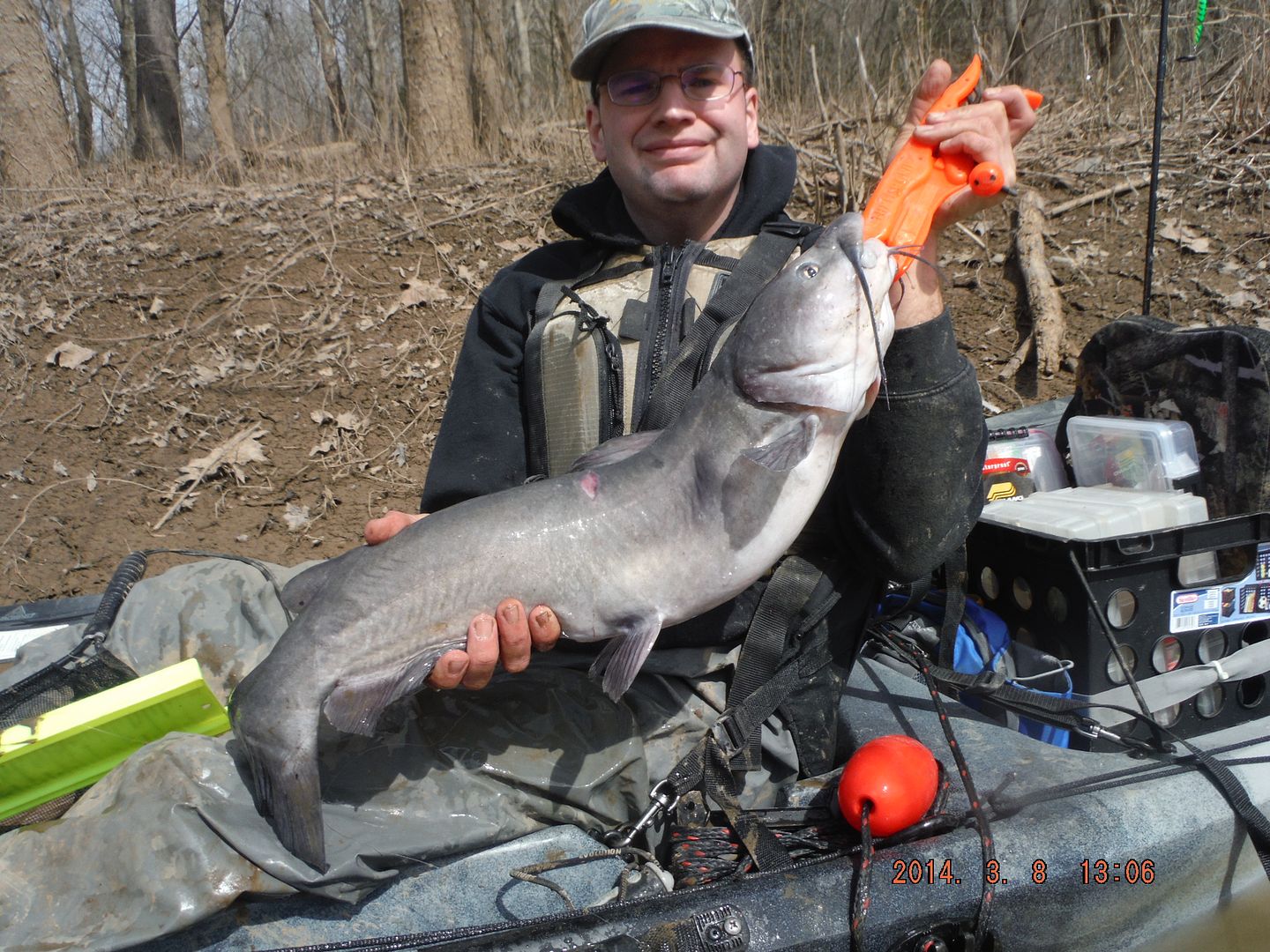 |
| Mike Murphy's 27" Channel Cat, March 8th |
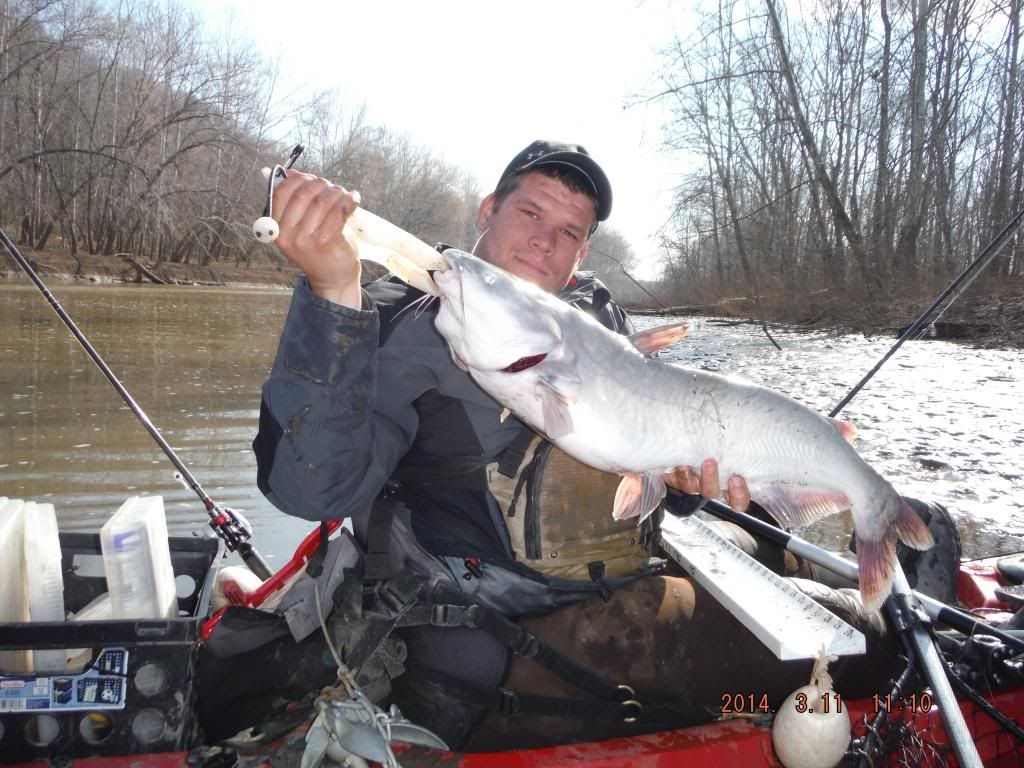 |
| My 31" Blue Catfish, March 11th. |
It was a chunky 26" channel cat, his biggest cat from a kayak to date. Whats interesting is how he said he caught it....he said he was drifting a float 3 feet deep right off of the bank with a piece of liver. At that point I made the switch to a float and worked the opposite bank. Jake had found the pattern for the day, we started catching channel cats left and right. My best guess is that during times of high water the fish vacate the deep portions of the creek which now become swift and move up into the shallow slack water created by the flooding. (Just a guess though) We drifted floats along the banks for nearly 3/4 of a mile of creek before we ran into heavy wind.
The wind was blowing directly up the creek, against the current. This was making it very hard to paddle along with our drifting floats. The profile of the float was small enough to continue drifting downstream, however the larger surface area of my body and the yak were so great that the wind was actually pushing me back against the current. I eventually fell back into old strategies, anchoring on the bank near fallen wood. This time around instead of working the deeper sections of wood I targeted the wood near the bank. We didn't catch fish near as often with this technique but the fish did seem to be a lot larger on average. Here's a shot of my largest fish of the day.....a 26.25" channel cat.
We worked the entire stretch of creek, fighting the wind the entire day. We eventually got to the mouth of the creek and set up on the upstream side of the wing dams. Jake had taken the good side, and quickly landed 2 channel cats over 18" for his kayakwar team. Luckily I caught one channel cat off of my side, I say luckily because he hit the rod that was in my rod holder so hard that he hooked himself. The wind was awful, when we casted we had to intentionally cast 10 yards into the wind in order for our baits to land where we wanted. (Close to the wing dams) The wind was then sweeping our lines against the current and pulling our baits out of position and into snags. Here's a shot of the wind and waves, note the bend in the tree tops and the waves crashing over the wing dams.
Eventually we decided to head back upstream and find some shallow wood that wasn't facing 30 mile per hour winds. We sat around for the next two hours working shallow wood on anchor. I caught an additional 3 kayakwar worthy channel cats before the sunset, giving me a grand total of 9 channel cats over 18" for the trip. (90 points) All in all I'd say we had a pretty good day given the conditions. If Jake hadn't figured the fish out so early the trip would have been much different.
Thursday, March 13, 2014
Kayak Fishing Alliance Forum
Kayak Fishing Alliance Forum
Well it is official, we have released our new forum. During the fall of 2012 Neil had the idea of starting a series of websites, forums, and blogs geared toward the kayak angler....you have seen it unfold over the last few months. To be honest I was hesitant about doing the forum at first, it seemed like a lot of work just to let a few guys talk about kayak fishing. I was already doing the blog and helping with the tournament trail at the time, which was more than enough work to keep me busy when I wasn't able to be on the water. As time progressed and we got hammered with the worst winter that Ohio has seen in decades, lakes and rivers all across Ohio froze solid. Guys started going through withdraws.....and at that point I began to see the need for the forum. Posts on facebook reached 30 and 40 comments, groups chats blew up my phone night and day, and I received somewhere around 20 personal messages a week on the topic of kayak fishing alone. I know there are probably a few of you that just went, pssshhhh....20 personal messages that's nothing. Trust me I know. Since last fall Neil and I have sunk a lot of time and money into this forum in hopes that it will serve a purpose. Here you will be able to say what you want without having to worry about everyone on your facebook page reading it....whether that be your boss learning of how your sick day really went, girlfriend finding out why you had to cancel those dinner plans, wife discovering that you just maxed your credit card on that new kayak, you mom telling you to be careful out there, grandmother making awkward comments, etc. This forum is just for kayak anglers so feel free to take advantage of it....we have designed it for you.
We have general discussion boards, private report forums for moving and flat water, DIY section, Trade a trip section, multiple state sections, kayak tournament forums, just to name a few. Get registered up and check it out.
Well it is official, we have released our new forum. During the fall of 2012 Neil had the idea of starting a series of websites, forums, and blogs geared toward the kayak angler....you have seen it unfold over the last few months. To be honest I was hesitant about doing the forum at first, it seemed like a lot of work just to let a few guys talk about kayak fishing. I was already doing the blog and helping with the tournament trail at the time, which was more than enough work to keep me busy when I wasn't able to be on the water. As time progressed and we got hammered with the worst winter that Ohio has seen in decades, lakes and rivers all across Ohio froze solid. Guys started going through withdraws.....and at that point I began to see the need for the forum. Posts on facebook reached 30 and 40 comments, groups chats blew up my phone night and day, and I received somewhere around 20 personal messages a week on the topic of kayak fishing alone. I know there are probably a few of you that just went, pssshhhh....20 personal messages that's nothing. Trust me I know. Since last fall Neil and I have sunk a lot of time and money into this forum in hopes that it will serve a purpose. Here you will be able to say what you want without having to worry about everyone on your facebook page reading it....whether that be your boss learning of how your sick day really went, girlfriend finding out why you had to cancel those dinner plans, wife discovering that you just maxed your credit card on that new kayak, you mom telling you to be careful out there, grandmother making awkward comments, etc. This forum is just for kayak anglers so feel free to take advantage of it....we have designed it for you.
We have general discussion boards, private report forums for moving and flat water, DIY section, Trade a trip section, multiple state sections, kayak tournament forums, just to name a few. Get registered up and check it out.
Friday, March 7, 2014
3/6: Building Confidence with Todd
Thursday Russ and I hit the Ohio River with our hopes set high. My last trip to the Ohio River yielded nearly two dozen channel cats with two over 25". Given my previous success Russ and I set out to strictly target channel cats. We had our slip rigs, medium heavy bass gear, and our grocery store bait. We unloaded the kayaks, loaded our gear up, and drug the kayaks down to the waters edge. We got on the water around 9:30am and paddled over to check out the "hybrid striper spot" nearby. After 30 minutes without a bite we decided to pull anchor and begin our channel cat adventure. Russ anchored on the east side of the creek just upstream of a log jam, and I anchored on the west side of the creek 20 yards above a small fallen tree. His side of the creek was significantly slower moving than mine, but I had the deeper side.....it was a fair trade. I threaded on a piece of shrimp and tossed a rod out on bottom. I then sat that rod in my rod holder. With the other rod I drifted chunks of chicken liver under a small float. Five minutes later the rod in my rod holder began to bend. I picked the rod up and out of the rod holder and drove the hook deeper into the fishes mouth. After a little burst of drag I managed to pull in the small channel cat. I knew it was close to the magic 18" mark, the length needed to qualify for points on Kayakwars. I turned around and reached for my hawg trough measuring board.....however it wasn't in its usual place. I looked the kayak over and discovered that I had lost my hawg trough. I decided to release the small channel and head back to the car to see if I could find my board somewhere. I made the 150 yard paddle upstream and beched my kayak onto the sandy beach. I then walked the trail back up to the car, where I found my hawg trough laying halfway between the car and the river.
I jumped back into the kayak and headed back down stream. I found the spot on the bank where I had dug my anchor into before and I buried my anchor once again. I tossed my rods back out and awaited another bite....which didn't take long. After a short battle I landed another catfish, this one was slightly larger than my first. I grabbed my measuring board and camera and prepared to take a picture to submit for points. Once I placed the channel cat onto the board it went nuts.......and back to the depths she went. Now here I sat nearly 2 hours into the trip, I've spent nearly 40 minutes searching for my board, lost 20 points for our kayakwars team, and now I'm burning up because I over dressed (and because the paddle upstream was horrible.) . Out of pure frustration I threw my head back and shouted a few profanities. This trip was not starting well.
Russ on the other hand was having a much better beginning to his trip. He had not dropped his board on the trail to the water, he had not lost a fish (yet), and he seemed to be enjoying my shouting and carrying on like a 3 year old. A few minutes later he caught his first fish of the trip, a nice 19.5" hybrid striped bass.
This was big enough to knock Jeff's hybrid striped bass out of the 1rst place Buckeye Kayak Fishing Trails Yak Ohio spot. Russ' trip went south after this point. He missed fish after fish, and not on the hookset either. He would hook up, but he would lose them halfway back to his kayak. I'm pretty sure at one point I heard him scream some not so nice words.......in my head I told myself, "Yep, been there before."
We continued to fish, Russ missing fish after fish, and I landed a small 20" channel here and there. What was weird, was that I started picking up hybrids both on the float and on my bottom rod. They weren't near as large as Russ' hybrid but they weren't small either. This was odd, because the last 2 weeks have produced only a handful of hybrid stripers on liver and shrimp. Just something to think about in the future I guess. Anyway I proceeded to try and fool a few fish into biting. I set up on one spot and tossed my bottom rod out, and then started working a jig with shrimp on the other rod. I quickly got a bite on the rod I was jigging and I set the hook, five seconds later the rod in the rod holder starts to bounce. After a little bit of maneuvering, reeling in this rod and then a little bit on that rod, I pulled two cats into the yak. My first double in the yak, too bad one was a baby.
After I caught these cats the spot seemed to die. I pulled my anchor and then tied off to a limb in the middle of the creek only 10 yards downstream. I tossed a rod out on bottom and set it in the rod holder, I then grabbed my float and started working the current along the banks. On my first drift through I managed to catch a 22" blue cat. Which at the time wasn't significant, but it was worth 10 points for our kayakwars team so I was happy to have it.
Three hours passed before I caught the next significant fish, a 27" blue cat on that bit a chunk of liver on the back side of a fallen tree. It was good enough to snub out my 1rst place Yak Ohio catfish which was currently at 26".
My trip was really starting to shape up, Russ on the other hand was still struggling. He was still missing fish left and right and nothing he tried seemed to help his cause. We continued to work our way downstream, hitting every current obstruction we could find along the way. We got within 20 yards of the mouth of the creek when my phone started to ring. It was Todd one of the founders of Smack Tackle. He had seen a few kayaks up the creek and wanted to know if I was fishing, We spoke for a few minutes and then I told him I'd paddle down and see how he was doing in a little while. Five minutes later I get a picture text message from Todd, it was a hybrid striper in the 20" range. My response was, "One more of those and I'm going to tie off to your boat." As I was putting my phone away I accidentally hit the call button, I immediately hung. A few seconds later he called me back. He made the offer again to come down and fish with him, he also wanted to show me a new prototype he had been using. That was all I needed to hear. I looked over to Russ and said that I was going to head downstream and meet up with Todd to do some hybrid striper fishing. We both tied on a flitterbait and paddled down stream.
I pulled up beside Todd and began to strike up conversation. I told him that I had pretty bad luck with hybrid stripers and that I my personal best was 4lbs and 15oz. During our conversation Todd had hooked into two fish, one of which appeared to be nice. At this point I went into student mode, I started taking notes and asking questions. I watched how he worked his bait, what angles his rod was at, his retrieve, etc. At one point he lost his prototype bait to a snag on bottom.....a snag that I would soon become very familiar with. He began rummaging through his boxes and said he didn't have any flitterbaits. Luckily for him I did. I threw him my box of smack tackle (his baits) and he grabbed the last chartreuse flitterbait 2 I had. At first he didn't want to take it, but I ensured him that I didn't care. (This is all going to seem relevant in a second. ) He went back to work with the flitterbait bouncing it off of the bottom. Thirty minutes later he lifts his rod and then on the drop he feels a tap.....he then set the hook and the tip of the rod didn't budge an inch. He had found the snag again.........and then the drag began to steadily roll. Nope this was certainly not a snag, this was a huge fish. It didn't ever really burn drag, it casually swam up current and then back down current slipping drag only on occasion. Todd kept the rod high and kept steady pressure on the fish. Judging by the fight I was sure he had either hooked into a giant blue cat, larger carp, or foul hooked a smaller fish. The fight went on for a solid five minutes before the fish vacated the general area that he was hooked in. At that point the fish moved out into swifter current and realized he was hooked. He still didn't pull much drag, but he began making cuts back and forth through the current, trying to throw the hook. At one point Todd had it up beside the boat and it partially surfaced. We didn't see much except the giant wake it was putting off and the swirls it was making. However, Todd caught a glimpse of it and said it was silver....which meant it was either a blue cat, an asian carp, or a giant hybrid. We were both hoping it was a hybrid. The fish made its way back out into the current and made its way downstream. After losing 20 yards of line Todd had to pull anchor and chase the fish down. I grabbed onto his boat and drifted along the side of the boat with him, I wasn't missing this for anything. We floated about 150 yards before we got to see the fish for the second time. All along the way we were talking about how big this fish was, and what this fish could possibly be? On its second appearance on the surface we got a positive identification......it was a MONSTER hybrid. I grabbed my net and waited for Todd to swing it over my way. At this point I had no idea how big it really was, I was on one side of the boat in my kayak and Todd was fighting it on the other. Todd then made the move across the transom of the boat where I was waiting with the net. He maneuvered the fish around the motor, and that's when I saw it for the first time. I didn't have time to think about its size.....I had one mission and that was to get it into the net. I leaned as far as I could and Todd guided it right into the net. I lifted the net out of the water partially to ensure the fish couldn't swim out and then looked up at Todd. This was a giant......neither of us could believe it. A nearly 20 minute fight with what we thought was a giant catfish turned out to be a monster hybrid.....a true fish of a lifetime.
It went 14.5lbs and 29". I quickly snapped a few pictures and called over Russ to check it out. Todd went to work reviving the hybrid.
I have used the flitterbait for two years now and have caught dozens, if not hundreds, of fish on them including hybrids, largemouth, smallmouth, drum, crappie, saugeye, and even bluegills. However, I wasn't quite using them how Todd was. The biggest issue I found that I had was in feeling the bites. Todd explained that hybrids are very fast at hitting and spitting a bait back out, so if you don't set the hook that moment when you feel the "tick" you will miss the fish 90 percent of the time. With that in mind I went to work. My lesson was now complete. I had observed the proper techniques for landing hybrid stripers on the flitterbait, and now it was my turn to try my hand at it
I think I did alright.....3 over 22" and all over 5lbs. I even beat my personal best on three separate occasions. The picture above was the heaviest of the bunch at 5lbs 13oz. They weren't the 14 pounder that Todd had caught, but I was just as happy with them. The fish seemed to be in a pretty good mood too, they annihilated my flitterbaits.
I stayed by Todds side for the remainder of the evening, Russ on the other hand had a score to settle with those channel cats back up the creek. Todd had snagged up a gizzard shad earlier, which was more than enough to tempt Russ back into chasing channel cats. He went on to catch three channels over 18" before sunset. I stayed with Todd untill 7:30pm and then decided to call it quits. We had put in nearly 11 hours on the water. The bite had slowed down, it was getting cold, and I was starving.
I wanna thank Mr.Miyagi......uhhh I mean Todd......for the flitterbait 101session and for sharing the good time with me. I probably would have stayed in the creek and chased channel cats all evening long if it weren't for that text. Congratulations again on the giant hybrid.
I jumped back into the kayak and headed back down stream. I found the spot on the bank where I had dug my anchor into before and I buried my anchor once again. I tossed my rods back out and awaited another bite....which didn't take long. After a short battle I landed another catfish, this one was slightly larger than my first. I grabbed my measuring board and camera and prepared to take a picture to submit for points. Once I placed the channel cat onto the board it went nuts.......and back to the depths she went. Now here I sat nearly 2 hours into the trip, I've spent nearly 40 minutes searching for my board, lost 20 points for our kayakwars team, and now I'm burning up because I over dressed (and because the paddle upstream was horrible.) . Out of pure frustration I threw my head back and shouted a few profanities. This trip was not starting well.
Russ on the other hand was having a much better beginning to his trip. He had not dropped his board on the trail to the water, he had not lost a fish (yet), and he seemed to be enjoying my shouting and carrying on like a 3 year old. A few minutes later he caught his first fish of the trip, a nice 19.5" hybrid striped bass.
This was big enough to knock Jeff's hybrid striped bass out of the 1rst place Buckeye Kayak Fishing Trails Yak Ohio spot. Russ' trip went south after this point. He missed fish after fish, and not on the hookset either. He would hook up, but he would lose them halfway back to his kayak. I'm pretty sure at one point I heard him scream some not so nice words.......in my head I told myself, "Yep, been there before."
We continued to fish, Russ missing fish after fish, and I landed a small 20" channel here and there. What was weird, was that I started picking up hybrids both on the float and on my bottom rod. They weren't near as large as Russ' hybrid but they weren't small either. This was odd, because the last 2 weeks have produced only a handful of hybrid stripers on liver and shrimp. Just something to think about in the future I guess. Anyway I proceeded to try and fool a few fish into biting. I set up on one spot and tossed my bottom rod out, and then started working a jig with shrimp on the other rod. I quickly got a bite on the rod I was jigging and I set the hook, five seconds later the rod in the rod holder starts to bounce. After a little bit of maneuvering, reeling in this rod and then a little bit on that rod, I pulled two cats into the yak. My first double in the yak, too bad one was a baby.
After I caught these cats the spot seemed to die. I pulled my anchor and then tied off to a limb in the middle of the creek only 10 yards downstream. I tossed a rod out on bottom and set it in the rod holder, I then grabbed my float and started working the current along the banks. On my first drift through I managed to catch a 22" blue cat. Which at the time wasn't significant, but it was worth 10 points for our kayakwars team so I was happy to have it.
Three hours passed before I caught the next significant fish, a 27" blue cat on that bit a chunk of liver on the back side of a fallen tree. It was good enough to snub out my 1rst place Yak Ohio catfish which was currently at 26".
My trip was really starting to shape up, Russ on the other hand was still struggling. He was still missing fish left and right and nothing he tried seemed to help his cause. We continued to work our way downstream, hitting every current obstruction we could find along the way. We got within 20 yards of the mouth of the creek when my phone started to ring. It was Todd one of the founders of Smack Tackle. He had seen a few kayaks up the creek and wanted to know if I was fishing, We spoke for a few minutes and then I told him I'd paddle down and see how he was doing in a little while. Five minutes later I get a picture text message from Todd, it was a hybrid striper in the 20" range. My response was, "One more of those and I'm going to tie off to your boat." As I was putting my phone away I accidentally hit the call button, I immediately hung. A few seconds later he called me back. He made the offer again to come down and fish with him, he also wanted to show me a new prototype he had been using. That was all I needed to hear. I looked over to Russ and said that I was going to head downstream and meet up with Todd to do some hybrid striper fishing. We both tied on a flitterbait and paddled down stream.
I pulled up beside Todd and began to strike up conversation. I told him that I had pretty bad luck with hybrid stripers and that I my personal best was 4lbs and 15oz. During our conversation Todd had hooked into two fish, one of which appeared to be nice. At this point I went into student mode, I started taking notes and asking questions. I watched how he worked his bait, what angles his rod was at, his retrieve, etc. At one point he lost his prototype bait to a snag on bottom.....a snag that I would soon become very familiar with. He began rummaging through his boxes and said he didn't have any flitterbaits. Luckily for him I did. I threw him my box of smack tackle (his baits) and he grabbed the last chartreuse flitterbait 2 I had. At first he didn't want to take it, but I ensured him that I didn't care. (This is all going to seem relevant in a second. ) He went back to work with the flitterbait bouncing it off of the bottom. Thirty minutes later he lifts his rod and then on the drop he feels a tap.....he then set the hook and the tip of the rod didn't budge an inch. He had found the snag again.........and then the drag began to steadily roll. Nope this was certainly not a snag, this was a huge fish. It didn't ever really burn drag, it casually swam up current and then back down current slipping drag only on occasion. Todd kept the rod high and kept steady pressure on the fish. Judging by the fight I was sure he had either hooked into a giant blue cat, larger carp, or foul hooked a smaller fish. The fight went on for a solid five minutes before the fish vacated the general area that he was hooked in. At that point the fish moved out into swifter current and realized he was hooked. He still didn't pull much drag, but he began making cuts back and forth through the current, trying to throw the hook. At one point Todd had it up beside the boat and it partially surfaced. We didn't see much except the giant wake it was putting off and the swirls it was making. However, Todd caught a glimpse of it and said it was silver....which meant it was either a blue cat, an asian carp, or a giant hybrid. We were both hoping it was a hybrid. The fish made its way back out into the current and made its way downstream. After losing 20 yards of line Todd had to pull anchor and chase the fish down. I grabbed onto his boat and drifted along the side of the boat with him, I wasn't missing this for anything. We floated about 150 yards before we got to see the fish for the second time. All along the way we were talking about how big this fish was, and what this fish could possibly be? On its second appearance on the surface we got a positive identification......it was a MONSTER hybrid. I grabbed my net and waited for Todd to swing it over my way. At this point I had no idea how big it really was, I was on one side of the boat in my kayak and Todd was fighting it on the other. Todd then made the move across the transom of the boat where I was waiting with the net. He maneuvered the fish around the motor, and that's when I saw it for the first time. I didn't have time to think about its size.....I had one mission and that was to get it into the net. I leaned as far as I could and Todd guided it right into the net. I lifted the net out of the water partially to ensure the fish couldn't swim out and then looked up at Todd. This was a giant......neither of us could believe it. A nearly 20 minute fight with what we thought was a giant catfish turned out to be a monster hybrid.....a true fish of a lifetime.
It went 14.5lbs and 29". I quickly snapped a few pictures and called over Russ to check it out. Todd went to work reviving the hybrid.
I have used the flitterbait for two years now and have caught dozens, if not hundreds, of fish on them including hybrids, largemouth, smallmouth, drum, crappie, saugeye, and even bluegills. However, I wasn't quite using them how Todd was. The biggest issue I found that I had was in feeling the bites. Todd explained that hybrids are very fast at hitting and spitting a bait back out, so if you don't set the hook that moment when you feel the "tick" you will miss the fish 90 percent of the time. With that in mind I went to work. My lesson was now complete. I had observed the proper techniques for landing hybrid stripers on the flitterbait, and now it was my turn to try my hand at it
I think I did alright.....3 over 22" and all over 5lbs. I even beat my personal best on three separate occasions. The picture above was the heaviest of the bunch at 5lbs 13oz. They weren't the 14 pounder that Todd had caught, but I was just as happy with them. The fish seemed to be in a pretty good mood too, they annihilated my flitterbaits.
I stayed by Todds side for the remainder of the evening, Russ on the other hand had a score to settle with those channel cats back up the creek. Todd had snagged up a gizzard shad earlier, which was more than enough to tempt Russ back into chasing channel cats. He went on to catch three channels over 18" before sunset. I stayed with Todd untill 7:30pm and then decided to call it quits. We had put in nearly 11 hours on the water. The bite had slowed down, it was getting cold, and I was starving.
I wanna thank Mr.Miyagi......uhhh I mean Todd......for the flitterbait 101session and for sharing the good time with me. I probably would have stayed in the creek and chased channel cats all evening long if it weren't for that text. Congratulations again on the giant hybrid.
Subscribe to:
Posts (Atom)

